.
 WE ENTERED THROUGH THE GATE OF JUSTICE.
WE ENTERED THROUGH THE GATE OF JUSTICE.A TRIP TO THE ORIENT
The Story of a
Mediterranean
Cruise
BY
ROBERT URIE JACOB
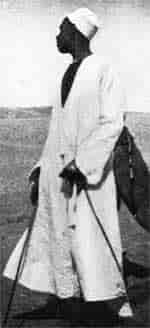
ILLUSTRATED
THE JOHN C. WINSTON CO.
PHILADELPHIA
Copyright 1907, by
Robert Urie Jacob.
Half-tones made by
The Photo-Chromotype Engraving Co.
Philadelphia, Pa.
[Pg iii]
PREFACE.
"A Trip to the Orient, the Story of a Mediterranean Cruise," by Robert Urie Jacob, has been written at the request of fellow-travelers who did not have time to take notes by the way.
One said, "Do not write a guide book nor a love story, but a simple narrative that will recall the incidents and delightful experiences of the tour." Following these suggestions, but with many misgivings, the author has undertaken and completed the work, assisted in the editing and proof-reading by Miss Ruth Collins, of the Drexel Institute, and by Miss Anna C. Kauffman.
An interesting feature of the book is the large number of illustrations made from artistic photographs, all of which have been kindly contributed by amateur photographers. It contains nearly two hundred illustrations of views or incidents in Funchal, Granada, Algiers, Malta, Athens, Constantinople, Jerusalem, Cairo, Luxor, Naples, and Nice, reproduced from photographs taken by Mr. L. O. Smith, Rev. G. B. Burnwood, Mr. Charles Louis Sicarde, Mr. Franklin D. Edmunds, Mr. Roberts LeBoutellier, Mrs. Charles S. Crosman, Miss M. Florence[Pg iv] Pannebaker, Mr. Walter F. Price, Mr. S. L. Schumo, Mr. George C. Darling, Mr. Howard E. Pepper, Mr. John W. Converse, Mr. C. Edwin Webb, and Mr. Edwin Alban Bailey.
The story was intended specially for voyagers who have visited the same places, but it may be almost equally interesting to those who are planning a similar trip. And those who must stay at home may in these pages be able to look through another's eyes at the places described.
If the book should in any slight way deepen the pleasant memories of those who have made the trip, or if it should give pleasure to those who must picture those scenes only in their imagination, the author will feel that his effort has not been in vain.[Pg v]
CONTENTS.
| CHAPTER. | PAGE | |
| I. | On The Ocean | 1 |
| II. | Funchal | 10 |
| III. | Gibraltar | 24 |
| IV. | Granada and the Alhambra | 38 |
| V. | The City of Algiers | 60 |
| VI. | The Island of Malta | 82 |
| VII. | Athens and the Acropolis | 97 |
| VIII. | Constantinople and Santa Sophia | 128 |
| IX. | The Selamlik and the Treasury | 154 |
| X. | From the Bosporus to Palestine | 179 |
| XI. | Jerusalem | 199 |
| XII. | The Church of the Holy Sepulchre | 227[Pg vi] |
| XIII. | Cairo and the Pyramids | 257 |
| XIV. | Luxor and Karnak | 296 |
| XV. | On the Nile | 327 |
| XVI. | Naples and Pompei | 353 |
| XVII. | Nice and Mentone | 378 |
CHAPTER I.
ON THE OCEAN.[Pg 1]
"Have you decided to go?" inquired my friend. Before us on the table lay an illustrated booklet containing the prospectus of a cruise to the Mediterranean. Its contents had been under consideration for some days.
"Yes," I answered, "I will write to-day to secure state room accommodations for our party. Nevertheless I am not quite sure that it is wise to take the trip."
"Why?"
"For two reasons. First, are seventy days long enough to make a cruise of nearly fourteen thousand miles and visit so many places? Second, with five hundred passengers will there not be a crowd?"
"Well, those doubts never troubled me. Seventy days is all that can be spared from my business, and much may be seen in that time. As to the number of passengers, every steamer carries its full complement. At any rate, you are going, so think no more of your doubts. You will probably forget that you had any."
So it was that at seven o'clock on the morning of the fifth of February, when the steamship Moltke left her dock at New York, we stood among the passengers lined along her rail. The hawsers had been cast off, whistles were blowing, and tugs were puffing in their efforts to push and pull the huge vessel into the stream.[Pg 2]
At that early hour of a wintry day there was no crowd filling the pier, no sea of faces looking upward, no waving of handkerchiefs and flags, the usual sight when a great liner departs. The wharf, cheerless and dismal, appeared to be almost deserted. Its only occupants were a few scattered onlookers shivering in the cold, and the officials and employees whose duties required their presence. But on the Moltke, in spite of the chill air and the gray morning, all were animated and eager. The band played the "Belle of New York" while the ship was being warped into the stream, and the "American Patrol" while it was steaming down the river. The tourists, alert and expectant, viewed the panorama of the city as the tall buildings were brought into strong relief against the brightening sky, saw Liberty's cap reflect the rays of the rising sun, then watched the incoming steamers, and the forts and lighthouses that seemed to approach and pass. Just outside of Sandy Hook our pilot with a satchel of letters descended the rope ladder to the waiting tug, and soon afterwards the low-lying shores became dimmer and dimmer until they disappeared from view.
The farewells had been exchanged on the previous day, when the promenade decks and saloons of the steamer were thronged with passengers, friends, and curious visitors, and the after-deck was encumbered with piles of baggage. Then, the tables in the main saloon were filled with boxes of flowers, baskets of fruit, packages of confectionery, and bundles of steamer letters marked to be opened on certain days after sailing.
Before the departure we had met the deck steward[Pg 4] and with his assistance had located our steamer chairs; for in the places then selected the chairs were to remain throughout the long cruise. We had also interviewed the chief steward, had obtained from him a passenger list, and had arranged that our party should be seated together at one of the side tables in the dining saloon.
 AT THE HOUR OF AFTERNOON TEA.
AT THE HOUR OF AFTERNOON TEA.The passenger list contained four hundred and fifty-three names. Among these were thirteen preceded by the title Reverend, thirteen by Doctor, and a number by military or other titles of honor. Every state in the Union and several provinces of Canada had representatives on the list.
During the first three days' sailing a storm, which had been predicted as approaching from the west when we left New York, followed but did not overtake us. We could not, however, remain on deck as long as desired, for the wind was chilly and the ocean rough. But each morning, laden with heavy wraps and rugs, we sought our steamer chairs. Then, settled comfortably under the wraps and rugs carefully tucked around us by the attentive steward, we defied the cold for an hour or two and inhaled the invigorating air.
As the vessel made her way southward, the temperature moderated and the sea became smooth. By the time the stormy weather had passed, the tourists, accustomed to ship motion and ship life, spent most of their time upon the decks. Then, to increase sociability and make the time pass pleasantly, self-appointed committees met and laid plans for card parties, lectures, concerts, and dances.
On the fifth night out the southern side of the prom[Pg 5]enade deck was curtained with awnings, cleared of chairs, decorated with flags and Chinese lanterns, and brilliantly illuminated with clusters of electric lights, for an impromptu dance. Music was furnished by the band, and Father Neptune kindly kept his waves in subjection, although an occasional roll caused some unsteadiness in the movements of the waltzers.
By that time we knew many of our fellow-voyagers. For, as we had similar plans, a common destination, and the same pleasures in anticipation, we readily made friendships. We chatted around the table during the luncheon and dinner hours, took a hand in euchre with men in the smoking room, or a place at whist with the ladies in the music room, and exchanged pleasantries and experiences with our neighbors while occupying the steamer chairs. Friendships grew rapidly under these favorable conditions. Sometimes chats with new acquaintances which began in a mirthful way changed to talks of a serious kind as some spoken word recalled home and friends left behind, and conversations when prolonged became almost confidential in their character.
One afternoon while we were sipping the tea which had been served, a lady who occupied a chair next ours, said:—"I enjoy so much my hours in the gymnasium. Each morning I take a gallop on the electric horse and get my blood into circulation. The first day I felt rather timid in the saddle when the custodian asked, 'Fast or slow?' so I said, 'Start slow,' but I quickly had him increase the speed, for I'm used to horseback riding."
"We're from Texas, you know," spoke up a young woman sitting close by.[Pg 6]
"You should practice riding on the electric camel in preparation for our trip into Egypt," I suggested.
"We have; we've tried all the arm and foot movements and have been thumped on the back, and on the chest, and even on our heads," responded the young woman. "But I wished for a rowing machine. Rowing is my favorite exercise."
"Before we left home we all had many misgivings about this trip," remarked the elder sister. "We knew how large these steamships really are, but yet we had visions of many possible discomforts during so long a journey. We disliked tours in sleeping cars and couldn't realize the difference between traveling in cars and in ships. But our stateroom here is very cozy with the wardrobes and the racks for our books and our pictures."
"And it seems homelike, too," added the other.
The life on shipboard was to many a novel experience. In the mornings we were roused from our slumbers by the notes of a bugle. The first day when the reveille sounded I looked at my watch. It was a quarter to eight. "Must I get up?" I thought. Then remembering that the breakfast hour was from eight to ten, I closed my eyes. But soon there came a gentle tapping at the door. "Who's there?" I asked. "Your bath is ready, sir." The words were English but the accents were plainly German. That call was more imperative than the bugler's, for I might miss my invigorating salt water dip if I did not quickly respond. After a breakfast of fruit, cereals, chops, and coffee we went to the deck for a tramp. "Ten rounds of the promenade deck make[Pg 8] a mile," said my room-mate consulting his pedometer. Then we strolled to the library for books, but the books lay unread in our laps when we were seated in our steamer chairs; for how could our minds be fixed on the story when the real life before us was more interesting? The Professor who was to lecture during the trip stepped by with rapid tread, nodding as he passed. The minister from Iowa who was to preach on the Sabbath stopped to exchange greetings, a friend dropped into a vacant chair for a talk. Then the music stands were set up and the band assembled around them and for an hour we listened to selections from Wagner and Bach, varied with the martial strains of Sousa or the melodies of Foster. The stewards brought out a table, filled it with dishes, and served bouillon and biscuit, while near by a kodak carrier was snapping a picture.
 I. COMFORTABLY SEATED WITH A BOOK.
I. COMFORTABLY SEATED WITH A BOOK. II. THE BAND WAS PLAYING CARMEN.
II. THE BAND WAS PLAYING CARMEN.On the ship there were many places of interest. When in need of exercise we visited the gymnasium on the upper deck, and when desirous of a change in cooking we resorted to the grill room where the white clad cook broiled chops in our sight over a bright fire. Impelled by curiosity, we explored the vacant steerage, and with the chief engineer descended the iron ladder to the depths below to investigate the mysteries of the engine and fire rooms. Sometimes from the breezy fore-deck we scanned the horizon for the ships that rarely appeared, and sometimes sought a snug corner aft and watched the swift-winged gulls, the quivering log line, the smoke clouds and their shadows, or the widening streak of water disturbed by the revolving screw.
"How rapidly the week has passed," said a friend on[Pg 9] the evening of the twelfth of February. "Listen! One, two, three, four," as the ship's bell rang out four strokes. "Four bells, that's six o'clock. We have half an hour to dress for dinner."
When we entered the brilliantly illuminated dining saloon that evening a bust of Lincoln was on the platform, and the room was decorated with the American colors. Some one had remembered Lincoln's birthday, though many of the passengers had forgotten the date. A picture of Lincoln with the inscription, "In commemoration of President Abraham Lincoln's birthday," was engraved on the covers of the souvenir menus. The dinner was an unusually good one, and the seven selections rendered by the orchestra during the courses were appropriate for the day.
After dinner a man who had been personally acquainted with the martyred President delivered an interesting memorial address. His final words had just been said when an announcement was made which caused a thrill of expectancy and sent us hurriedly to the deck: "Land is in sight!"[Pg 10]
CHAPTER II.
FUNCHAL.
"That is the island of Madeira," said the captain, pointing to a dark mass dimly seen against the horizon. "We are now nearly twenty-eight hundred miles southeast of New York."
We had been sailing for seven days with only a vast expanse of ocean in view, and so we longed for a sight of land and eagerly looked forward to the arrival at our first port. As we approached the island the form of a mountain became clear in the star-light; then the twinkling of lights at its base revealed the location of a city. When within half a mile of the shore, the water in the harbor became too shallow for large vessels, so the screw propeller of the Moltke ceased revolving and the ship came to anchor.
"May we go ashore to-night?" many asked.
"Certainly, there is no objection," replied the captain.
A number of the passengers, eager to see the attractions of the place, and too impatient to wait until morning, were rowed across the dark water to the pier. In the city, Funchal, we found that at so late an hour the main attractions were gambling places, dance halls, and lotteries, the owners of which were greedy for American money. The main Casino, in the midst of a beautiful garden, was brilliantly illuminated and its[Pg 12] halls were filled with well dressed people. Some of the party who had placed their silver on the tables of chance showed on their return to the steamer handfuls of coins that fortune had brought them; others who had made similar experiments were silent as to the results.
 SUNLIGHT SHONE ON THE WHITE WALLS OF FUNCHAL.
SUNLIGHT SHONE ON THE WHITE WALLS OF FUNCHAL."We should have read up the Madeiras before leaving home," said one of the tourists at our early breakfast the morning after our arrival, "but we were too busy then with other things. While you were ashore last night I found in the library an old English book of travel that gave some information about the islands."
 IT IS NOT RAPID TRANSIT.
IT IS NOT RAPID TRANSIT."Share it with us while the stewards are bringing the coffee, won't you?"[Pg 13]
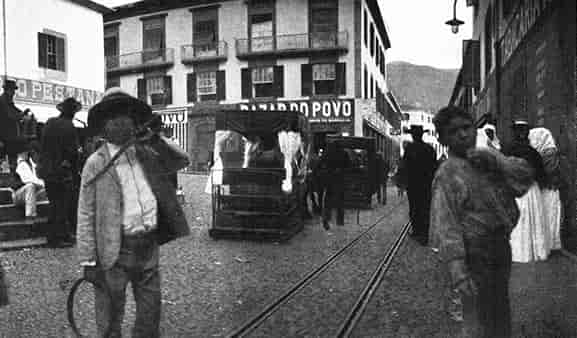 ONLY THE BOYS STOPPED THEIR PLAY TO GAZE.
ONLY THE BOYS STOPPED THEIR PLAY TO GAZE."I made very few notes," she replied. "As we are to be in Funchal but one day, I skipped the statistics of population, hotels, exports, and history. But here are some facts just as I jotted them down:
"'The Madeira Islands, about six hundred miles west of Gibraltar, were settled by the Portuguese and are owned by Portugal.
"'The principal and only town large enough to be called a city is Funchal, situated on the southern side of Madeira on the slope of a hill.
"'The city has an equable climate. Mild sunshine, gentle ocean breezes, and protection from harsh winds by mountains, give to Funchal throughout the whole year the temperature of England in the month of May.
"'The island is very mountainous, gashed with many deep gorges which extend in from the sea. The streets in the city are paved, but the roads in the country are impassable for wagons. Merchandise is carried on pack mules or in ox-drags. Horses are rarely seen and carriages are few. Quaint vehicles are used in their stead for the conveyance of passengers.'
"How odd these vehicles are we shall find out when we land. We shall have a busy day. I am eager to start."
It was yet early when we ascended the deck, but the sun was shining brightly. Funchal appeared like a beautiful picture. Overhead was the azure sky of a summer day; before us, stirred by a gentle breeze, glistened in blue and silver the waters of the harbor; on the curving shore, tier above tier, reflecting the sunshine, rose the white and yellow stone buildings of the[Pg 15] city surmounted by roofs of red tiling; above the city, white cottages amidst a dense foliage of green shrubbery dotted the steep hillsides, and beyond, but seeming very near, higher mountains formed a dark and appropriate background.
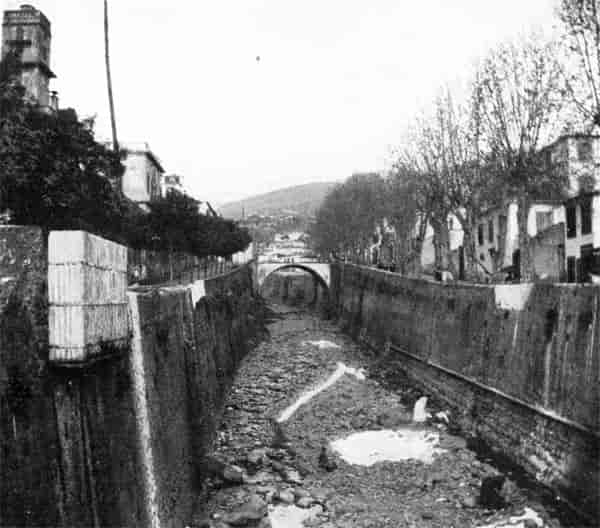 THE WOMEN WERE WASHING CLOTHES.
THE WOMEN WERE WASHING CLOTHES."The steam tenders are ready to carry you to the shore," announced one of the officials, interrupting our survey of the picture.
We descended the long ladder of fifty steps from the deck of the steamer to the bobbing barge in the water[Pg 16] below, and were soon landed on the stone steps of the breakwater, which, extending out to a picturesque crag, protects and partially encloses the harbor. There, in place of cabs, a hundred low sleds with canopy tops and cushioned seats were in readiness to convey us on a sight-seeing excursion through the city. This ride in ox-drags was a novel experience. Each sled was dragged by two bullocks, driven without reins by loud-voiced natives who, with frequent yells and prodding sticks, urged on their teams. The drivers carried bunches of greasy rags which they occasionally threw underneath[Pg 17] the sled-runners as a lubricant to diminish the friction of their movement over the stone-paved streets.
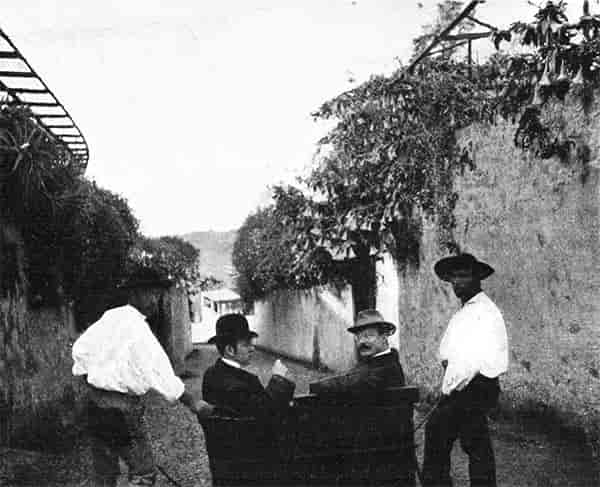 IN THE SLED READY TO START.
IN THE SLED READY TO START.The sights in the city were strange. The shops on the narrow streets were plain and unattractive, and the signs unintelligible. The windows of the lower floors of the dwellings were grated with iron bars like a prison. Beneath a bridge over a walled ravine that kept a rushing stream within bounds in the rainy season, women washed clothes and spread them on rocks to dry. In the public square the women carrying water from the fountain or chatting on the sidewalks appeared to have little curiosity regarding the visitors in their city, and the men, lounging on the steps of the fountain, cast but careless glances in our direction; only the boys stopped their play to gaze awhile at the passing strangers.
"This plodding team seems fitting in such a peculiar place," remarked one of the quartet in our sled. "Although it is not rapid transit, it is comfortable. But look, there is a more luxurious mode of traveling." As he spoke he pointed to two Portuguese bearing suspended on a pole a handsome hammock in which a lady reclined languidly.
At the foot of the mountain we changed from the slowly moving sleds to the car of a cog-wheel railway, which carried us up the steep incline. The speed of the car was not much greater than that of the ox-team. As we ascended, scenes of beauty opened around us. Cottages built on terraces were covered with blooming bouguain-villea or climbing roses. Patches of cultivated land were filled with sugar cane, banana plants, and orange trees. Palms and cacti appeared in many varieties.[Pg 18] Flowers bloomed on every side. Geraniums, fuschias, and heliotropes were of enormous size. Camelias, lilies, and nasturtiums grew in profusion. Children from the suburban cottages ran alongside the moving car, merrily casting roses, heliotropes, geraniums, and camelias through the open windows into our laps, and the tourists, pleased with the floral offerings, in return tossed pennies to the running children.
When we alighted from the car, young peddlers, some bright-faced and clean, others ugly and dirty, offered flowers and trinkets for sale and beggars asked for money. But our pennies were exhausted and we were glad that peddlers and paupers were not permitted to follow us into the hotel grounds.
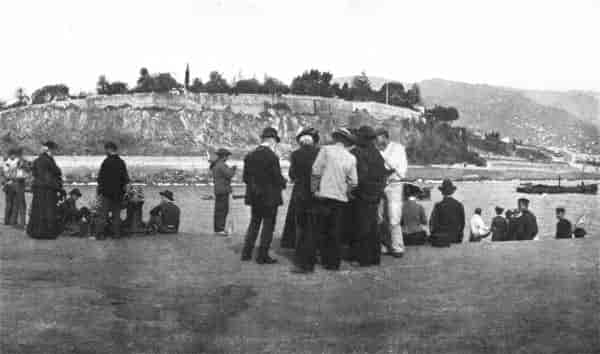 ON THE PIER WE BOUGHT FLOWERS.
ON THE PIER WE BOUGHT FLOWERS."Here you may lunch," said the guide, as we entered a hotel on the mountain, "and get pure Madeira wine. The wine which is made in this island was at one time its most noted production; but some thirty years ago insects and disease so infested the vines that many vineyards were destroyed and the quantity of wine now made is not so large as in former years."
After having luncheon and tasting the well known wine in its purity on a broad piazza overlooking a beautiful tropical garden, we wandered through an interesting old church and convent near by, and then strolled around a mountain pathway from which, as the guide said, "views most grand" might be seen. As we advanced on our way we looked down from the height upon many continually changing scenes of picturesque beauty. Now there appeared a vista through a wooded ravine of striking grandeur, now a view of a rocky[Pg 20] gorge penetrating from the ocean, and again a wide panorama of city, harbor, and ocean.
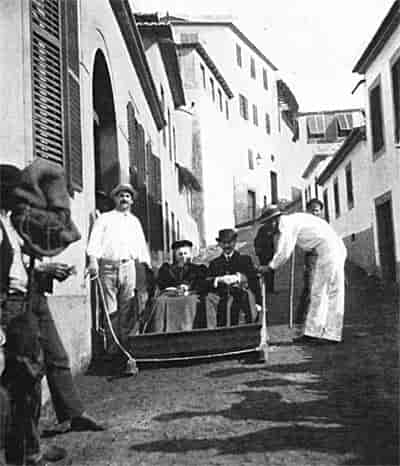 THE SLIDE IS TWO MILES IN LENGTH
THE SLIDE IS TWO MILES IN LENGTHOur return to the city was in a conveyance indeed unique. The descent of the mountain in sleds from the[Pg 21] summit to the city below, through narrow lanes paved with small stones worn and slippery from years of service, was an experience long to be remembered. Our sled, without any means of propulsion but our own weight, glided rapidly down the hill over the smooth surface of the pavement like a toboggan on an icy slide. It was controlled by two men, who, sometimes running alongside, sometimes clinging to the runners, regulated the speed and guided the sled around corners by means of ropes attached to its sides.
"That was a wild and exciting ride," exclaimed one of the ladies who had been tightly holding to her seat during the descent. "What is the distance from the summit?"
"The slide is about two miles in length, lady," replied one of the conductors.
"Don't take our picture now with our hair flying wildly," exclaimed an occupant of a sled just arriving, to a friend with a camera.
"Your request comes too late," he answered. "I have pressed the button."
"I hope it will not be a good one," she wished, but it was.
When we returned to the Moltke many row-boats were clustered around the vessel. Some of these had brought visitors who desired to inspect the ship. Some contained Portuguese merchants, who, with cargoes of embroidery, wicker chairs, straw goods, fruits, photographs, and curios, had been patiently awaiting our return. When they were permitted to come on board they displayed their wares upon the deck and made many sales. Other[Pg 22] small craft contained half-naked boys who shouted to us to test their skill as divers by throwing pennies into the clear but deep emerald water, claiming that they could secure the money before it reached the bottom of the bay. We complied with the boys' request and exhausted the ship's supply of pennies in putting their dexterity to the proof. When the money was thrown into the sea the young experts, diving like beavers and successful in securing the money, rose to the surface and clambered into the boats holding the coins in their mouths. One youth more daring than the others mounted to the upper deck of our steamer and offered, if a shilling instead of a penny was thrown into the water, to plunge from his high perch to the sea fifty feet below and get the silver. And he won much applause by successfully accomplishing the feat.
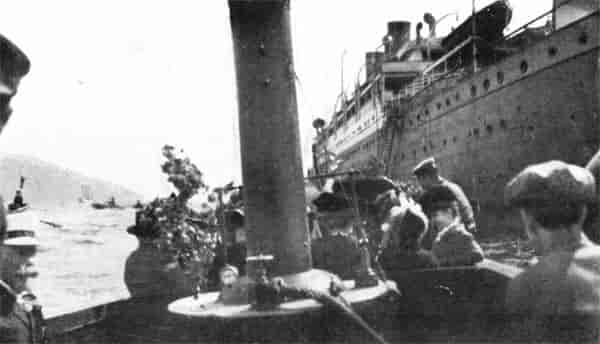 THE TUG CARRIED US TO THE MOLTKE.
THE TUG CARRIED US TO THE MOLTKE.Toward evening the whistle of the steamer sounded warning notes. The time for sailing was at hand. The tourists who had been loitering on the shore hastened to return. The peddlers on the deck reluctantly packed their unsold wares and with their bundles descended the ship's ladder. The visitors, after courteously bidding adieu to the officials who had been entertaining them, took their departure. But the trained swimmers whose antics in the water were giving so much amusement tarried until ordered away. Then while our band played a farewell air, Sousa's "Hands Across the Sea," the Moltke slowly steamed out of the harbor.[Pg 24]
CHAPTER III.
GIBRALTAR.
"Is not this a German vessel?" asked a passenger of the first officer, as they stood conversing near the gymnasium on the upper deck the morning after we left Funchal.
"Most surely it is," he replied, astonished at the question.
"Then," pointing to the red ensign floating at the top of the foremast, "why does the Moltke fly the British colors?"
"The British flag at our foremast indicates that this ship is bound for a port that belongs to Great Britain," explained the mate. "When we sail from Gibraltar the Union Jack will be replaced by the French tri-color to show that we are then on the way to a French port. The emblem on the fore-mast will be changed many times before we return to New York. But there," turning and pointing to the rear, "in its place at the stern is the German standard, the flag of our fatherland. There it will remain throughout the cruise. Above us, too, on the mast nearest the stern, the white pennant bearing the letters H. A. P. A. G., the insignia of the company that owns the Moltke, will constantly fly."
The evening we sailed from Funchal each lady found beside her plate at the dinner table a bunch of violets, a memento from the flower gardens of Madeira; and[Pg 26] on St. Valentine's Day each found there a package containing a pretty fan with the compliments of the Captain. At this dinner on the fourteenth of February much merriment prevailed during the dessert course, when favors containing caps and bonnets were distributed. Formality was dropped for the time. Each diner donned his headgear and the comical appearance of the wearers drew forth many pleasantries and much laughter.
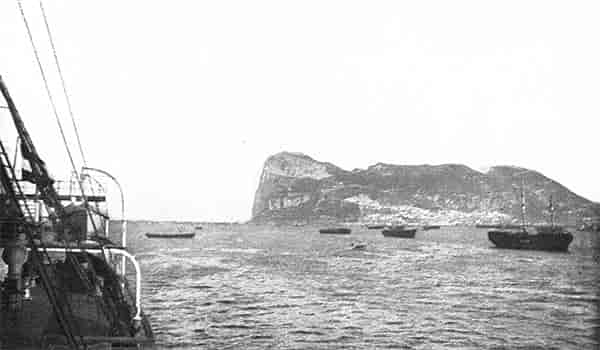 THE ILLUSTRATIONS REPRESENT A SOMBER MOUNTAIN.
THE ILLUSTRATIONS REPRESENT A SOMBER MOUNTAIN.The Captain, with a huge paper sun-bonnet on his head, rose to make a few remarks.
"Silence! listen to what our old mother has to say!" cried a humorist.
Amid laughter the captain began, but the laughter quickly ceased and his words were listened to with attention.
"Fellow voyagers," said he in conclusion, "you will find on the bulletin board to-night some information and advice relative to your trip to Granada. For the past ten days you have been under my charge and I have looked after your welfare, but to-morrow you leave the vessel for two days. I wish you a pleasant excursion and a safe return to shelter under the care of your 'Old Mother.'"
After the applause had subsided and a response had been made by one of the passengers, the orchestra played as a finale Liebe's "Auf Wiedersehen."
Then we, after securing pencil and paper, hastened to join the crowd around the bulletin board to make notes of the directions for the trip into Spain. The notice read as follows:[Pg 27]
"The Moltke will arrive at Gibraltar to-morrow, February fifteenth, before daylight. Breakfast will be served at an early hour and tenders will be alongside the steamer at seven o'clock to take the tourists to the dock. There guides will be in waiting and three hours will be spent in Gibraltar.
"At ten o'clock the tourists will be conveyed in the steam ferry across the bay to the railroad station at Algeciras, from which place the train will start for Granada. During the ferry passage a box containing luncheon to be eaten on the train will be given to each person.
"Dress warmly or take heavy wraps, as it is sometimes cold at Granada at this season of the year.
"Call at the office at the news-stand on main deck for railroad tickets and hotel assignments.
"The excursion party returning will leave Granada at four o'clock Monday afternoon and arrive at the steamer about midnight. The Moltke will then sail for Algiers."
"Let us go to the office at once. The giving out of tickets may require considerable time," said my room-mate.
Others were of the same opinion, it seemed, for many were ahead of us, but there was no delay, each applicant receiving promptly with his railroad ticket a card bearing the name of the hotel in Granada to which he was assigned. The managers of the tour, having arranged in advance for the required number of rooms at the principal hotels, were prepared to make the allotment before leaving the vessel, so avoiding confusion and[Pg 28] delay on our arrival at our destination, and securing for us prompt attention at the hotels.
Some of our friends who had already received their envelopes rejoiced to see on their cards "Hotel Washington Irving," a hotel which they knew from description to be beautifully situated on the heights near the Alhambra.
"Hotel Victoria," I read on mine. I was disappointed at first, but on the following day I found that the central location of the "Victoria" gave opportunities to see much of the life of the city that might have been missed had the assignment been to the hotel in the suburbs.
When we awoke the next morning the Moltke was lying quietly at anchor. We hastily dressed and ascended to the deck.
Any one who has seen pictures of the huge rock that guards the entrance to the Mediterranean will recognize Gibraltar at sight if he approaches the rock from the right point of view. The illustrations, however, represent a somber mountain. The picture we saw showed white houses, red roofs, green trees, patches of lawn, groups of shrubbery, and plots of flowers, all contrasting with gray rocks; these with blue sky overhead, and white sails in the foreground gave life and color to the scene.
As we gazed for some time from the vessel's deck at the strong fortress which has been held securely in the grasp of Great Britain for two hundred years, we thought of the many unsuccessful attempts that have been made during those two centuries to wrest it from [Pg 30]British control; most noted of all, the long siege by the French and Spanish forces that continued for four years when Napoleon was supreme in France. What might have been the result, if England's grasp on the rock had been broken by Napoleon; or what the outcome, if Napoleon's fleet had been victorious in the conflict on the near-by Trafalgar Bay!
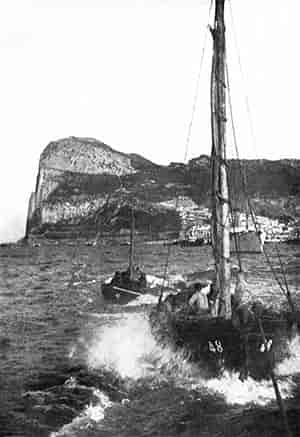 THE ROCK HAD A PEACEFUL LOOK.
THE ROCK HAD A PEACEFUL LOOK.The rock had a peaceful look, but we knew that the cactus plants, which grew rank on the slope of the mountain, concealed powerful batteries, and that on the summit of the rock were mounted cannons of the largest calibre, which, if required, could hurl projectiles to the far side of the strait, a distance of twelve miles.
On one of the highest points of the rock stands the Signal Tower. To this tower the officers of the Moltke had signaled the news of our arrival when the steamer entered the harbor, and before we had stirred from our berths, that information had been flashed over the cable to London and New York. On the following morning our friends at home read in the shipping news of their daily paper, the following item:
"Arrived out; Feb. 15, Gibraltar, Moltke, from New York."
As we started ashore on the lighters at the early hour appointed, we realized that we should have to take in a great deal in a very little while. We entered the city of Gibraltar by a tunnel-like entrance through walls of great thickness. The gateway was closely guarded by sentinels, who demanded the passes with which we had been furnished and who told us that these would be good only until sunset, for at the firing of the evening[Pg 31] gun each day the gates are closed and the passes then are useless.
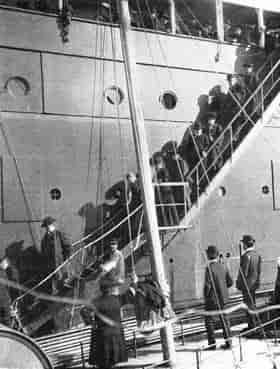 WE DESCENDED A LONG LADDER OF FIFTY STEPS.
WE DESCENDED A LONG LADDER OF FIFTY STEPS.The markets near the gates, where many kinds of fruits, vegetables, and fish, unlike those seen in our home markets, were offered for sale, first attracted our attention. Here customers carrying oddly shaped baskets were bargaining with Moorish fishermen, Jewish peddlers, and Spanish marketmen. Each dealer, with gesticulations and loud voice, appeared to be asserting the superiority of his own wares. There was a confusion of tongues. Only the pigs tied to stakes squealed, and the chickens in wicker crates crowed, in strains familiar to our ears. The streets through which we proceeded were clean but narrow. The sidewalks were only wide enough for two people to walk side by side. The buildings were constructed of gray limestone similar to that of which the great Rock is composed.
The presence of an army in this stronghold was indicated by the large number of soldiers we met. An officer whom we questioned kindly told us that the garrison consisted of about six thousand men, and that provisions sufficient to feed that number for five years in case of siege were at all times kept in storage. He advised us to visit the "Lower Galleries" of the fortifications on the heights and obtain the view from that point, and then to attend the afternoon band concert in the park. But our limited stay did not permit us to follow his suggestions.
"In some respects," said the Major, "Gibraltar is rather a dull post for the officers stationed here; but we have a large library, billiard and club rooms, courts for tennis, and ground for polo. We have also many[Pg 34] dances and riding parties, and occasionally attend the Spanish bull fights which take place in the large bull ring across the bay at Algeciras."
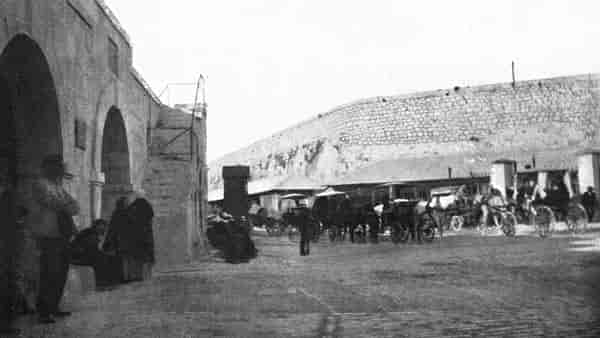 WALLS OF GREAT THICKNESS AND A TUNNEL-LIKE ENTRANCE.
WALLS OF GREAT THICKNESS AND A TUNNEL-LIKE ENTRANCE.The great variety of uniforms worn by the soldiers of England was particularly noticeable. We saw squads in khaki uniforms carrying quarters of beef toward the barrack buildings on the hill; a detachment in Scotch kilts marching to relieve the guards on sentinel duty at the neutral ground; many smart looking corporals and sergeants in short red jackets and little red caps placed jauntily on the sides of their heads, carrying short canes; an elderly looking officer in spotless white flannel, to whom the military salute was given by all soldiers who passed him; numbers of officers in red coats and white duck trousers; and a group of troopers in undress uniform of coarse white or grey, who had been grooming the horses in the stables.
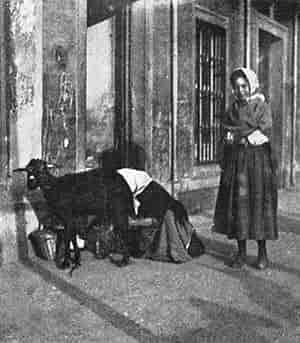 THERE IS A LITTLE MILK-MAID SERVING MILK.
THERE IS A LITTLE MILK-MAID SERVING MILK.Other things of interest that the camera of our eyes[Pg 35] snapped as we hurried along, were yellow-slippered, bare-legged, swarthy Arabs gliding quietly by; a neat grey-gowned nurse taking two pretty English children to early service; Spaniards in long black cloaks and felt hats drawn down, who looked exactly like the conspirators we see in a play; many sailors in the garb of various nations, who appeared to be enjoying a holiday ashore; Hebrew residents in peculiar looking coarse costumes; well dressed English people with prayer books on their way to church; Moors from Tangiers in snow-white turbans, and black-haired Spanish señoritas with large pompadours, high combs, and mantillas draped gracefully over their heads. These, with many others, met our sight; but, among all the crowd we encountered, we were not approached by a beggar, the soliciting of alms being forbidden by the military authorities.
We paused to glance at the little Trafalgar cemetery, but did not enter.
"Here," said the English guide, "sleep many of the British heroes who with our gallant Nelson gave their lives to gain the famous naval victory of the Bay of Trafalgar, in which the French and Spanish fleets were destroyed. Bonaparte boasted that the combined navies of the two countries would crush our British fleet, and then his army would cross the channel and camp in London; but our brave Admiral upset Napoleon's plans."
Beyond the cemetery we crossed the Alameda or Park Gardens, the pleasure ground of the people, where the military band plays in the afternoon and evening.[Pg 36] There we saw a luxuriant growth of subtropical vegetation, orange trees with leaves of dark, glossy green, date palms with bunches of unripe dates, palms with broad leaves, spreading pepper trees, and great ash trees whose roots protruded above the ground for unwary tourists to stumble over. The geraniums and heliotropes were of gigantic size, and many other flowering plants were unusually large.
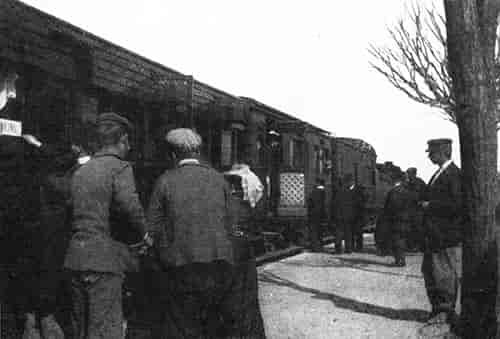 EACH COMPARTMENT SEATS EIGHT.
EACH COMPARTMENT SEATS EIGHT.Our guide persuaded us to enter a museum, as he called it; but this proved to be a regular old curiosity shop containing a large assortment of oddities and souvenirs with which the owner was willing to part for a sufficient compensation.[Pg 37]
"There is a little milkmaid serving milk. I'll take a snap-shot of her while she is at work," said one of our party with a camera as we drew near a young girl who was drawing milk directly from a brown-haired goat into a customer's pitcher.
While returning to the wharf we met several herds of the brown-haired goats driven by milkmen through the streets; and, assembled near the dock around a group of English Salvation Army lads and lasses who were singing familiar hymns accompanied by cornet and drum, we saw a motley crowd of men, many of whom from their diverse and peculiar costumes were evidently sailors from various ports of the world. Then, having completed our hurried tramp through the city in the time allotted for that purpose, we descended the steps at the pier to the ferry-boat that was to carry us a few miles across the bay to the town of Algeciras.
After thirty minutes on the ferry we stepped ashore on Spanish soil. The first special train had departed and the second was being made up. During the short interval of waiting, the kodak carriers were busily engaged securing their first Spanish views.[Pg 38]
CHAPTER IV.
GRANADA AND THE ALHAMBRA.
The small cars on the railroad which carried us from Algeciras to Granada were divided into compartments with doors opening from the sides. Each compartment comfortably seated eight persons, four facing the front and four the rear. This arrangement of seating allows general conversation among the group, and, if the occupants are congenial, promotes sociability.
A traveler speeding through the United States in a "Chicago Limited," at the rate of sixty miles an hour, can merely catch glimpses of objects on the way and receive only blurred and indistinct impressions of the scenery; but when traveling in the "Spanish Express," at the more moderate speed of twenty-five miles an hour, he can enjoy clear and vivid pictures of the unfolding panorama. Let me try to describe some of these pictures just as they appeared to us during the trip.
Looking back after leaving Algeciras, we saw the huge rock of Gibraltar, almost an island, connected with the main land by a narrow, flat, sandy isthmus. Across the "neutral ground," as the strip between the English and Spanish possessions is called, a line of sentry boxes extended, and red-coated British sentinels paced back and forth. Parallel to the British line there was another[Pg 40] line of sentry boxes, where the soldiers of Alfonzo were on guard to prevent the smuggling of tobacco and other forbidden wares into Spain.
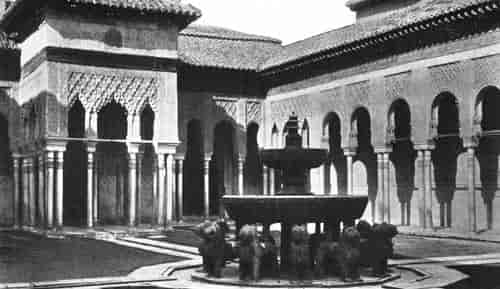 TWELVE WEATHER BEATEN MARBLE LIONS UPHOLD AN ALABASTER BASIN.
TWELVE WEATHER BEATEN MARBLE LIONS UPHOLD AN ALABASTER BASIN."See those miserable little white plastered huts with roofs made of straw," said one of our party. "I did not know that the people were so poor."
This picture of poverty was our first impression of Spain. For some distance the train had been running through a region apparently unfertile, where fences of sharp spined cacti enclosed small fields. The people were shabbily dressed, the houses straw-thatched and dilapidated, and the little patches of land poorly cultivated. It seemed that Sunday was a common wash-day; for at almost every cottage the family wash was hanging in the sun on trees, shrubs, or cacti.
Within an hour, however, we were passing through a section of the country entirely different in aspect, where the cork industry gives employment to many people. For a distance of eight or ten miles groves of cork-oak trees were in sight. At the station were bulky piles of cork bark, cars stacked with cork were on the sidings, and great carts drawn by oxen were on the roads bringing in still more of this valuable commodity.
"Millions of bottles are made in our city," said a New Jersey girl, "and there is enough cork here in sight to stopper them all."
Beyond this, the land was more fertile and under better cultivation. Well built stone houses replaced the huts; glossy-leaved orange trees and pink-blossomed almond trees dotted the fields or filled the orchards. Instead of fences, the boundaries of fields and farms[Pg 41] were marked at the corners by white stones projecting above the ground. Farther along, yellow-green olive plantations, magnificent in size and beautiful in color, filling the valleys and hillsides as far as the eye could see with orderly, far-reaching lines of trees, made so impressive a sight that it drew forth many expressions of admiration.
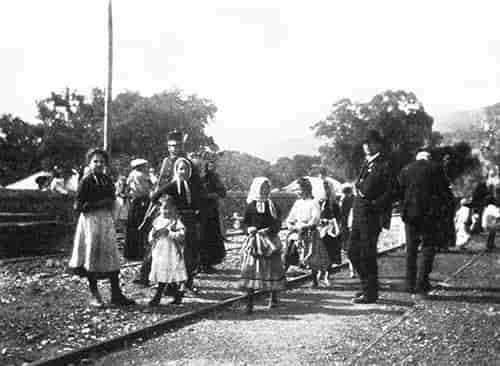 SPANISH CHILDREN CAME TO THE STATION.
SPANISH CHILDREN CAME TO THE STATION.Women, as gatekeepers, waved white flags to signal that the crossings were clear. Gangs of men, often thirty in a gang, were in the fields cultivating leeks or onions with crude, heavy-looking, short-handled hoes. Teams of long-horned oxen attached to old-fashioned plows, at times eight or ten teams in one field, were[Pg 42] turning up the soil. Occasionally ox-teams drawing heavily laden carts or wagons were seen along the smooth white roads; but more frequently appeared trains of slowly moving donkeys, five or six in a line, with gay trappings and bells and panniers piled high with produce, driven by red-sashed muleteers.
At stations where the train stopped five or ten minutes, the doors at the sides of the compartments were opened and the passengers descended and walked up and down the platform. Spanish women, carrying jugs, cried "Lacte," "Limonada," "Narrandjada," and "Acqua," and other peddlers with baskets offered "bollos," "tortitas," and "narranges." After some difficulties in obtaining information as to "how much," the shillings and pence, pesetas and centimes of the tourists were exchanged for the milk, lemonade, orangeade, and water, the cakes, rolls, and oranges of the dealers.
One of the ladies, after making a purchase, said, "I asked that woman with the black-eyed baby the price of a half dozen oranges. She said, 'Fifty centimes.' Then I offered her an English six-pence, and she gave me six oranges and a penny in change."
Spanish boys scrambled for a roll or boiled eggs thrown to them, and men, women, and children extended their hands for money or remnants of our luncheon. One boy who had secured an apple and an egg in a scramble laughed with happiness over his success. These people did not appear to be destitute; for children, as well as adults, were comfortably clothed, and wore neat looking shoes and stockings. As the day, however, was Sunday, probably they were in holiday attire.[Pg 43]
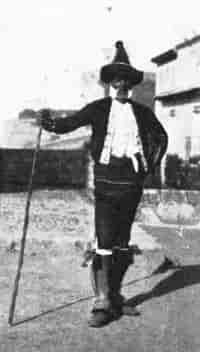 "MAY WE KODAK YOU?" "THEY ALL DO," HE REPLIED.
"MAY WE KODAK YOU?" "THEY ALL DO," HE REPLIED.The red-capped station masters were important personages. At the principal stations they directed the starting of the trains with the greatest care and deliberation. In our own country the conductor's hand touches the signal-cord and the train moves. At Ronda, a bell in the station rang, then a red-capped employee trotted along the length of the train ringing a hand dinner bell. A minute later he repeated his trip with warning bell, then the whistle tooted, but it was not until the red-cap was sure that every passenger was aboard that the whistle issued a second toot and the wheels began to revolve. These extraordinary precautions, although affording amusement for the tourists, may have been taken under special orders of the railroad officials in order to avoid accidents and insure our safety. At any rate, we know that the railroad officials and their Spanish employees did give us special attention and treat us with kindness and courtesy.
Through many deep cuts and tunnels, over romantic gorges of dark depth, and along cliffs whose heights we could not see, the train climbed and crossed a[Pg 44] mountain range. As the car emerged from tunnel or cut, changing scenes of wild and savage landscape appeared near by, and charming glimpses of distant valleys far below. The torrents and waterfalls of the river Gaudiara added to the weird beauty of the scene. A stanza in Southey's poem, "The Cataract of Lodore," fittingly describes the wildness of the river that we crossed and re-crossed so often:
A famous canyon, deep and narrow, with rushing, foaming stream, seemed like a crevice sliced down by a gigantic blade. Towns and villages far away amid green fields and gray olive orchards, and buildings of white and cream, luminous in the sunlight, with backgrounds of dark and rugged mountains, produced a succession of picturesque views. Among the hills were seen young Davids, staff in hand, guarding flocks of grazing sheep, ancient swineherds lazily watching droves of swine feeding on the roots, and goatherds following their nimble-footed brown herds as they picked their way among the rocks.
As we approached our destination, the valleys showed signs of great prosperity. The fields were highly cultivated; the farms were irrigated by ditches of flowing[Pg 46] water; the orchards were well trimmed; the buildings larger; and the red-sashed laborers more sprucely attired.
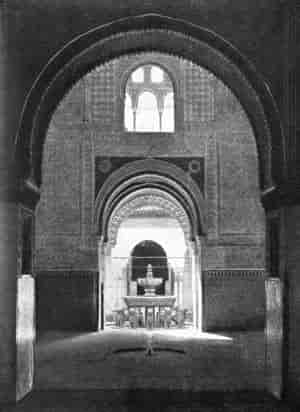 MARVELOUSLY BEAUTIFUL IN MOORISH SPLENDOUR.
MARVELOUSLY BEAUTIFUL IN MOORISH SPLENDOUR.At Pinos we saw the stone bridge where, in 1492, Columbus, on his way to France, disheartened by his failure to interest King Ferdinand in his plans, was over-taken by Queen Isabella's messenger and summoned back to court to receive his commission.
As twilight was settling down we arrived on schedule time at the white stone station in Granada where carriages stood in waiting to convey us to the hotels. The Spanish drivers strove to surpass each other in speed. Our coachman lashed his horses till they ran like a run-away team. Regardless of anyone in the streets, grazing wagons by the way, overtaking and passing carriages ahead, he gave us the wildest ride we had ever taken. This chariot race to the hotel, a distance of over a mile, happily ended without accident or collision.
"Well, I'm thankful that ride is over without an upset," exclaimed with a sigh of relief a nervous lady, who had tried ineffectually to restrain the driver's zeal by the use of English words which he did not understand.
The old Cathedral, covering ground equal to a block in length and half a block in width, always attracts many visitors. Massive pillars support the roof and marble tiles cover the floor. The light, falling softly through stained glass windows, discloses valuable paintings on the walls, fine statuary in the aisles, and decorations of white and gold.
"Is this building very old?" some one inquired.[Pg 47]
"Old!" replied the guide with scorn in his voice, "this Cathedral was here when Columbus discovered your country." The guide, however, exaggerated somewhat. It was built just about the time America was discovered.
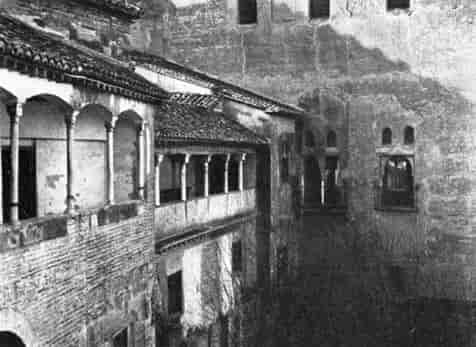 HERE WASHINGTON IRVING LIVED FOR A TIME.
HERE WASHINGTON IRVING LIVED FOR A TIME.In the Royal Chapel of the Cathedral, upon an alabaster mausoleum decorated with fine carving, lie the effigies of Ferdinand and Isabella. The soft, creamy alabaster gives them the appearance of sleeping. An inscription on the tomb reads as follows:
This chapel was founded by most Catholic Don Fernando and Dona Isable, King and Queen of Spain, of Naples, of Sicily, of Jerusalem, who conquered this kingdom and brought it back[Pg 48] to our Faith; who acquired the Canary Isles and the Indies; who crushed heresy, and expelled the Moors and Jews from these realms.
Queen Dona Isable died Nov. 26, 1504.
King Don Fernando died Jan. 23, 1516.
On the altar of the chapel is a very interesting bas-relief representing the surrender of the city of Granada. In the sacristy we were shown the carefully guarded holy relics; the richly embroidered vestments used on ceremonial occasions, the sword of Ferdinand; the sceptre, crown, and mirror of Isabella; and the casket which contained the jewels that the Queen offered in pledge to secure funds for Columbus.
"Most precious of all the relics," said the sacristan, "is the handkerchief with which the blessed Santa Veronica wiped the sweat from the Savior's brow on the road to Calvary. This bears the impression of the Savior's face."
The greatest point of interest in Granada, perhaps in all Spain, is, of course, the Alhambra. This is the name given to a collection of buildings located on an elevation that overlooks the city. These palaces on the heights were for many centuries the dwelling places of the Moorish kings, surrounded by their nobles, retainers, and guardsmen. They were also the repositories in which were stored the immense treasure accumulated from the forays of the Moors upon the Christians of northern Spain, and from the sacking of Christian cities. The palaces of the rulers and the treasure within were protected by great citadels and by stout walls which encircled the heights.[Pg 49]
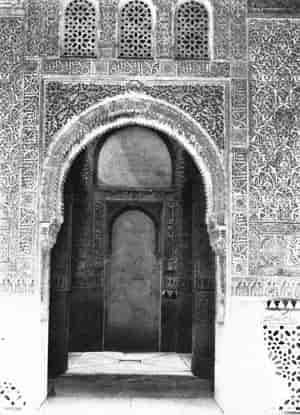 DECORATED WITH ARABESQUES AND STORIED WITH INSCRIPTIONS.
DECORATED WITH ARABESQUES AND STORIED WITH INSCRIPTIONS.In the latter part of the fifteenth century, after a long struggle, the Moorish power was overthrown by King Ferdinand, and since then Granada has been a Spanish city. Columbus was present at the court of the Spanish sovereign when the capitulation of Granada occurred in April, 1492, and within two weeks after the surrender of the city received his commission to sail in search of a new world.
Washington Irving's description of the entrance of the conquering Spaniards into the Alhambra after the capture of the city, might, with the change of a word or two, still portray the visit of a party of modern tourists.
 THE GENERALIFE OVERLOOKS THE ALHAMBRA.
THE GENERALIFE OVERLOOKS THE ALHAMBRA."The halls lately occupied by turbaned infidels," he writes, "now rustled with stately dames and Christian courtiers, who wandered with eager curiosity over this far-famed palace, admiring its verdant courts and gushing fountains, its halls decorated with elegant arabesques, and storied with inscriptions, and the splendor of its gilded and brilliantly painted ceilings."[Pg 51]
 PROTECTED BY CITADELS AND WALLS.
PROTECTED BY CITADELS AND WALLS.Although the coloring is faded, and in many places the intricate ornamentation is crumbling or broken, sufficient remains to show how marvelously beautiful it must have been in Moorish splendor. And beautiful it still is, notwithstanding the ravages of time.
While in the Court of Myrtles, some of the party examined the light, graceful arches and the stucco tapestry interwoven with flowers and leaves that adorn the galleries; others were more interested in the gold fish swimming in the transparent water of the long sunken tank in the center of the tiled court. In the richly ornamented Hall of the Ambassadors, the state reception room of the king, we waited while the guide, in answer to a request, interpreted some of the delicately carved inscriptions that fill every available space on the wall.
"One of these mottoes," said the guide, "that is repeated over and over again on almost every wall of the palace, reads: 'There is no conqueror but Allah.' Other mottoes which are very common are: 'There is no God but Allah;' 'Mohammed is the envoy of Allah;' 'Allah is great;' 'Allah never forgets;' and various quotations from the Koran."
Twelve weatherbeaten marble lions in the center of the Court of Lions uphold a large alabaster basin in which were caught, in times gone by, the falling waters of the fountain above it. Many graceful pillars support the surrounding arcades of this court and the exquisite fret-work looks as if carved in ivory.
A practical man in the party called attention to the beautiful wooden doors through which we entered the[Pg 53] Hall of the Abencerrages, and to the peculiar manner in which they were hung on pivots instead of hinges. On the rim of the marble basin in the center of this hall some red stains were seen.
"Here," said our guide, "is where the heads of the Abencerrages were cut off.
"But why was Aben's head cut off?" inquired a lady.
This gave the guide the opportunity he desired.
"A prominent member of the tribe or family of the Abencerrages, named Hamet," he replied, "fell in love with the Sultana, and she in return loved the handsome and gallant warrior. Secret meetings took place under a cypress tree in the garden of the Generalife until the Sultan, Boabdil, accidentally discovered their meetings. The enraged Boabdil, without revealing his knowledge of their actions, invited the guilty Hamet and every member of his tribe to attend a banquet. As each guest arrived at the palace he was brought into this hall. Here the guards seized him, forced his head over the edge of this basin, and the sharp simitar of the executioner showed no mercy. This was the king's revenge, and so the stains on the fountain."
The Room of Two Sisters brought forth exclamations of praise. Walls covered with dainty traceries in plaster, like embroideries on a ground of lace work; dados brilliant in fantastic designs of red, green, and blue; ceilings dropping thousands of stalactites each differing from the others in beauty of form; and charming views from the boudoir windows of floral beds and fountains in the garden beyond,—all these combined to make this place a suitable residence for a Queen.[Pg 54]
In the Baths we saw where royalty had bathed in marble basins to the sound of music by players in the gallery overhead.
"Here are the rooms which Washington Irving occupied in the Alhambra during his stay in Granada," explained the guide.
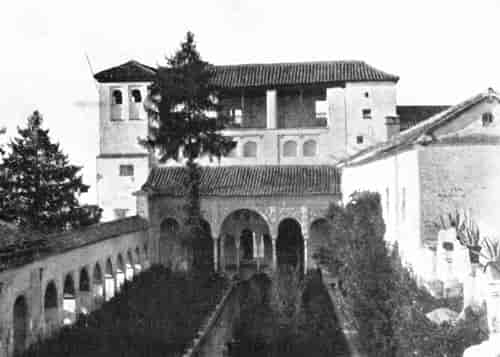 THE SUMMER RESIDENCE OF THE MOORISH KINGS.
THE SUMMER RESIDENCE OF THE MOORISH KINGS.Some of us tried to recall Irving's graphic descriptions in the "Conquest of Granada" of the scenes around this city; of the struggles between the Christian knights under the banner of Ferdinand, and the Moorish cavaliers under the standard of Mahomet; of fields covered with silken canopies; of cavalcades of warriors in jeweled armor and nodding plumes; of hand-to-hand[Pg 56] conflicts and daring exploits; of the siege and capture of the city and expulsion of the Moors from Spain. As we thought of the unfortunate Boabdil, the noble queen mother Ayxa, and the beautiful Zoraya, driven into exile, giving up their beloved palace, the home of their ancestors with all its wealth and beauty, to their hated enemies, and leaving the land which had been in possession of the Moors for eight centuries, we to some extent realized the sorrow that filled the hearts of the departing exiles as they looked back for the last time on the heights of Granada and wept.
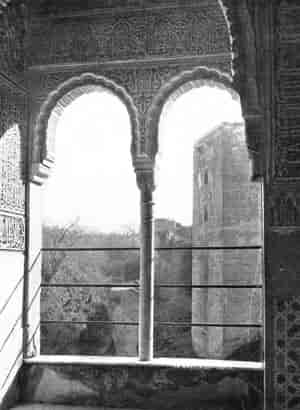 CHARMING VIEWS FROM BOUDOIR WINDOWS.
CHARMING VIEWS FROM BOUDOIR WINDOWS.Although the buildings of the Alhambra are partly in ruins, the view from the Old Watch Tower has not changed materially. Standing on the tiled roof to which we climbed by many well worn stone steps, we saw a magnificent panorama spread out before us. The city lay almost at our feet; beautiful valleys extended for many miles dotted with white villages; gray olive orchards appeared here and there; verdant hills rose in the distance; and, forty miles away, the snow-covered peaks of the Sierra Nevada pierced the sky.
After leaving the tower, we drove to the Palace of the Generalife, which is situated on the mountain side considerably higher than the Alhambra. We approached this beautifully located residence, where Moorish kings came to spend the summer months, by a wide path bordered with tall cypress trees. In the Court of the Cypresses our Spanish guide pointed to a venerable tree and said: "That cypress is six hundred years old; under it the guilty lovers, the Queen and Hamet, had their meetings until discovered by King Boabdil."[Pg 57]
In the gardens of the Generalife, we rambled amid oddly trimmed trees, climbing roses, immense rose bushes, fountains, and grottoes, and wished that our stay might be prolonged. The terraces of the garden have flights of marble steps leading from one level to another. One of the flights we descended had runlets of water flowing down on the top of the marble balustrades. Water, clear and sparkling, which is brought from a mountain stream above, is abundant everywhere in fountains and pools, and in streamlets along the pathways.
Among the sights of the city the milk delivery was interesting to strangers. A number of long-haired brown goats having been driven to the door of a house, a pitcher was brought and the milk drawn fresh from one of the goats; or a cow was led along the street and the milk furnished directly from the cow in any quantity desired by the customer.
Small donkeys with panniers were used instead of wagons for the transfer of almost every kind of material in the city and country. Often the burdens were so large that the donkey was almost lost from sight. We saw these patient little animals driven through the streets variously laden with sacks of charcoal, bundles of wood, baskets of vegetables, crates of oranges, bags of coal, cans of water, kegs of wine, or bearing hampers filled with building stone, bright tinware, or new-mown grass. Even the street cleaners shoveled into the panniers on the donkeys' backs the dirt and refuse that had been collected on the streets. Occasionally we saw men or women or children perched on the top of a load.[Pg 58] Two men were sometimes seen riding on one donkey, and once we observed three large men on one small donkey.
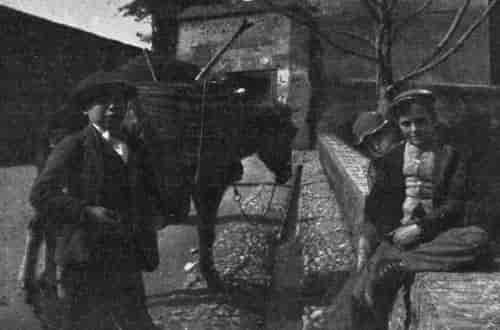 INTO THE PANNIERS ON THE DONKEY'S BACK.
INTO THE PANNIERS ON THE DONKEY'S BACK.As we drove along the streets to the station the residents at doors, windows, and sidewalks smilingly commented among themselves on our outlandish foreign costumes, evidently comparing our American styles with their own familiar dress. It was certainly as interesting to the Spanish women to observe the peculiarities of our costumes as it was for us to notice the mantillas and gay bodices which gave them a picturesque appearance in our eyes. We were being inspected as well as they; but the Spaniards are so polite that there was nothing unpleasant in their curiosity.[Pg 59]
It was after midnight when the steam launches carried us across the bay from Algeciras to our steamship. The reception given us at the Moltke, after our two days' absence, made us feel that we had indeed arrived home. Colored fires reddened the waters, clusters of electric lights illumined the sides of the vessel, the band was playing on deck, and the captain welcomed us at the head of the gangway. Then while the orchestra played selections, a full course midnight dinner was served to the hungry pilgrims.[Pg 60]
CHAPTER V.
THE CITY OF ALGIERS.
On the morning of Tuesday, February seventeenth, the Moltke was speeding over a calm sea toward the coast of Africa. The tourists, after the strenuous sight-seeing of the past two days, luxuriously rested. Some lazily lounged in steamer chairs with pillows under their heads and gay blankets over them; others exchanged experiences with friends while sauntering slowly around the deck. Some in groups surrounded the card tables, playing or watching the games; while others read books from the shelves of the library, or gathered the latest home news from the columns of the London Times, or the Paris edition of the New York Herald, copies of which had been taken on board at Gibraltar.
During the afternoon, however, a north-east wind suddenly arose which stirred the blue waters of the Mediterranean until the short choppy waves gave to the vessel a new and peculiar roll, differing from any previously experienced by those on board. As a result, many of the passengers, not being able to adjust themselves to this unfamiliar change of motion, became suddenly pale, and prudently retired to the privacy of their staterooms. But by the time the evening dinner was served the wind had somewhat subsided, and the majority of the passengers gathered in the saloon for an[Pg 61] entertainment in the form of a roll-call of states. This was presided over in a jolly manner by a prominent lawyer from Philadelphia. As he called the name of a state, some native of that state responded in a short informal address in which he praised his section of the country so highly that he made it appear to be a perfect El Dorado. There was but time to hear from seventeen states although representatives from almost every state in the Union and from Canada were present.
When the sun rose on Wednesday morning our steamer was anchored within the breakwater a short distance from the docks in the harbor of Algiers. A pleasant sight greeted our eyes when we came on deck. We saw a little white boat gliding over the waves flying the American flag, then two white steam launches speeding through the harbor with the same emblem floating in the breeze, while, over to the left, we descried at anchor three white gun boats, and hanging at their sterns our country's flag.
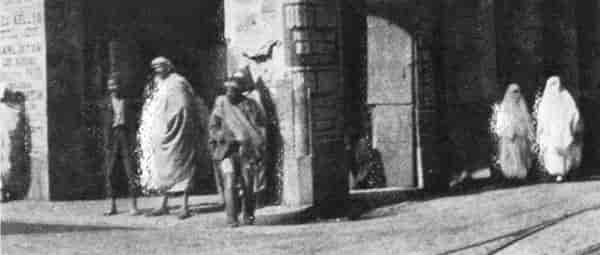 LIKE GHOSTS WALKING THROUGH THE STREETS.
LIKE GHOSTS WALKING THROUGH THE STREETS."Three cheers for the Stars and Stripes," cried an enthusiast, and the hurrahs were given earnestly and vigorously.
On the bulletin board we found the following notice posted:
PROGRAM FOR ALGIERS.
The Managers will furnish landing tickets to the tourists but all expenses while on shore in Algiers will be borne by each individual.
Carriages will be waiting on the docks for those who desire to ride, at their own expense, and a guide will be assigned to go with every four carriages.
Meals may be obtained by returning to the ship, and passengers are expected to return to the vessel at night.
"How shall we spend the day without a definite plan laid out for us?" said one of a group at the bulletin board.
"Let us take carriages with a guide as interpreter," suggested another, "and drive around the city during the morning, then buy our luncheon at a French restaurant, and spend the afternoon tramping around and visiting the shops."
"That will suit me, especially the shopping part; I want to buy some souvenirs," replied a third.
"And return hungry to the vessel in time for a good dinner in the evening," added a fourth.
Descending the ship's ladder, we placed ourselves in the care of the bronzed Arab boatmen, whose little boats had for some time been circling around the steamer, and were rowed to the custom house pier. Not having luggage to be examined, we fearlessly passed the red-[Pg 63]trousered custom officials in the building and crossed the busy docks to the carriages in waiting.
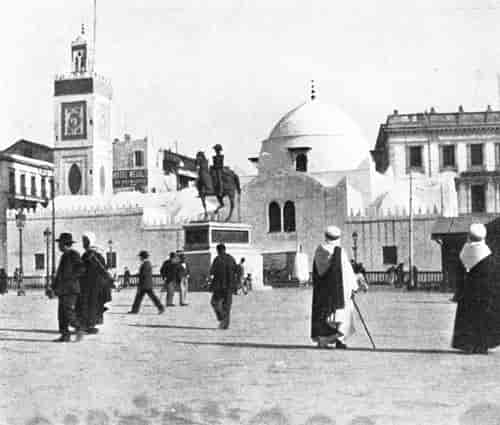 THE LITTLE MOSQUE IN GOUVERNMENT SQUARE.
THE LITTLE MOSQUE IN GOUVERNMENT SQUARE.At the docks many vessels were lying, and the wharves were filled with outgoing and incoming freight. Beyond the docks along the front of the city is a broad avenue, the Boulevard de la Republic, elevated forty or fifty feet above the wharves. This boulevard is supported on the sea side by solid white stone arcaded walls, and is reached by inclined roadways or by handsome stone stairways. On the land side it is lined with[Pg 64] substantial white stone buildings of uniform height with an arcade in front.
The population of the city of Algiers, about 100,000, is composed principally of Moors, Arabs, Negroes, and other African nationalities, but with a large number of French, and many Hebrews, some Spanish, English, and other Continental representatives, and a few Americans. On its streets we saw faces of different colors ranging from pure white, through all the tints of brown, to the deepest black.
In the Place de Gouvernment, one of the centers of business and religious life of the city, we met turbaned Arabs, barefoot negroes, red-trousered soldiers, French civilians, American tourists, Hebrew traders, Kabyle mountaineers. In this motley crowd the native men and women especially attracted our attention. The Algerine men wore long white gowns fastened at the waist with a girdle; white cloaks, called bournous, around their shoulders; and white turbans of many folds on their heads. The richer classes were arrayed in spotless garments of fine material, stockings, and ornamented sandals; the laborers wore coarse gowns, and sandals made of rope; while the unclean bodies of importunate beggars and unfortunate cripples were but partially covered with filthy sacking and rags which hung upon them.
The Mohammedan women, wearing long bloomers made exceedingly full, and white mantles resembling sheets draped over their heads and falling loosely around their bodies, looked like ghosts as they walked through the streets. The white bandages or veils wrapped[Pg 66] around their heads concealed all the features except the eyes, which appeared black and piercing. The Arab men may be able to distinguish the age of these veiled females, but it was difficult for us to tell which were old women, and which young, except by the elasticity of their movements.
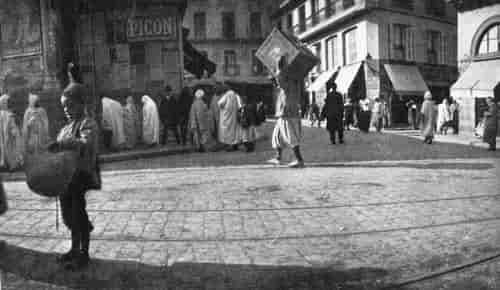 THE ALGERINE MEN WEAR LONG WHITE GOWNS.
THE ALGERINE MEN WEAR LONG WHITE GOWNS.Near the Place de Gouvernment is the imposing palace of the Governor where all official business is transacted. Adjoining the palace stands the handsome Roman Catholic Cathedral. A long flight of white marble steps leads up to the doors of the Cathedral and a spreading palm tree stands like a guard near the foot of the stairway. As we stood before the tomb of St. Geronimo in the interior of the Cathedral, we listened to the following tale told by our Catholic guide.
"A young man by the name of Geronimo, who lived in Italy about three hundred and fifty years ago, was captured by the Moors, and because he would not renounce the Christian religion, was condemned by his captors to death by torture. They tied his feet and hands with cords and threw him alive into a mould of soft concrete which slowly hardened around him, and the stone thus formed was built into the wall of a fortress then in course of construction. Fifty years ago, when the fortress was being demolished, the block of stone was discovered with the skeleton enclosed therein. The bones were carefully removed and interred in this Chapel in the tomb you see before you. Into the vacant space within the block of concrete, after removal of the bones, liquid plaster of Paris was poured, as into a mould, and a perfect model of Geronimo's body was obtained and[Pg 67] placed in the Museum. It was in recognition of this act of heroism in refusing to renounce the Christian faith that the martyr was canonized and the name of Geronimo was added to the calendar of the saints of our Church."
In confirmation of the guide's story, the plaster of Paris model of the dead martyr's body may be seen among the curiosities and antiquities in the National Museum, a short distance from the Cathedral. This model shows the features, the clothing, and the cords which tied his feet and hands.
The main business part of the city is not only modern but model, having clean, well paved streets lined with substantial white stone four-story buildings with arcades or covered pavements in front of them. As very little smoke or soot rises from the city the white buildings have not become soiled and darkened but retain their freshness and purity of color.
Many of the stores we visited were kept by Arabs who understood French but could speak only a few words of English. The prices named by these merchants were generally two or three times more than they expected customers to pay, and it was very amusing to watch the process of a sale. A price was named by the dealer; a bid was made by the customer; then figuring, explaining, and dickering went on in a mixture of languages and signs until finally, if the buyer's patience did not wear out, the deal closed with a compromise. When the purchaser departed happy with a bargain, the dealer also appeared well satisfied, and if the same buyer returned to the store after once making a purchase,[Pg 68] the Arab merchant would recognize and welcome him with most gracious smiles as if he were one of his warmest friends.
In these shops there was offered for sale such a varied and attractive assortment of oriental wares, that by evening the tourists were laden with packages. Handsome silk rugs, embroidered silk waists, curiously carved Algerine weapons, brightly colored leather goods, articles of hammered brass or copper, silver filagree work, ornaments of silver and gold, trinkets of ivory, coral and pearl, fans, photographs, and picture postal cards purchased during the day, were stored away in staterooms as souvenirs of Algiers.
At the market stands were fruits and vegetables in abundance. The dates offered were especially pleasing in appearance and quality. The bread dealers, we noticed, sold bread by weight, and added or cut off chunks and slices in order to give the exact weight wanted by customers.
The beggars did not trouble us very much by their importunities, although they were to be seen everywhere in filth and rags. Street peddlers, however, were persistent in offering wares and trinkets for sale, and bright Arab boys, who had learned a few sentences of English ran after us offering their services as guides.
The coffee shops which we saw while passing through the streets were as numerous in Algiers as beer saloons in an American city. As the Mohammedan religion forbids the use of alcoholic liquors, the Arab followers of Mahomet appeared to be satisfying their craving for stimulants by drinking strong black coffee and by[Pg 69] drinking it often. In the cafés, which are open in front, allowing all that goes on inside to be visible from the street, and on the benches outside the shops, we saw the customers sitting crosslegged slowly imbibing this favorite beverage from tiny cups. It was plainly apparent that in this warm climate where there is no haste, numberless hours are dreamed away on the benches of these cafés.
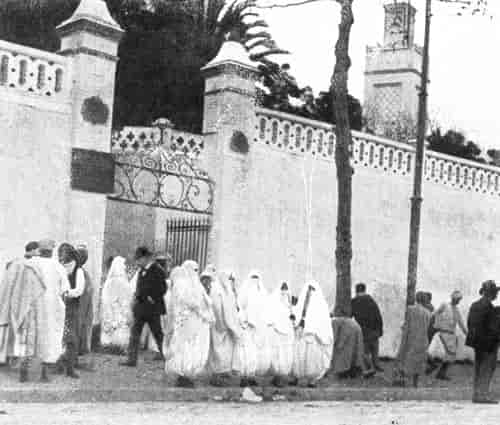 ON FRIDAYS THE WOMEN VISIT THE CEMETERY.
ON FRIDAYS THE WOMEN VISIT THE CEMETERY.When we left the modern part of the city and ascended the avenues which lead up the hill toward the older[Pg 70] portion we found the streets diminishing in width until they were only passageways from six to ten feet wide, bordered by high buildings with blank walls showing no windows below, but with projecting windows above which almost meet overhead. In some of these steep, narrow, crooked streets there are little shops about the size of a large closet in which the merchant, sitting crosslegged on bench or cushion, can reach his goods and wait on his customer without rising or interfering with the enjoyment of his pipe. As the narrow thoroughfares are not wide enough for carriages, we had to walk through them with a guide. We were not favorably impressed with the odors nor with the sight of the filth in the streets and were glad when the guide turned from the gloom and foulness of the ancient Moorish streets and led us again toward the bright and attractive avenues of the modern city.
The electric street cars are divided into two compartments; the first class having thin cushions on the seats, and the second class having wooden seats without cushions. The natives save the extra penny of fare by crowding into the second class, thus giving to the first class passengers the advantage of always having enough room. In the second class, however, the tourists had a more favorable opportunity to study the people. Opposite us in one of the second class compartments which we entered sat two veiled women in their voluminous white bloomers and wrappings. We could see that one was old by the fact that she leaned upon a staff, and we decided that the other was young because she showed some curiosity. Sitting near us was a[Pg 71] little black haired Arab girl with a chunk of dry bread in her hand, at which she was gnawing greedily. In a corner seat a meek looking nun in black gown and wide spreading stiff bonnet was counting the beads of her rosary as quietly as if alone in her devotions.
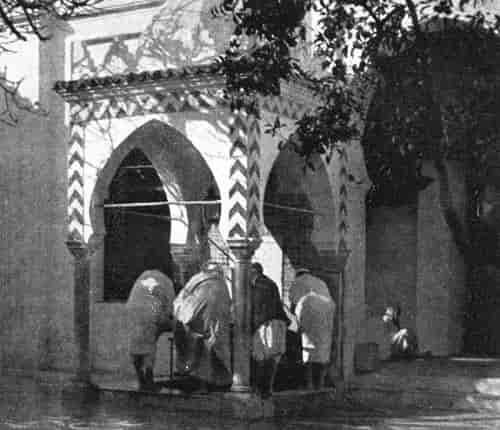 ABLUTION AT THE FOUNTAIN BEFORE PRAYER IN THE MOSQUE.
ABLUTION AT THE FOUNTAIN BEFORE PRAYER IN THE MOSQUE."Look," said one, as we were leaving the car, "there is the 'Thomson and Houston' stamp on the motor."
"Yes," responded another, "American products appear to be well represented in this French colony."[Pg 72]
On the main business thoroughfare we had noticed warerooms where 'Singer' sewing machines are sold; at an agency of the 'Eastman Company' we had restocked our kodaks with films; and we could not avoid seeing on a large sign, in letters that could be read a block away, the words 'American Dentist.' Consequently when we passed the American Consulate it was with a feeling of pride that we saluted the National Emblem which was floating gracefully in the breeze.
In the Rue de Marine we saw an old structure of large dimensions with a long row of plain white marble columns in front, which, from its appearance, might be mistaken for an old warehouse. We were told by a Moslem guard, who fortunately understood our inquiry and was able to answer our questions in English, that the building is the Mosque El Tebir, the Great Mosque, and that we might enter subject to certain regulations.
"You must remove your shoes," said he, "or wear slippers over your shoes. You must also pay a small entrance fee."
In the vestibule, the door-keepers of the Mosque selected slippers from an assortment of different sizes which they kept for visitors' use and tied these over our shoes with tapes. We were then permitted to enter and wander around the interior over the handsome Persian rugs which cover the stone floor.
"The Moslems regard their Mosques as very sacred places consecrated to the worship of Allah, and they will not permit any profanation of their sanctuary," cautioned one of our party, a Presbyterian minister, seeing that we were inclined to make fun of the slippers.[Pg 74] "The Moslems remove their shoes and enter the place of worship with reverence, and they expect us to behave in a respectful manner."
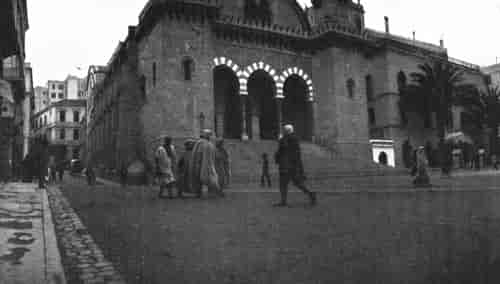 THE CATHEDRAL ADJOINS THE PALACE OF THE GOVERNOR.
THE CATHEDRAL ADJOINS THE PALACE OF THE GOVERNOR."The removal of the shoes at the entrance to a place of worship," continued the minister in explanation, "is an immemorial Eastern custom based on the words: 'And he said, Draw not nigh hither; put off thy shoes from off thy feet, for the place whereon thou standest is holy ground,' and also on the words: 'And the captain of the Lord's hosts said unto Joshua, Loose thy shoe from off thy foot; for the place whereon thou standest is holy. And Joshua did so.' We should remember that the Mohammedan faith is based on the Old Testament, though supplemented by the instructions of Mahomet."
In this ancient Mosque, where the worship of Allah and the study of the Koran has continued for nine hundred years, we found a few barefoot worshipers, some kneeling muttering their prayers, while others squatted on the floor reading the Koran aloud. At one end of the interior we saw the niche which indicates the direction in which lies the Holy City of Mecca, and toward this, as is the custom in all Mohammedan mosques, the worshipers turn their faces while at prayer. There were no benches or chairs in the mosque, as the devotees assumed a crosslegged position on the thick rugs during the time of their reading, and stood or knelt while offering prayer.
The Jardin d'Essai, or Botanical Garden, situated in the suburbs near the sea about two miles from the center of the city, is reached by an electric street car of[Pg 75] American make which for a three-cent fare carried us to the gates. In the garden the large and varied collection of tropical trees, plants, and vines, so different from those growing in our own temperate climate, greatly delighted us. An "Avenue of Palms" half a mile long was lined with palm trees of many varieties, some wide-spreading and curiously branching has broad leaves, and others, high-growing, has tufted tops swaying in the air fifty or sixty feet above our heads. A wider avenue of similar length was bordered with magnolia trees of immense growth which we then saw only in bud, but it was not difficult to see in imagination the magnificent picture that would be presented to the eye, when later on, these millions of buds overhead would be in full bloom. The "Bamboo Pathway" led through a dense growth of bamboos whose slender poles, bending under a slight breeze, kept up a continual creaking sound. Huge trees, whose wide-spreading branches were supported by scores of accessory trunks, so that each tree formed a grove of its own, we recognized as banyan trees. In one part of the garden, winding paths led through a tangled tropical growth so dense and wild that one felt as if in the midst of an African jungle where a tiger might spring forth or a boa constrictor drop down on one's head.
On the heights to the east, in the favorite modern residential district, called Mustapha Superieur, many large white stone hotels and apartment houses were situated amid gardens of glossy-leaved orange and lemon trees. Palms, plane, and pepper trees lined the clean, wide avenues; green terraces beautified the hillside[Pg 76] gardens; and villas were almost hidden from sight by the climbing roses and luxuriant vines with clusters of purple racemes.
"Many of these villas," said the guide, "are owned by wealthy English and French families who spend the winters here. The mild climate and uniform temperature of our city makes this place a favorite winter resort not only for invalids, but for those who desire to get away from the damp fogs and harsh winds of more northern climates."
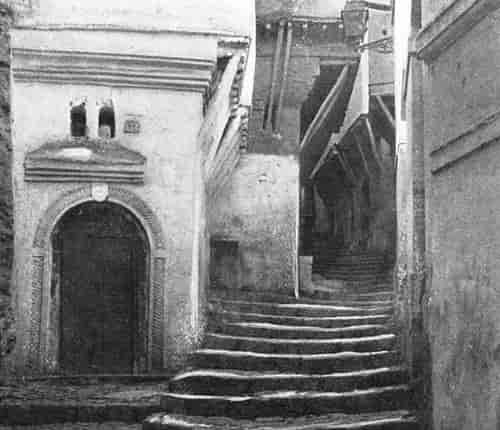 THE ENTRANCE TO A NARROW STREET.
THE ENTRANCE TO A NARROW STREET."Our city is noted for two views which we think are unsurpassed," he continued, as the driver reined in his team on a summit. "One is this which we now look down upon of city, harbor, sea, and villages near and distant along the shore. The other, you already have seen from the deck of the vessel, yet at sunset you will find that panorama of the city, villages, heights and mountains even more beautiful."
While we were exploring the city, the officers on the steamer were engaged in directing the taking on of fresh supplies of coal, water, and provisions, which had been purchased at Algiers. During the two days the Moltke lay in the harbor fifteen hundred tons of coal were carried in baskets on the shoulders of Arabs from barges into the hold of the vessel, a slow method of delivering compared with the rush of the steam scoops in New York harbor where three thousand tons were dumped into the bunkers in a few hours' time. Fresh water also was brought from shore in tank barges and pumped from these into the tanks on the steamer. The quantity of fresh water required at this port cost the steamship company, so the engineer informed us, a sum equal to four hundred dollars. Also great quantities of fresh fruits and vegetables were received on board, one of the most welcome things thus added to our bountiful bill of fare being the tender green artichoke which in Algiers grows to perfection.
On Thursday afternoon a reception was held on the Moltke and our band gave a most enjoyable musical program for the occasion. Hundreds of well dressed, courteous French ladies, gentlemen, and children, and[Pg 78] some French officials in uniforms, came on board to visit the vessel which was thrown wide open for their examination. Some of the officers of the naval vessels also came to the reception and extended a cordial invitation to the tourists to visit the gunboats. This invitation was accepted by some who were willing to spare the time for that purpose.
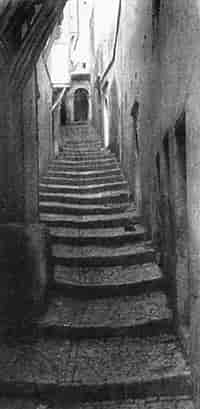 A STREET IN OLD ALGIERS.
A STREET IN OLD ALGIERS."Less than one hundred years ago Algiers was a country of pirates," said one of the officers to a group of tourists, "and Algerine corsairs flying the black flag infested the Mediterranean coast. Like birds of prey they pounced upon the merchant vessels of other nations, confiscating the cargoes, seizing seamen and passengers, and burning the ships. They cast thousands of captives into dungeons and de[Pg 79]manded heavy ransoms for their release. They sent many thousands to the markets to be sold,—the men to be degraded to slavery, the women, praying for death, to be dragged away to harems of their purchasers. Among the captives held for ransom were many Americans. But you are familiar with all this ancient history."
"No, we are not," replied one of the ladies; "I may have read it but if so, it has slipped from my mind. Why, we have gone about the city feeling as safe and secure from harm and insult as we did in our home cities."
"And you were as safe in Algiers during the day time as you would be in Paris, London, or New York. I should advise you, though, to keep off the streets of this and all Oriental cities after nightfall. We may be proud to remember that the United States was one of the first countries to stop paying ransoms and to administer a salutary reproof. In June of the year 1815 our Commodore Decatur sailed into this harbor and sent a message to the Dey of Algiers demanding the release of all Americans then held in captivity, threatening to bombard the city if the prisoners were not set free. The Dey after some demur yielded through fear of bombardment and liberated all the Americans; but sent a message to the Commodore requesting that a tribute in the shape of powder be given him in exchange for the captives. 'If the Dey wants powder, he must take the balls with it,' Decatur bravely replied. After that the merchant vessels flying the American flag were not molested. The great destruction of ships and the[Pg 80] capture of Europeans continued until France, highly exasperated, determined that it must be stopped, and the Moors punished. An expedition was sent to Algiers and the country was conquered in the year 1830, since then Algiers has been a French colonial possession."
Just as the sun was dropping below the horizon filling the air with a golden light, the anchor was slowly raised. A number of the French people who had been visitors to the Molkte were in a steam launch near by waiting to see our departure.
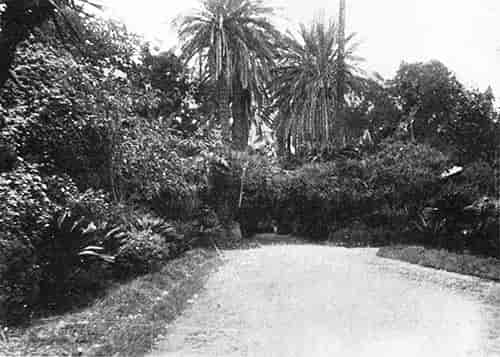 LED THROUGH A TROPICAL, TANGLED GROWTH.
LED THROUGH A TROPICAL, TANGLED GROWTH."Adieu," "Adieu," "Bon voyage," were the parting salutations, as the French ladies waved handkerchiefs and the French men raised their hats.[Pg 81]
As the warships were passed, "Three cheers for the Red, White, and Blue" were given with a will amid waving hats, handkerchiefs, and small flags, and our greeting was answered by the lowering and raising of the Stars and Stripes on board the warships. Then our great ship steamed slowly out of the harbor, passing the the forts which at the extremities of the moles guarded the entrance, and the lighthouse whose strong, steady light was just beginning to shine.
As we entered the open sea we looked back with regret at the scene of beauty behind us. Vessels flying flags of many nationalities lay at anchor in the harbor or at the piers. Above the handsome white stone docks on the sloping hillside rose the clean-looking white city. On the hill to the right far away in bold relief stood the Church of our Lady of Africa. To the left, as far as the eye could reach, along the shore of the bay beyond the city, were clusters of Moorish houses, white villages, and green plains, and on the heights above, white villas and hotels in the midst of green foliage. In the distance rose a range of high hills, and far beyond the gray peaks of the Atlas Mountains bounded the horizon.
No picturing of that scene can show the beauty of the view there presented to our eyes. But he who has visited Algiers will never forget the soft harmonizing colors of blue sky, white and yellow buildings, green foliage, and gray background.[Pg 82]
CHAPTER VI.
THE ISLAND OF MALTA.
Among the tourists were twenty-one Knights Templar. These Knights took a special interest in the history of the island of Malta and the romantic story of the Knights of St. John. For the benefit of those who desired the information, a lecture on Malta was delivered by a member of our party who was familiar with the subject.
"Know something of the history of the island," advised the lecturer, "and you will appreciate and enjoy what you see there more highly than you would without that knowledge. In the fortifications, the palaces, the churches, of this island you will find many memorials of the Knights of Malta, and it may add to your pleasure to hear something about the famous warrior-monks before visiting these places."
Many of his hearers, taking the advice, made notes of the story as related by him.
"About one thousand years ago," he said, "the Order of the Knights Hospitallers was organized at Jerusalem, by Italians. Its members took vows of fraternity, chastity, and poverty. The purpose of the Order was to erect hospices for the shelter of pilgrims who came to visit the Holy Sepulchre at Jerusalem, and hospitals in which to care for the pilgrims when sick. During many years of faithful service the work of the Hospitallers[Pg 84] was supported by contributions from all Christendom; but when the oppression of the Turks became unendurable, the Knights took upon themselves vows to fight in defense of the Christian faith, and the religious brotherhood became a band of saintly warriors. This band during the time of the Crusades grew into a great military order known as the 'Knights of St. John.' In the battles of the Crusades, the Knights, fighting against the infidels for the possession of the Holy Land, became renowned for great personal strength, dauntless courage, and daring heroism.
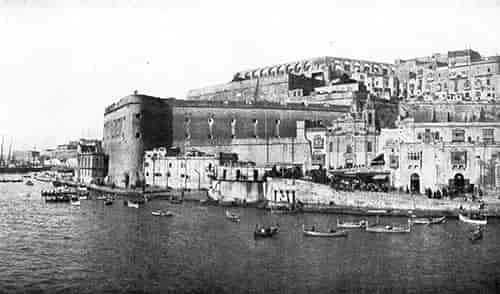 THE HARBOR IS SURROUNDED BY OLD GRAY FORTRESSES.
THE HARBOR IS SURROUNDED BY OLD GRAY FORTRESSES."After the failure of the Crusades, the Knights were expelled from Palestine by the victorious Saracens, and, twenty years later, were driven from the near-by island of Cyprus. Fleeing to the island of Rhodes, they there enjoyed two centuries of power and increasing prosperity, during which time the banner of the cross remained victorious over warring Turks, Greeks, and pirates. Then at the end of this period came the memorable siege of Rhodes. For six months the steel-clad cavaliers withstood the assaults of the Ottoman hosts, and their ponderous battle axes swept down the infidel assailers by scores. Personal strength, however, could not endure the continual strain. The besieged, utterly worn out, were compelled to capitulate and leave Rhodes; but as a compliment to their valor, they were permitted by the Sultan to depart in honor, taking with them all movable property and treasure.
"In the year 1530, the Knights of St. John found a refuge on the island of Malta. They grew in numbers and importance, fortified the island, and resumed the[Pg 85] warfare against their hereditary foes. Success at sea and on land resulted in the capture of richly laden prizes, multitudes of captives, and booty of enormous value. The captives became slaves laboring on the fortifications or straining at the oars. The booty adorned the churches and enriched the people. But as power and wealth increased, the desire for spoils took possession of the hearts of the Knights and the original vows of humility, kindness, and charity were forgotten. They became proud and boastful seekers of plunder and believed themselves to be invincible. Their enemies called them pirates.
"In 1565 their numbers were greatly reduced during a noted siege by the Sultan of Turkey. Then fortune smiled or frowned on them in varying moods for many years, whose story is filled with romance and interest. In 1798 the island of Malta, after having been for nearly three centuries in the possession of the Knights of St. John, was captured by an invading French force, and two years later it became, by conquest, an English possession.
"The fortifications have since then been strengthened and equipped with modern armaments, so that the island is now considered an impregnable stronghold. Here, as at Gibraltar, an army is stationed in the barracks, and great quantities of provisions are kept in store to supply the garrison in case of siege. The harbor of Valetta is deep and safe, and the narrow entrance is commanded by three strong fortresses. Here is the headquarters of the Mediterranean fleet of the British navy. Here, also, are great repair docks, a coaling[Pg 86] station where huge stocks of coal are kept on hand, and warehouses filled with naval supplies.
 MALTESE WOMEN WEAR PECULIAR BONNETS.
MALTESE WOMEN WEAR PECULIAR BONNETS."The island is densely populated, the number of people to the square mile being four times greater than in England. The city of Valetta, the capital of Malta, named after the Grand Master, Jean de La Vallette, by whom it was founded in the sixteenth century, stands high above the water on a commanding promontory."[Pg 87]
"In this condensed account," said the lecturer in conclusion, "I have tried to give you a few of the main facts relating to the Knights and the island. Those of you who are interested in the romantic history may read it more fully when you have leisure after your return home."
The Moltke cast anchor in the harbor of Valetta about six o'clock on the morning of the twenty-first of February. After we had partaken of an early breakfast, Maltese boatmen in scarlet caps and sashes, who stood up while handling their oars, rowed us to the shore. Their brightly painted boats had peculiar carved wooden posts erected at prow and stern and white awnings overhead. Walking up a sloping, zigzag pathway, constructed in a passage cut down through the high cliffs, we ascended from the busy docks to the heights above. At the summit a Maltese gentleman kindly directed us on our way to the Queen's Garden located directly above the landing place.
From the parapets of this place a magnificent and interesting view of the harbor was obtained. Not far away, but hundreds of feet below us, the Moltke lay, encircled by the white awning-covered boats. Eight large battleships and a dozen cruisers and gunboats, all painted black, were lying peacefully at anchor. Steamships and sailing vessels at the docks were discharging cargoes, or were lying in the bay awaiting their turn to unload. Steam launches were busily flying from one point to another, and little ferry boats were constantly crossing and re-crossing the bay. The harbor was surrounded by high cliffs and old gray forti[Pg 88]fications. At the entrance to the bay stood a tall lighthouse and a frowning fortress, the one for guidance, the other for protection. Through the entrance a ship with spread sails was entering, and beyond, the sunlight shone on the beautiful blue waters of the Mediterranean.
 ATTRACTIVE STORES LINE THE "STRADA REALE."
ATTRACTIVE STORES LINE THE "STRADA REALE."The streets of Valetta were full of life that day. In reply to inquiries we were informed that on the following day, the Sunday preceding Lent, a festa, or carnival, lasting three days, would begin. During the festa, business would be suspended, and the people, disguised in masks and fanciful costumes, would engage in most ludicrous and extraordinary antics and play all manner of practical jokes on one another, showering the passers[Pg 89]-by gently with confetti and flowers, or pelting them stingingly with dried peas and beans. Many children, impatient for the morrow to come, were already parading the streets arrayed in their costumes.
Attractive stores line the "Strada Reale," the main shopping street. In these stores laces, gold and silver filagree work, jewelry, and embroidered muslins were the principal wares sought by the tourists. The ladies of our party were particularly anxious to secure pieces of Maltese lace, a special hand-made product noted for the excellence of its quality, the making of which gives employment to thousands of the inhabitants. In trading with the Maltese merchants, we soon found that the prices asked by the dealers were about twice the amount the customer was expected to pay, and that bargaining was as necessary in Malta as in Algiers.
Almost all the costumes we saw on the streets were of the English style, but the varied uniforms of soldiers and the distinctive garments of Greeks, Turks, Spaniards, and Arabs added color and interest to the scene. The Maltese women wear immense bonnets, called faldettas. These peculiar bonnets have long skirts which reach to the waist and are totally black without color or ornament. As the majority of the inhabitants are Roman Catholics, we saw many priests and monks who wore black robes and very broad-brimmed black hats turned up at the sides.
The Maltese are lovers of flowers, which are raised in profusion. At the corners of the principal streets were small fanciful buildings, a few feet in diameter, in which dark eyed brunettes offered flowers and bonbons for[Pg 90] sale. The people also love music. In the Opera House, an elaborate structure, which, we were told, cost a quarter of a million dollars, Grand Opera is given three times a week for six months in the year.
We visited the old church of St. John, which was built three centuries ago and lavishly adorned out of the proceeds of plunder that had been taken from infidels and pirates. The tower above the church contains a chime of ten bells, and the clock on the tower has a triple face, one face showing the hour of the day, one showing the day of the week, and the third, the day of the month. The heavy doors were open, but a curtain of matting hung over the entrance. A ragged, barefoot boy ran before us, and, drawing aside the matting that we might enter, extended his hand for a penny. We walked over the beautiful inlaid mosaic marble floor, and beheld handsomely painted ceilings with life-size figures overhead, and richly decorated walls and pillars around us. A priest with pride pointed out the famous paintings on the walls, the bronze and the marble statues around the sides, and, in the various chapels, the three huge iron keys which opened the gates of Jerusalem, Acre, and Rhodes, and the gates of solid silver in front of the richly decorated altar. As we stood before the silver gates our guide told us his little story:
"When the French captured Malta in 1798 they carried away as booty the most valuable possessions of the church in the form of precious jewels, silver statues, golden vessels, valuable vestments, and works of art. The Emperor Napoleon with his own hand took a most[Pg 92] valuable diamond from the finger of the jeweled glove which covered the sacred relic, the hand of St. John, and placed it on his own finger. The Emperor also took the diamond mounted sword, which had been carried by Valette, and buckled it to his side. These silver gates, too, would have been carried away but for the forethought of a priest who painted them black and so concealed their value."
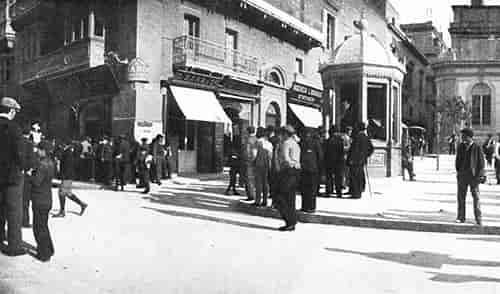 THE STREETS OF VALETTA WERE FULL OF LIFE THAT DAY PRECEDING THE FESTA.
THE STREETS OF VALETTA WERE FULL OF LIFE THAT DAY PRECEDING THE FESTA.In the nave of this church we tramped over hundreds of marble slabs which have been placed among the mosaics in the floor as memorials of the knights and nobles who are buried underneath. These flat tombstones are adorned with representations of coats-of-arms, musical instruments, angels, crowns, palms, skeletons, and other odd devices. But in the crypt underneath, whither we were next conducted, majestic monuments of elaborate design mark the resting places of the most noted Grand Masters of the Order, the tomb of Grand Master Cottoner being one of the most imposing. In the sacristy we gazed at, but were not permitted to touch, the beautifully illuminated missals, the finely woven pieces of ancient embroidery, and the splendid robes of former Grand Masters.
"The tapestry of the Lord's Supper and many other wonderful tapestries are locked in that chamber," said the priest, pointing to a closed door, "and are only exhibited in June each year."
At one of the altars in a side chapel worshipers knelt before a piece of the true cross; but the relics regarded as most precious in the custody of the Church of St. John, a thorn from the Savior's crown, portions of the[Pg 93] bones of three apostles, one of the stones cast at St. Stephen, the right foot of Lazarus, and a fragment of the cradle of the infant Jesus, are guarded with great care and rarely exposed to the gaze of curious eyes.
In the Governor's Palace the tourists spent a short time. The walls of the Council Chamber are hung with rare tapestry which has retained its color and beauty for nearly three centuries. The dining room and corridors are decorated with paintings of grim-faced Grand Masters of the past; and the gorgeous ball room contains a throne on which these same rulers sat in state surrounded by pomp and splendor. In the great hall of the Armory are rows of figures clad in the antique armor worn by the Knights, together with steel gloves, helmets, and coats of mail, inlaid with gold and silver; and around this hall are arranged the crossbows, arquebuses, spears, pikes, swords, battle axes, and old battle flags. There with the treasures are the old silver trumpet that sounded the retreat from Rhodes, and the faded parchment manuscript, or Papal edict, which sanctioned the gift of the island by Charles V. of Germany to the Knights; and among the trophies are the jeweled coat of mail and weapons of a famous Algerine corsair, a cannon curiously constructed of a copper tube wound with tarred rope, and many torn and blood-stained, crescent-mounted standards which in the hand-to-hand conflicts had been captured from the Turks.
"What soldier of the present day could march or even ride any distance so encumbered with steel?" remarked one of the tourists as we stood before an emblazoned[Pg 94] suit of mail that had been worn by one of the Grand Masters of the Knights. "To handle these heavy battle axes or long spears for stroke after stroke or thrust after thrust during the long hours the battle raged must have required muscles of steel and wonderful powers of endurance."
 THE CLOCK ABOVE THE ANCIENT CHURCH HAS A TRIPLE FACE.
THE CLOCK ABOVE THE ANCIENT CHURCH HAS A TRIPLE FACE."These breastplates and helmets and shields, which were worn by the Knights to protect them from the arrows and spears of their enemies," said one of the ladies, as she looked at the old armor, "enable me to understand better what St. Paul meant when he wrote[Pg 95] to the Ephesians: 'Put on the whole armor of God that you may be able to stand against the wiles of the devil,' and 'all the fiery darts of the wicked.' The old monk-soldiers must have interpreted that command literally when they went out to fight the infidels."
After completing our sight-seeing in the city of Valetta, a little train of cars on a narrow-gauge railroad carried us a distance of six miles to the older city of Citta Vecchia. The land along the way as far as we could see was divided into small plots ranging from about half an acre to two acres in size. Each plot was surrounded by stone walls from six to ten feet in height, many of which were broken and dilapidated. We were told that, although the climate of the island is quite mild, violent winds frequently blow over it, and these walls were erected to protect the fig, orange, lemon, and other fruit trees from destruction. Protected from the high winds, these trees yield abundantly; and, in the fertile soil of these plots, two or three crops of vegetables are raised each year. Much of the land was rocky and uncultivated. Very few trees were seen and those were dwarfed. One species of evergreen tree, called the Carob, grew only ten feet in height, but spread to three times that in breadth. In some neglected spots the prickly pear grew in rank masses. The houses along the way, built of yellow or gray stone, had a weather-beaten look, and the yards around them were enclosed with high walls. The small square windows in the houses and the flat stone roofs with enclosing parapets reminded us of pictures of the houses in Bible stories.[Pg 96]
In Citta Vecchia the two principal attractions were the Cathedral of St. Paul and the Grotto of St. Paul. The Cathedral is said to be built on the site of the house of Publius, the governor of the island, who entertained and lodged St. Paul for three days after he was ship-wrecked on this island, which in the Bible is called Melita. The Grotto is said to have been occupied by St. Paul during his three months' stay on the island. About four miles from the Cathedral is the bay of St. Paul, where the apostle was wrecked while on his way to Rome. There is the little creek in which the sailors tried to guide the storm-tossed vessel and the shore to which they escaped "on boards and on broken pieces of the ship."
In Citta Vecchia we were shown the mosaic pavement and the decorated frieze of an old Roman house supposed to be over two thousand years old, which had been uncovered at a considerable distance below the surface while an excavation was being made. Notwithstanding their age the old mosaic pavement and frieze were in good condition.
An interesting day of sight-seeing closed with a drive in Valetta through the humbler part of the city and down a long inclined street which led to the docks. At nightfall as our steamship moved eastward the lights of Malta's stronghold gradually faded from our sight, but the gleam of its lighthouse followed us for many a mile.[Pg 97]
CHAPTER VII
ATHENS AND THE ACROPOLIS.
The sun was just appearing in the east as we approached the seaport of the Grecian capital.
Through the mists of the dawning day we could make out dimly, ahead of us, only bleak bare hills. As the Moltke steamed through the straits we saw a lighthouse and a few buildings on the shore and over the low hill on our right the tops of masts; but when the vessel had entered through a narrow passage between the moles extending from either side, and had anchored in the centre of the well protected and commodious harbor of Piræus, we gazed on a scene of animation and activity. The bay was filled with shipping and the shore lined with warehouses where the stevedores were already busily engaged in lading or discharging cargoes. On each side of the Moltke, little more than a stone's throw away, lay gray battleships, cruisers, torpedo boats, destroyers, and other naval craft.
"What war vessels are those?" was the question asked eagerly by many passengers.
"The white flag with the blue St. Andrew's cross floating over that warship is the Russian national emblem," patiently replied one of the officers of our steamer, "and so I conclude that these vessels compose the Russian Mediterranean squadron."
A band on the flagship began to play and the Russian[Pg 98] sailors in clean white suits were seen forming in lines on the decks of the vessels, evidently for inspection or morning roll-call. On the rigging above the sailors' heads, swaying in the breeze, were hundreds of white suits, washed and hung out to dry.
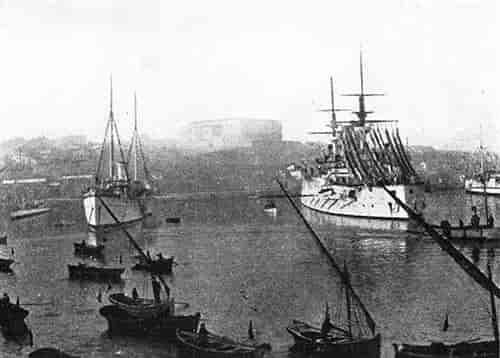 HUNDREDS OF WHITE SUITS HUNG OUT TO DRY.
HUNDREDS OF WHITE SUITS HUNG OUT TO DRY.Soon fifty or more large row boats were plying around our steamer in readiness to convey us to the railroad station at the upper end of the harbor about a mile away. As we approached the shore in these boats we saw on the wharf at Piræus a motley crowd of dirty-handed, bare-footed, ill-clothed men and boys. It seemed as if all the idle and vagabond population of the city had assembled to lounge lazily in the sun, hoping, perhaps, to[Pg 99] obtain some small coins from the tourists during the transfer from boat to cars. If this was their hope they were disappointed. All arrangements for the welfare of the Moltke tourists had been carefully made in advance, and, as there was no baggage to be carried, the services of the dirty-handed men were not required.
"Are these vagabonds and tramps the descendants of the noble Greeks whom we have honored all our lives?" sadly remarked a minister in our boat. "Can these be the offspring of the great orators who electrified their hearers, or of the famous architects and artists whose names are immortal? Are these swarthy-faced, plain-featured idlers the representatives of the Greek beauty of form and feature?"
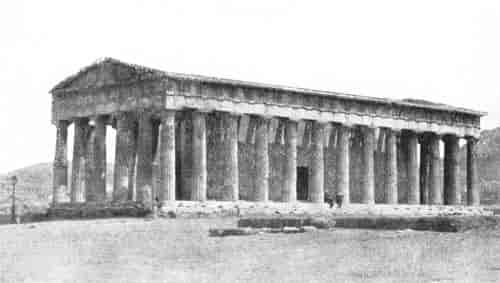 STRENGTH AND SIMPLICITY RATHER THAN BEAUTY.
STRENGTH AND SIMPLICITY RATHER THAN BEAUTY.In preparation for a visit to these historic shores we had filled our minds with tales of heroism and visions[Pg 100] of the beautiful; now the sight of this bare-footed throng, so different from the pictures we had formed in our minds, was a severe shock to our imagination.
"These vagabonds do not represent the Greek race," responded another who had traveled in that country before; "they are merely the dregs of the people, a class that may be found in any large city and especially in the seaports."
The distance from Piræus to the city of Athens is but five miles. From the windows of the little cars we could see that the valley through which we passed was a succession of well cultivated fields, vineyards, and gardens. A white road, almost parallel to the railroad, traversed the valley. Gray-green trees in the distance indicated a district of olive orchards.
At a station on the outskirts of the city we left the train and followed an old guide to visit the Theseum, or Temple of Theseus, a large edifice built in simple Doric style. The plain columns and unadorned pediments express strength and simplicity rather than beauty. Notwithstanding the fact that twenty-four centuries have passed since its erection, this temple is noted as being the best preserved of all the ancient buildings of Greece. A short time, however, sufficed for a view of the plain exterior and an entrance into the gloomy interior.
 I. OVER THE RUINS OF THE ANCIENT CITY.
I. OVER THE RUINS OF THE ANCIENT CITY. II. "THIS IS MARS HILL," SAID THE GUIDE.
II. "THIS IS MARS HILL," SAID THE GUIDE.Then proceeding along a fine modern road, built over the ruins of the ancient city, traces of which were seen in adjacent excavations, we passed, on our right, an open plateau on the rocks where an audience of eight or ten thousand might assemble. This was the Pynx[Pg 102] of ancient times, a gathering place of the people. A flight of steps hewn in the stone at one side of this plateau leads up to a platform cut in the rock. From this rock, named the Platform of Demosthenes, great orators addressed the multitude, stirring their countrymen to deeds of valor. Beyond the Pynx, a cave with gates of rusty grated iron was pointed out as the prison in which the noble Socrates was incarcerated before being condemned to drink the fatal hemlock.
 ONCE THE MAGNIFICENT MARBLE STAIRCASE.
ONCE THE MAGNIFICENT MARBLE STAIRCASE.Farther up the slope the guide pointed to a small rock elevation on our left and said: "That is the Areopagus, or Mars Hill, from which the Apostle Paul made his appeal to the idolatrous Athenians. He probably ascended those sixteen steps that you see hewn in the rock. Where we are standing now, the people stood to listen. From that elevation Paul could view[Pg 103] the avenues leading to the Acropolis, avenues adorned with statues in honor of gods and goddesses and famous heroes."
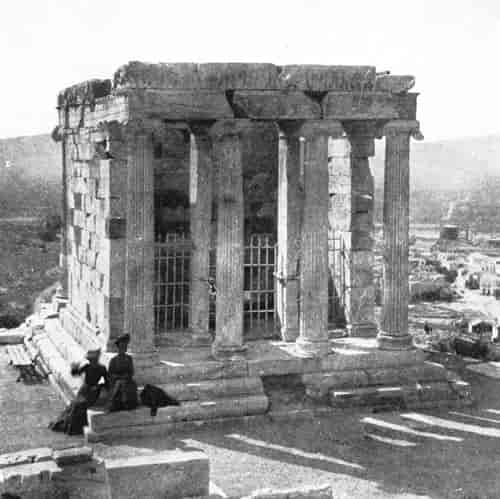 IN HONOR OF NIKE, THE GODDESS OF VICTORY.
IN HONOR OF NIKE, THE GODDESS OF VICTORY.As we stood there, we could almost hear Paul's words:
"Ye men of Athens, I perceive that in all things ye are too superstitious. For as I passed by, and beheld the gods that ye worship, I found an altar with this inscription, 'To the Unknown God.'—God dwelleth not in[Pg 104] temples made with hands.—We ought not to think that the Godhead is like unto gold, or silver, or stone, graven by art and man's device." The altar to the unknown god to which Paul referred may have been one of the many altars within sight of the elevation on which he stood.
After we left Mars Hill a few minutes' walk brought us to the foot of a long flight of ruined steps, at the top of which stood broken marble columns. Before us was the Acropolis, the highest point of the city, a rocky eminence with inaccessible cliffs on three sides. The only approach to its summit, which is about two hundred feet above the level of the modern city, is on the southwest side, being reached by the avenues we had followed up the gradual slope past Mars Hill.
"On this height," said the guide, "the Athenians, during the reign of Pericles in the golden age of Greece, erected a temple to their patron deity, Minerva, the goddess of wisdom. And to this goddess, named also Athena, who, as they asserted, sprang from the brain of Jupiter a mature woman in complete armor, they looked for protection. For her they offered their choicest gifts, yet they did not neglect the multitude of other gods whom they feared to offend."
The old guide was well informed, but his English was rather difficult to understand. He was interrupted a number of times until one of the tourists, a college professor, undertook the task of assisting him in the story.
"These dilapidated stone steps," said the professor, "formed once the magnificent marble staircase that[Pg 106] led to the gateway of the Acropolis. The staircase was seventy feet in width; in the centre was a sloping carriageway up which chariots could be driven. It was built by Pericles four hundred years before the Christian era. Statues of wonderful beauty, by famous sculptors, were arranged along the steps. At times of great rejoicing, as after a victory, triumphal processions ascended these flights to present offerings to the gods, or to deposit in the treasury of the temple the spoils taken from their enemies and to offer sacrifices and worship to their protecting goddess. The Propylæa, or grand entrance hall and gateway to the Acropolis, stood at the head of the stairway; these broken columns are all that remain of one of the most imposing structures of that golden age."
 GIGANTIC STATUES OF WOMEN UPHOLD THE CORNICE.
GIGANTIC STATUES OF WOMEN UPHOLD THE CORNICE."Keep close to the professor and never mind the guide," urged one of our companions. We followed her suggestion.
"This small building on our right with four graceful Ionic columns in front," continued the professor, "is the Temple of the Wingless Victory, so called because it was erected by the Athenians in honor of Nike, the goddess of Victory. The statue of Nike which they placed within the temple, bore in her hand the palm of victory and upheld the wreath of laurel, but lacked the customary wings. The Athenians hoped that without wings victory might never depart from the shores of Greece."
"The building to our left," said the professor as we moved on, "was named the Erechtheum after the Attic hero Erechtheus, and once contained a seated[Pg 108] figure of the goddess Athena. These six gigantic statues of women upholding the cornice of the porch are the Caryatides and deserve a careful examination; for, although carefully prepared casts of the Caryatides may be seen in some of the large museums, no cast can be a perfect representation of the original. One of these figures, as you may easily see, is only a copy, the original having been carried away to England by Lord Elgin and given to the British Museum. The marble columns on the other side of the Erechtheum are considered the best examples in existence of the Ionic style of architecture."
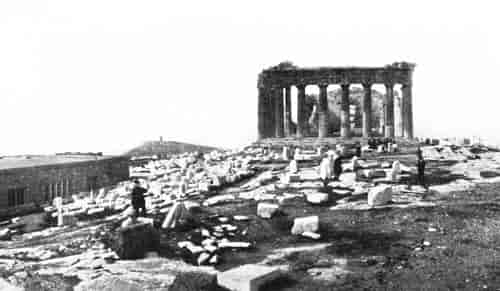 ACROSS THE SUMMIT OF THE ACROPOLIS, TRAMPLING OVER FRAGMENTS OF DECORATIONS.
ACROSS THE SUMMIT OF THE ACROPOLIS, TRAMPLING OVER FRAGMENTS OF DECORATIONS.Near the Erechtheum we passed the foundation on which had stood a colossal bronze figure of Athena, sixty feet in height, holding in her hand a spear tipped with gold, the point of which could be seen by the ancient mariners far out at sea. Making our way across the summit of the Acropolis around pieces of broken columns, trampling over fragments of decorations, and passing foundations of missing statues, we stood in front of the Parthenon, the temple which had been erected to the patron deity of the Athenians. We thought that the professor might weary of answering questions, but he seemed glad to voice the thoughts that were arising in his mind.
"In the harmonious proportions of this stately edifice," he said, "the peerless genius of the architect Ictinus, who designed the structure, is revealed, and in the delicate finish of the smallest details of the sculptured work, the wonderful skill of the artists who carried out the master's design is shown. We hardly[Pg 109] know which to admire more, the matchless genius of the designer, or the marvelous skill of the artists. Our poet Emerson truly says:
During a pause for critical examination of the front of the temple, the amateur photographers of the party placed their cameras in position.
"Place a group of people in the foreground," suggested the professor. "You see that the marble steps are nearly two feet in height, and without some object for comparison, these steps in a picture will appear to be only of ordinary size, thus an adequate idea of the size of the temple will not be given. When you see any picture of the Parthenon notice the truth of my suggestion.
"There were, as you see at this end now," continued our instructor, "eight white marble columns at each end and seventeen columns along each side. The columns on the sides are mostly broken now or altogether gone, and the color has changed from white to this soft golden yellow tint. The carved marble frieze, which, over five hundred feet in length, extended around the building, was the work of Phidias and has never been surpassed in beauty by any sculpture of the kind in the world. And these fluted columns are, in grace and proportion, the noblest examples of the Doric style of architecture."
"But, in the interior," said the professor, becoming more enthusiastic, "surrounded by statues and works of art in marble, bronze, ebony, ivory, and gold, stood the crowning glory of the Parthenon, the famous colossal[Pg 110] statue of the goddess Athena Parthenos, Athena the Virgin, forty feet in height, made of ivory and gold under the direction of Phidias. The Caryatides as we looked at them awhile ago appeared gigantic in size, but they are only eight feet in height. The height of the statue of Athena was equal to five Caryatides one above the other. Let me read you the description of the statue by an old Greek historian, Pausanias."
The professor, drawing a note book from his pocket, read as follows: "The image itself is made of ivory and gold. Its helmet is surmounted in the middle by the figure of a sphinx, and on either side of the helmet are griffins wrought in relief. The image of Athena stands upright, clad in a garment that reaches to her feet; on her breast is the head of Medusa wrought in ivory. She holds a Victory about four cubits high in one hand, and in the other hand a spear. At her feet lies a shield, and near the spear is a serpent."
"The Victory referred to by Pausanias," said the professor, replacing his note book, "was an image of the goddess of Victory half the height of the Caryatides, which we refer to for comparison. The size of the statue held in Athena's hand helps us to realize the height of the colossal figure."
"The Parthenon contained also a treasury in which the Athenians deposited the immense treasures and spoils taken from their enemies. In the course of centuries, however, the growing wealth and power of Athens incurred the jealousy and wrath of other nations. The city was conquered and ravaged many times. The Persians ingloriously failed in their attempt, but the[Pg 112] Romans, victorious under Nero, despoiled this temple and carried away hundreds of bronze statues and works of art to grace the Emperor's triumphal entry into Rome. Other Roman conquerors, following Nero's example, exhibited to the applauding multitudes in the streets of Rome long trains of spoils, consisting of the rarest paintings, ornaments, and bronzes torn from the Parthenon. Goths, Normans, Franks, Venetians, and Vandals successively plundered the city, stripping away the decorations of gold and silver from columns and walls, and breaking from their foundations the statues that adorned the plateau of the Acropolis. The Turks carried off shiploads of marble and bronzes to Constantinople. England also enriched the British Museum with many choice marbles from the Acropolis—to preserve them, Lord Elgin explained."
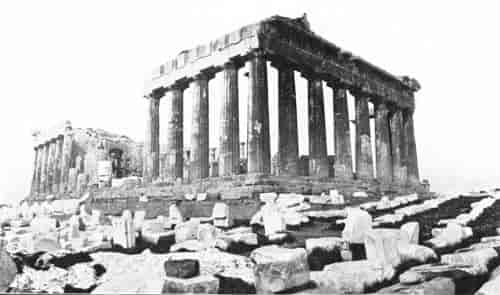 A SHELL DESCENDED INTO THE PARTHENON, THE PRIDE OF CENTURIES LAY SHATTERED.
A SHELL DESCENDED INTO THE PARTHENON, THE PRIDE OF CENTURIES LAY SHATTERED.The professor paused for a moment and his hearers made use of the time to express some very decided opinions with reference to Lord Elgin.
"But the culminating disaster to the Parthenon occurred in the year 1687," continued the professor, resuming his story with as much sadness in his voice as if the disaster had been a personal loss. "Greece was then under the rule of the Sultan, and the Parthenon was used by his army as a powder magazine. The Venetians at war with the Turks, besieging Athens, bombarded the city. A shell descended into the Parthenon, and in a moment's time the most magnificent architectural structure of ancient times, the pride of centuries, lay shattered in the ruins we see before us."
"The Parthenon in twenty-four centuries has seen[Pg 114] many religious changes. Built first as a temple of idolatry, it became under the Romans a Roman Catholic Cathedral, under the Greeks again a Greek Christian Church, and then under the Sultan's rule a Mohammedan Mosque."
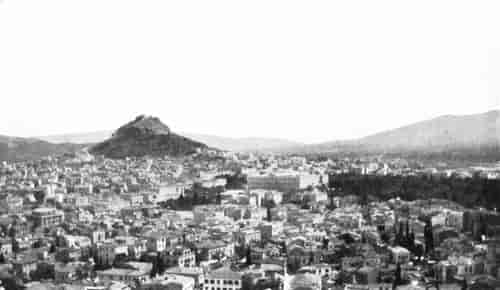 THE PREDOMINATING COLOR OF THE CITY IS YELLOW.
THE PREDOMINATING COLOR OF THE CITY IS YELLOW.The professor wished to apologize for detaining us with the length of his explanations but he was overwhelmed with expressions of appreciation for his kindness.
 THE THEATRE OF BACCHUS HAS TIERS OF STONE SEATS.
THE THEATRE OF BACCHUS HAS TIERS OF STONE SEATS."Why," said one of the tourists, "we have sailed half way around the world to see these ruins, and yet some of us have so neglected history and mythology that, we are ashamed to say, our knowledge of the history of[Pg 115] Greece and the stories of its heroes is extremely limited. I am indeed grateful and trust that you will be patient with our ignorance."
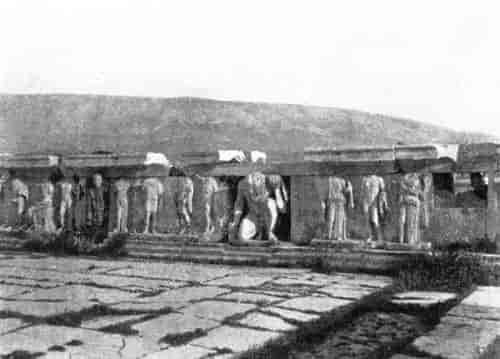 THE FRONT OF THE STAGE CARVED WITH GROTESQUE FIGURES.
THE FRONT OF THE STAGE CARVED WITH GROTESQUE FIGURES.After walking through the small museum on the Acropolis where a number of interesting relics are on exhibition, we lingered awhile on a little platform at the northeast corner of the Acropolis from which an excellent view of the city may be obtained. As seen from this view-point the predominating color of the city is yellow. The buildings erected of stone, and plastered or frescoed, are white, or yellow, or light pink, or combinations of yellow and white, and the roofs appear to be covered with yellow tiles. Below us to the right we saw the[Pg 116] ruined columns of the Temple of Jupiter, and the white palace and the royal gardens of the king. Across the valley beyond the city we could see the prominent steep rock named Lycabettus with the chapel of St. George on the summit, and ten miles away we could make out dimly Mt. Pentelicus, from which all the white marble for the temples was quarried, and Mt. Hymettus, in a region noted for the excellent quality of its honey.
Descending from the heights of the Acropolis we entered the ruins of the Odeon of Herodus Atticus which lay at the base of the Acropolis. This theatre had a stone floor, a stone stage, and tiers of stone seats capable of seating an audience of six thousand, and was covered with a cedar roof. Now the roof is completely gone and the seats are in partial ruin. Beyond this smaller theatre are the ruins of a larger one called the Theatre of Bacchus. Here the masterpieces of Eschylus, Sophocles, Euripides, and Aristophanes, in the golden days of Grecian glory, gave delight to great audiences. This theatre, accommodating thirty thousand spectators, contained a semi-circle of marble seats built up against the cliff of the Acropolis, and was open to the sky. The large stage was built of marble and the front of it was carved with grotesque figures. The lower tiers of seats nearest the stage were marble chairs reserved for priests and other dignitaries. The names of the men who occupied the chairs were carved in the marble, and some of these names are yet visible. While resting for a short time in these official chairs, we tried to imagine that we were viewing on the marble stage the performance of an old Greek tragedy by actors in the graceful[Pg 117] flowing robes of those ancient times. A few minutes later we were grouped at the side of the columns which are all that remain of the glory of the Temple of Jupiter.
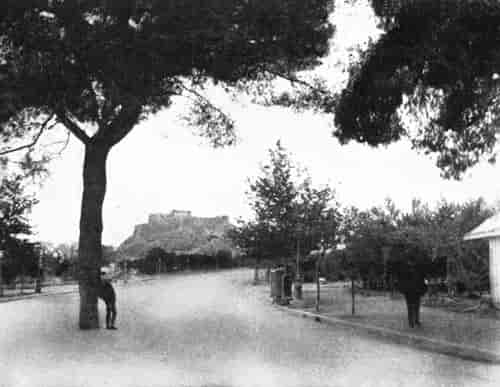 WE DROVE AROUND THE ROYAL GARDENS.
WE DROVE AROUND THE ROYAL GARDENS.The professor, responding to our request for information, said: "The Olympieum was the Temple erected in honor of Zeus, the supreme deity of the Greeks. As the Roman name for the supreme deity was Jupiter or Jove, the temple was called the Temple of Zeus by the Greeks, and the Temple of Jupiter by the Romans. The Athenians began the construction of the edifice two centuries before the birth of Christ, but the work was interrupted by wars and lack of funds and remained[Pg 118] unfinished for three hundred years. Then the Roman Emperor Hadrian, having conquered Greece, completed the work and claimed for himself all the honor and glory for the erection of the temple. The Temple of Zeus, next to that erected to Diana by the Ephesians, was the largest of the temples of antiquity. It was built in the Corinthian style of architecture and had a triple row of eight columns each at the ends, and a double row of twenty columns each at the sides. Now you see only these fifteen huge columns remaining. In the interior of the temple was a colossal statue of Jupiter overlaid with ivory and gold. Beside the statue of the god stood a companion figure of equal size representing the Emperor Hadrian. The grounds around the temple were filled by Hadrian with hundreds of statues, many of which represented himself."
Carriages which had been ordered by the managers of the excursion awaited here to take us rapidly to other points of interest. As we crossed a bridge over a little stream on our way to the Stadium, the guide said: "This river appears small, perhaps, in your eyes, but it is great in the history and legends of Greece. It is the river Ilissus."
"The Stadium," said the professor as we entered the structure, "is the immense athletic field of Athens. It was constructed about the year 350 B.C. Five hundred years later the sixty tiers of seats capable of seating fifty thousand spectators were covered with white marble. Centuries afterwards in evil times athletic sports were neglected, the place fell into disuse, and the marble was converted into lime. In modern times the[Pg 120] Stadium has been restored, perhaps not so large as before, and again the tiers of seats have been covered with white marble. In international athletic contests held in the restored Stadium, Americans have competed successfully for the laurel crown."
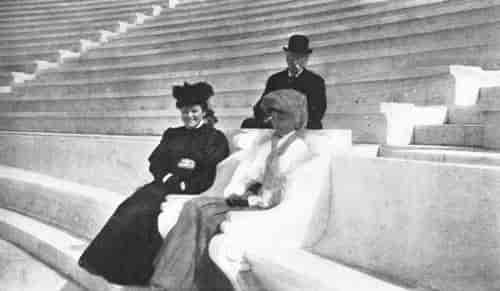 THE TIERS OF SEATS HAVE BEEN COVERED WITH WHITE MARBLE.
THE TIERS OF SEATS HAVE BEEN COVERED WITH WHITE MARBLE.Leaving the Stadium, we drove around the Royal Gardens through streets shaded by graceful pepper trees, caught glimpses of palms, orange, and ornamental trees within the gardens, and stopped a few minutes in front of the extensive white marble palace of the king. As we passed through the residential portion of the city we were impressed with the cleanliness of the well swept streets and with the purity of the soft creamy yellow and pink colorings of the buildings. Fortunately we saw no great manufacturing establishments belching forth volumes of blackening smoke to soil these delicate shades.
We halted before the University, a majestic building occupying a block on a wide boulevard, and before the Academy of Science, another large white marble edifice adjoining the University, a building much more elaborate than its neighbor, with Ionic porticoes, a facade enlivened by bright coloring and gilding, and pediments adorned with statues.
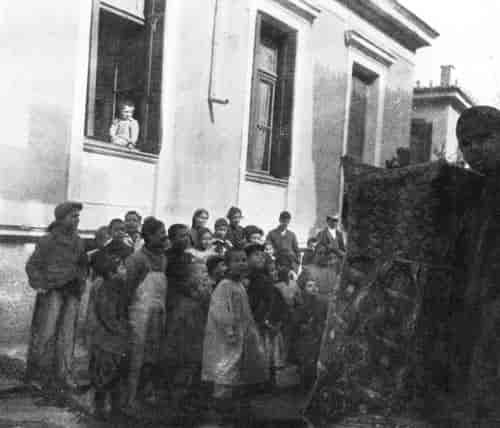 GREEK CHILDREN WERE GROUPED AROUND A PUNCH AND JUDY SHOW.
GREEK CHILDREN WERE GROUPED AROUND A PUNCH AND JUDY SHOW."What odd-looking costumes those men wear. They look like ballet girls arrayed for the stage," said one of the ladies in our carriage, pointing to a group on the sidewalk. The men wore tights, low shoes with pompons on the toes, black garters with tassels, blue jackets ornamented with many brass buttons, red skull caps with large black tassels, and very full skirts. The guide[Pg 121] said that these men were soldiers of the king's guard and though their uniforms might appear peculiar to our eyes they did not seem more strange than the tartans of Scotch Highlanders were to the Greeks. The king's guard, he told us, is composed of men from the mountain regions of Greece, who dress in the ancient military costume of that section. The uniforms of the regular Greek soldiers are very similar to those worn by the soldiers of our own country. The officers we met were[Pg 122] handsome men and especially well uniformed. The well-to-do and middle class Athenian people whom we saw on the streets were dressed in modern English style.
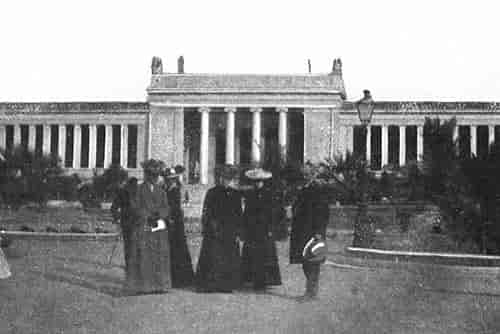 BEFORE THE UNIVERSITY, A MAJESTIC BUILDING.
BEFORE THE UNIVERSITY, A MAJESTIC BUILDING.The National Archæological Museum has a valuable collection of antiquities that would require much time for examination. Perhaps the most interesting to us were the old tombs from Mycenæ with their resurrected contents of skeletons, gold masques, ornaments, and weapons; the reduced copy of the gold and ivory statue of Athena Parthenos; the marble figure of a man in stooping position lately found in the sea; the statue of the god Hermes; and the large and beautiful vases recovered from the excavations. On the vases scenes of ancient Greek life or legend were represented.[Pg 123]
"It was a pastoral scene of love-making carved on a Grecian vase that inspired the poet Keats to write his noted poem, 'Ode on a Grecian Urn,'" said one of our friends. "Let me tell you my favorite stanza," and, with an eloquence that brought out their meaning, she repeated the beautiful lines:
On both days while in Athens we lunched at one of the hotels facing Constitution Square and ate of the delicious honey from Mt. Hymettus, returning to the Moltke in the harbor in time to have a late dinner and to spend the night. In the public park in front of the hotel the trees were laden with oranges. Beyond the park through the green foliage could be seen the white palace of the king.
While rambling through the streets we saw a funeral procession. First came many banners and symbols of the Greek Church, carried by church officials; then followed the casket borne by men, the casket open and the pale face of the dead exposed to the gaze of the onlookers; a man came next carrying the lid of the coffin filled with flowers; then priests in black robes, men and[Pg 124] women in black, and girls in white holding wreaths and flowers. The people along the way removed their hats and crossed themselves, muttering prayers as the procession passed by.
The modern religion of Greece is that of the Greek church, a religion of many ceremonies. The priests, long-haired, heavy-bearded men, wear long flowing black robes and black hats resembling our silk dress hats turned upside down with the brim at the top. They, the guide informed us, are men of influence; their hands are kissed by their people; their advice is sought, and their opinions received with deference by the members of their church.
The stores for the sale of candles to be burned on ceremonial occasions made an interesting display. There were candles of all sizes, ranging from six feet in height, beautifully decorated, which only the wealthy could afford, down to the small unadorned dip that the smallest coin might purchase.
"These candles," said the guide while we were pricing some of the decorated ones, "are used for the rejoicings at baptisms, at the festivities on wedding occasions, and for lightening the gloom around the caskets of the dead. They are given as penance to the church, or as votive offerings to brighten the altars of the Virgin or patron saints."
Eikons, the sacred memorials which the Greek Christians hang in their homes, representing the Virgin Mary holding the infant Christ in her arms, were also for sale in great numbers. Some of these were merely painted boards or silvered or gilded metal; others were of ex[Pg 125]pensive material, incrusted with jewels. In all the Eikons, either cheap or dear, the painted faces and heads of the Virgin and child were visible through openings in the metal or board.
 AND BLUE JACKET ORNAMENTED WITH MANY BRASS BUTTONS.
AND BLUE JACKET ORNAMENTED WITH MANY BRASS BUTTONS."At Easter time," said one of the dealers in ecclesiastical wares, "we sell thousands of candles for the great midnight celebration of the lighting of the candles. Just as the Easter day is ushered in, the Patriarch from his platform makes the announcement, 'Christ is risen.' The people repeat it over and over, the candles are lighted, then raised and lowered three times in honor of the Trinity, and we return to our homes to break the three days' fast by a feast of rejoicing."
When returning from the wharf to the steamer in the evening some of the tourists were conveyed in a tug and others in row boats. The oarsmen to save the labor of rowing cast[Pg 126] their lines to the tug and the dancing of the little boats on the waves as they were drawn swiftly down the bay in the wake of the larger craft caused some anxiety on the part of the more timid of the occupants.
On the evening of Tuesday, the twenty-fourth of February, just as the silver-toned bells on the Russian warships were telling the hour of five, the anchor of the Moltke was drawn up and the vessel almost imperceptibly moved around and headed for the narrow outlet between the breakwaters. As we slowly steamed away from the Russian vessels, our band played the Russian national hymn and the Russian flag was elevated to the top of the Moltke's mast in a farewell salutation. Immediately the crowds of Russian sailors on the warships removed their hats and remained bareheaded until the music ceased. Then, in response, the Russian band played our national hymn, and as we sailed away, the strains of the music became fainter and fainter until they died away in the distance.[Pg 127]
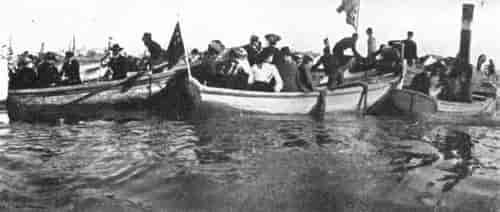 SOME IN A TUG AND OTHERS IN ROWBOATS.
SOME IN A TUG AND OTHERS IN ROWBOATS.Looking backward after leaving the harbor we saw clearly defined, in the golden evening light, the towering Acropolis and the Parthenon crowning its summit, and, as we sailed away from the city which was once the centre of culture, refinement, and wealth, we tried to recall the stories of her glorious past. The figures of legend, myth, and history,—mighty warriors, celebrated heroes, eloquent orators, illustrious painters, renowned architects, great historians, immortal poets, and wonderful deities; Spartan mothers, Thermopylæ defenders, and Persian invaders; beautiful Helen, muscular Hercules, crusty Diogenes, deformed Æsop, silver-tongued Demosthenes, fleet-footed Mercury, drunken Silenus, stately Juno, and lovely Venus,—a confused procession of mortals and immortals rushed across the brain.
"Look," said the professor with note book in hand interrupting our dreams of the past, "that strait to the left behind us is the entrance to the bay of Salamis where the Persian fleet of one thousand sail encountered the smaller fleet of only three hundred Grecian vessels in the year 480 B.C. The rocky brow of the hill on the farther side of the strait is the place where the haughty Xerxes sat in his silver-footed chair to gloat over the expected annihilation of Greek power. I want to read to you, before we go to our evening meal, the vivid description of the conflict from the tragedy of 'The Persians.' It was written by the poet Eschylus, who himself was one of the heroes in the fight.[Pg 128]"
CHAPTER VIII.
CONSTANTINOPLE AND SANTA SOPHIA.
On Wednesday morning, February twenty-fifth, the ladies donned winter wraps and the gentlemen heavy overcoats for their morning promenades on deck. All night the Moltke had steamed northward and the region of palms and orange trees had been left behind. By referring to the large atlas of the world in the library, we found that we were in the same latitude as that of New York City.
As we approached the entrance to the Strait of Dardanelles, the ancient Hellespont, which connects the Ægean Sea with the Sea of Marmora, the Turkish fortifications crowning the hills on both sides of the channel were plainly visible. Under the great guns of the fortresses the Moltke anchored.
"Why do we stop here?" inquired one of the tourists of the surgeon, who was standing near watching the shore.
"This is the quarantine station," replied the doctor, "and we must wait here for the official inspection. According to Turkish regulations, the passage of foreign warships through the Dardanelles is absolutely prohibited at any time and merchant vessels are not allowed to enter during the night. Every vessel arriving here must undergo inspection before receiving a permit to proceed. The Sultan guards this gateway to the most[Pg 130] vulnerable part of his dominion, not only to prevent the entrance of a hostile fleet, but to protect his people from the incursions of that insidious foe, the plague, which sometimes ravages the Eastern countries. There come the officials now in response to our signals," he added as a yacht steamed out from the shore. "I must go with the captain to welcome them at the head of the gangway."
 I. WITHIN SIGHT OF DOMES AND MINARETS.
I. WITHIN SIGHT OF DOMES AND MINARETS. II. FAMOUS ST. SOPHIA HAS FOUR MINARETS.
II. FAMOUS ST. SOPHIA HAS FOUR MINARETS.The Turkish quarantine physician in red fez and handsome fur overcoat, accompanied by his assistants and the inspector, came on board. Madam Rumor whispers that a good sized tip sometimes obviates tedious personal examinations and insures prompt issuance of a clean bill of health without exasperating delays. However it was, the quarantine physician, after consulting with the ship physician, quickly found the health conditions satisfactory, and the inspector of cargoes granted his permit. The pilot who was to guide the vessel through the swiftly flowing current of the Hellespont joined us here, and with him came the dragoman or chief guide who had been engaged by the managers to take special charge of the sight-seeing excursions of our party while in Constantinople.
Proceeding slowly on our way, we noticed half a dozen Turkish warships lying in the stream near by. One who claimed to know said that the Turkish naval vessels had been gathering barnacles and mussels for four years and were unfit for active service. But the fortresses guarding the strait, he said, were in excellent condition and well equipped with batteries of modern make.
The Strait of Dardanelles, for a distance of forty miles[Pg 131] separating the continent of Asia from that of Europe, varies in width, narrowing to less than one mile at some places and broadening out to four miles at others. By referring to the steamer's atlas, consulting guide books, exchanging historical knowledge, and questioning good-natured officials, the tourists obtained information about the various points of interest that they were passing. Beyond the entrance, at the narrowest point of the strait, the place was pointed out where the Persian king Xerxes with his vast army crossed the channel on a bridge of boats for the invasion of Europe in the year 480 B.C.
"Little then," remarked a tourist, "did that imperious invader dream that within a year, in humiliation and defeat, and with only a poor remnant of that great army, he would recross that strait to Asia again."
At the same place in the channel, we were informed, Alexander the Great with his Greek legions crossed from Europe in the year 334 B.C. and continued his victorious march until all the then known portion of Asia was subdued to his rule.
"Then," said another tourist, "when flushed with victory, he wept for other worlds to conquer. To me the saddest part of Alexander's history is that he was himself conquered by his own appetite and never returned to his native shore."
Another tragic tale connected with that place is the story of Hero and Leander. Across that mile of swiftly flowing current, the story says, Leander nightly swam from Abydos to the tower on the opposite shore to visit his beloved Hero, the priestess of Venus. In one of his[Pg 132] nightly excursions the swimmer was drowned in a storm, and Hero, after hearing of Leander's death, despairingly threw herself into the sea to share his sad fate.
"There is the height from which Hero cast herself," said an official, "and this is the place where Lord Byron, in emulation of Leander, performed the same difficult feat of swimming the channel."
To the right, on the Asian shore not far away, was the plain of Troy where Dr. Schlieman won fame by making the excavations and discoveries which led to the location of the lost city of Troy. In this ancient city of Troy, according to Homer, the beautiful Grecian princess Helen, abducted by Paris, the son of the King of Troy, was detained for ten years. The enraged Greeks under Ulysses and Ajax, seeking to rescue the princess, besieged the city and finally succeeded in entering its gates and accomplishing their purpose by means of the stratagem of a huge wooden horse.
After sailing through the length of the Sea of Marmora, about one hundred and ten miles, we arrived at five o'clock in the evening within sight of the domes and minarets that crown the promontory at the entrance to the Strait of Bosporus. From the time we caught our first glimpse of a distant minaret, until the anchor of our steamer was dropped in the channel, every tourist was intent on the picturesque views which presented themselves. While the Moltke was steadily moving onward and our point of view continually changing, the dragoman at intervals pointed out the various places of interest, now on one side, now on the other.[Pg 133]
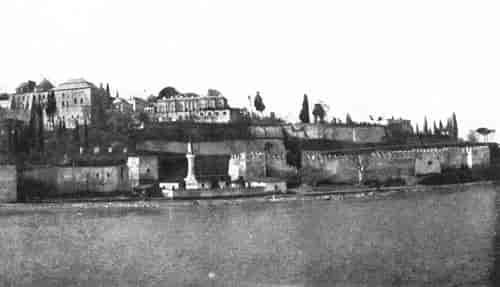 IS CALLED SERAGLIO POINT.
IS CALLED SERAGLIO POINT."The Strait of Bosporus, which we are now approaching, is here a little over a mile in width," said he. "The part of the city you see on the headland on the north shore of the Strait is the oldest part of Constantinople, and is called Stamboul. It is occupied principally by Turks, Greeks, Armenians, and Jews. The most celebrated mosques, and also the great bazaars in which tourists delight to wander, are in Stamboul."
"That dome with six minarets surrounding it, partially hidden by the intervening trees and buildings, is the Mosque of Ahmed, one of the most interesting in the city. Beyond it you can see the dome and four minarets of the more famous St. Sophia. The name of this is probably familiar to you, for almost every visitor whom I have escorted has told me that he had heard of the Mosque of St. Sophia."
"And that is Scutari," he continued, calling our attention to the city on the Asiatic shore of the strait. "The great square yellow building so prominent on that side is the military barracks. The large structure nearer us is the military hospital where the English lady nursed the soldiers during the war with Russia fifty years ago. Perhaps you have heard of the lady?"
We informed the dragoman that the noble work of Florence Nightingale during the Crimean war was well known to the American people, and her name held in high honor by them.
"The point beyond us on the left," said the guide a few minutes later, "is called Seraglio Point. The portion of the city on the promontory, extending along the Bosporus, is about one mile in length and half a mile[Pg 135] in width and is called the Seraglio. In these extensive grounds are the well guarded Treasury buildings containing the accumulated treasures of centuries, the Imperial Museum of Antiquities, and many other public edifices. There also are the palaces, kiosks, and gardens, which were occupied by the Sultans and their families until the present Sultan changed his residence to another part of the city.
"The stream of water to our left," he added as our steamer rounded Seraglio Point, "is called the Golden Horn, so named on account of its curved shape. This inlet of the Bosporus, not over one-third of a mile in width, separates the older Stamboul from old Galata and newer Pera. Over the two bridges across this inlet streams of people pass constantly. Galata is the business section of the city which includes the wharves, steamship offices, and wholesale establishments. Pera, situated on the heights above Galata, contains the residences of the wealthier class, as well as hotels, modern stores, and the residences of the ambassadors and consuls."
After passing the mouth of the Golden Horn, the Moltke slackened speed and anchored in the Bosporus apposite Galata, a little way from the shore. Prominent on the shore at the water's edge, not far from our anchorage, stood a small but beautiful white mosque with delicate minarets, and just beyond it a snow white palace of magnificent size.
"The white marble building that you see extending for some distance along the Bosporus," said the guide, "is the Dolmah Bagcheh Palace of the Sultan, one of the[Pg 136] magnificent palaces which he does not occupy. Once or twice a year he holds a reception there. In the distance along the water is the Cheraghan Palace where the imprisoned ex-Sultan Murad, the elder brother of the present Sultan, for many years had every luxury but liberty. And on the heights just beyond those grounds is Yildiz Kiosk, the palace where now lives the present ruler of Turkey, his Imperial Majesty, Sultan Abdul Hamid. Strangers are not permitted to enter its gates, but we have obtained his Imperial Majesty's permission to take your party through the Dolmah Bagcheh Palace."
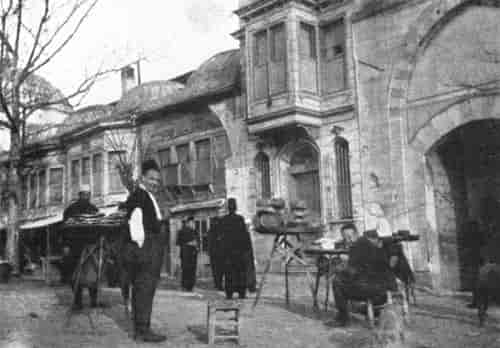 THE BREAD DEALERS CONSENTED TO BE KODAKED.
THE BREAD DEALERS CONSENTED TO BE KODAKED.Our steamer had barely anchored when a steam[Pg 137] yacht flying the emblem of Turkey, a red flag with a white crescent and star, appeared alongside. Several red-fezzed Turkish officials, on whose green frock coats dangled medals and badges, mounted the stairway to receive the report of the vessel and examine and visé the passports of the passengers. The stewards collected the passports and handed them to the Sultan's officers, who afterwards returned them stamped in queer-looking characters with the official seal of the Turkish government.
"Captain, can you not send us ashore?" requested some of the tourists after the evening dinner was over.
"I would gladly send you ashore if I considered it safe for you to go," replied the Captain, "but I advise you to remain on board. There is little to be seen after sunset in this unlighted city. Although the principal streets are lighted with gas, many of the streets depend upon the moon and stars and so on cloudy nights are left in utter darkness. Strangers may with safety wander around the city during the day, but it is dangerous for them to do so at night. The lower part of the city along the wharves is infested with thieves who have little regard for the life of an infidel, and who under cover of darkness would cut one's throat and cast the body into the stream in order to secure a few valuables."
The Captain's advice was taken and the evening was delightfully spent on the vessel. The American Consul and his wife came on board to meet some friends and to welcome all the Americans. Then, according to a plan which had been made by the managers of the tour, a resident of the city delivered an instructive address on[Pg 138] the history of Constantinople. The lecturer told of Constantine the Great, first Christian emperor and founder of the city; of Justinian, the imperial legislator and builder, and his empress Theodora, the beautiful comedian who became a queen; of the heroic warrior Belisarius and his emperor's ingratitude; of the Greek girl Irene who rose to supreme power; of the bloody religious riots and theological disputes; of the Nicene Council and adoption of the Nicene creed; and of the pillage of Constantinople by the ruthless Crusaders. He told also of the marriage ceremonies, of the art and commerce, and of the places of interest about the city. His remarks about the former trade and literature of the city were most interesting.
"During the earlier centuries of the Eastern Roman Empire," said the lecturer, "Constantinople, the capital, was a great centre of trade, an exchange market for the products of the world. Caravans brought the treasures of the East to the storehouses here to be bartered for the cargoes of produce which came in ships from the West. This exchange brought wealth and prosperity to the city. In later centuries the Venetians and Genoese succeeded in transferring much of this business to Venice and Genoa and the trade of Constantinople declined. In modern days steamships and the Suez canal have completely changed the route of commerce.
"Constantinople, not only was a centre of trade, but in the Twelfth and Thirteenth centuries it was the centre of literature. During the dark ages, when the study of literature was generally neglected in other places, the lamp of learning burned brightly in this city.[Pg 140] Libraries were established and manuscripts accumulated; but at the time of the Turkish invasion a multitude of the most valuable documents were destroyed. When the Renaissance brought new life to the western shores, the centre of literature moved to Italy, and printed books took the place of manuscripts."
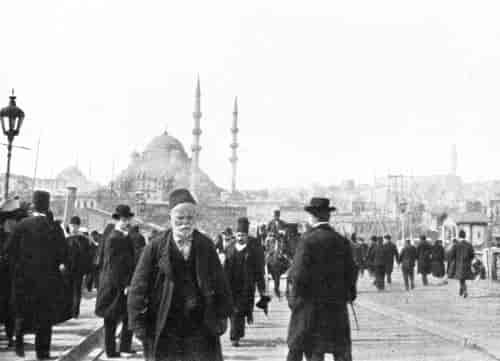 OUR CARRIAGES RATTLED OVER THE PLANK BRIDGE.
OUR CARRIAGES RATTLED OVER THE PLANK BRIDGE.When we thought of the present standing of Turkey among the nations of the world, it was difficult to realize that for centuries Constantinople was the commercial centre and the brilliant capital of the world. It was even more difficult to realize that the country which now prohibits the importation of foreign books and papers was at one time the patron of art, literature, and learning, the collector of great libraries of illuminated manuscripts, theological discourses, and legal documents. But that was centuries ago.
Thursday morning ushered in a bright, clear, cool day. We were up early, eager for sight-seeing, and little boats soon carried us to the custom house pier on the Galata side. Open carriages drawn by wiry Turkish horses and driven by Turkish drivers were there in readiness to carry us across the Golden Horn to explore the sights of Stamboul. As our carriages rattled over the plank pontoon bridge with its drawbridge in the center, we passed through a crowd of people more varied as to nationality and costume than can be seen at almost any other place on the globe. The Turks, of course, predominated, their nationality being indicated by the national head-gear,—the red fez. The wealthier Turks wore the English style of clothing and the red fez. The costumes of the other classes varied according to their[Pg 141] occupation. On the bridge as our driver guided his team through the throng, we saw Turkish soldiers in blue uniforms and red fez; Moslems wearing a green sash around the fez to indicate that they had performed a pilgrimage to Mecca; stately-looking bearded Greek priests in black robes and peculiar hats; Nubians with black glistening skins and tattooed faces; Moslem priests with pure white turbans, and Moslem priests with high green turbans; Russian or Hungarian peasants with coats of sheep skin, the fleecy sides of which were[Pg 142] turned inward; Dervishes in brown mantles, and high-coned brown hats without brims; Hebrews in long yellow coats and little curls at the sides of their heads; Turks in gold embroidered trousers and jackets and long flowing blue sleeves; Turkish women with faces closely veiled, and negro women who concealed their features behind white veils in the same manner as the Turkish women.
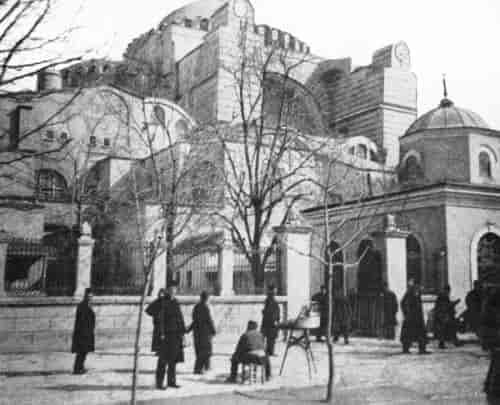 A STRUCTURE DIFFERING IN DESIGN FROM ANY OTHER CHRISTIAN TEMPLE.
A STRUCTURE DIFFERING IN DESIGN FROM ANY OTHER CHRISTIAN TEMPLE."Those cakes looked so good, I was almost tempted to take one off the tray," said one of the occupants of our carriage, as a peddler carrying on his head a table filled with cakes and pastry passed so closely that his wares were within reach.
"Oh, how could you think of doing such a thing," hastily exclaimed her companion, horrified at the thought, "we should all be placed in a dungeon and our pleasure ended."
Peddlers of dates, bearing their stock of fruit in huge baskets on their backs and carrying scales in one hand, held up a sample of dates towards us with the other hand; dealers in nuts in the same manner carried and offered their wares to the passers-by; peddlers of "Turkish delight" and other sweetmeats arranged the candies on their trays in an attractive manner; and the sherbet sellers called attention to the pink liquid in large glass bottles suspended on their backs. At each end of the bridge were half a dozen toll collectors in long white overshirts who stood in line across the way collecting the toll of ten paras, or one cent, from each person that crossed.
"How clearly that dome and the two minarets stand[Pg 144] out against the sky," exclaimed one of the party, pointing to a great dome and two delicate minarets with tapering peaks which rose above the buildings directly in front of us on the other side of the bridge.
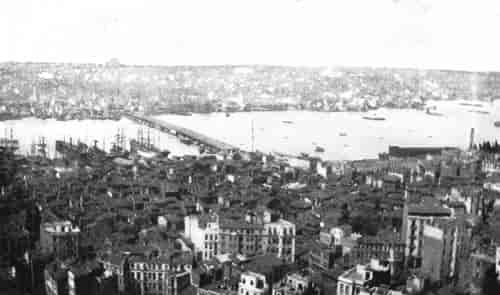 THIS STREAM FLOWING INTO THE BOSPORUS IS CALLED THE GOLDEN HORN.
THIS STREAM FLOWING INTO THE BOSPORUS IS CALLED THE GOLDEN HORN."That is the Mosque where the Sultans and their families went to prayer when they resided in the Seraglio near by. We will not stop at this Mosque but will go directly to the Mosque of St. Sophia."
"Professor," said the lady who in Athens had confessed her ignorance of history, "please give us some information about the church of St. Sophia while we are grouped here together in front of the building."
The professor expressed his willingness to do so, provided we were willing to take the time to listen.
"In the year 532 A.D.," said he, "Justinian, the Emperor of the Eastern Roman Empire, decided to erect in Constantinople a church that should be a glory to the city and an honor to his name. His desire was to build one 'such as since Adam has never been seen,' a structure differing in design from any Christian temple previously constructed and surpassing in magnificence any temple that afterwards might be built. The empire was then at the height of its power and glory, and Justinian, in emulation of Solomon, made demands on all the countries under his dominion for contributions of ivory, cedar, gold, silver, precious stones, and the rarest marbles.
"In order to attain his ambitious design, the monarch robbed the Temple of the Sun at Baalbek of columns of porphyry, despoiled the Temple of Diana of Ephesus of its finest pillars, took columns of pure white marble from the Temple of Minerva at Athens, and divested the[Pg 145] shrines of Isis and Osiris in Egypt of their choicest granite columns. He called upon the quarries of Italy, Greece, and the Ægean Isles for marbles of every hue produced by them, so that, when completed, the temple should contain the most beautiful marbles the world could yield, and these he ordered to be highly polished and artistically arranged. To hasten the construction, ten thousand workmen under the direction of one hundred architects were employed, and in less than six years the immense structure, 'the great Church of Santa Sophia, or Heavenly Wisdom,' one of the most famous churches of the world, was ready for dedication.
"The great altar was built of silver and gold, the seven chairs of the bishops were plated with silver, the crosses and crucifixes were composed of pure gold, and the altar cloth and vestments were encrusted with precious stones. Jeweled images of saints, sacred paintings of fabulous value, and holy relics to be adored by kneeling worshipers, were arranged around the walls of the building. The huge doors of the temple were made of cedar, ivory, amber, and silver; the ceiling glistened with golden mosaics; the walls shone with polished marbles: and the capitals of the columns were laced with delicate carvings inset with mother-of-pearl, silver, and precious stones.
"On the day of the dedication of the temple a jubilant procession of patriarchs, bishops, priests, and people, in admiring wonder, entered the completed building with songs and rejoicings. The Emperor, at the head of the procession, overcome with pride and joy in the glorious consummation of his purpose, threw himself upon the[Pg 146] floor and exultingly exclaimed: 'Glory to God who has deemed me worthy to accomplish so great a work. O Solomon, I have surpassed thee!'
"In this sanctuary for over nine centuries the people worshiped God according to the Christian faith in great pomp and with much ceremony. The bishops officiated at the golden altar reading from golden lettered manuscripts, and were assisted in the service by scores of richly robed priests and hundreds of selected musicians, while the air was filled with the fragrance of rising incense. But during the latter part of the Middle Ages while the power and glory of the Roman Empire was gradually declining, the rival Mohammedan Turkish Empire in Asia was rapidly ascending to a dominant position. Finally, in the year 1453 A.D., the Sultan of Asiatic Turkey, Muhammed II, determined to obtain possession of Constantinople and make the city the capital of his empire. His army besieged the decadent city and captured it after a struggle of fifty-three days. When the Turkish troops entered in triumph they tore the emblems of Christianity from their places and, instead of the cross of the Christian, they raised the crescent of the Moslem.
"In the church of St. Sophia the conquerors tore down the golden altar, melted the silver plates, removed the images of saints, painted over the sacred pictures, and took away the jewels and precious stones, changing the interior to suit the simpler worship of the followers of Mahomet. The name of the building was changed and it was thereafter known as the Mosque of Saint Sophia. For four hundred and fifty years the Mosque[Pg 147] has been in possession of the Turks. Its doors are open at all times for Moslems to enter freely; but the entrance is carefully guarded to keep Christian or foreign visitors from intruding. The latter, however, may gain admission by paying an entrance fee of forty cents, and removing their shoes at the door or lacing over their shoes the loose slippers that are provided for this purpose."
 THREE MEN RAISED THE BURDEN TO HIS SHOULDERS.
THREE MEN RAISED THE BURDEN TO HIS SHOULDERS.On the porch of the Mosque we put our feet into the loose slippers, a Moslem attendant tied them on as carefully as the clumsy things could be tied, and then, accompanied by him, we entered the building. The immense floor, an acre in size, was covered with handsome heavy rugs. As we slid, rather than walked, over the soft Turkish carpets, our turbaned guide, with sharp, piercing, black eyes, watched carefully to see that our slippers did not become unfastened and drop off, and our infidel shoes profane the holy enclosure. And when one of the visitors laughed within the sacred edifice, the attendant's black eyes flashed with anger.
It was not the regular hour for prayer in the mosque, but a number of worshipers were devoutly kneeling at different places in the interior, with faces turned toward a black stone in the south wall, which indicated the direction of the holy city of Mecca. Others, squatting on their bare heels, were reading or reciting in monotonous tones parts of the Koran. There are no benches or chairs in the building; Moslem worshipers do not require seats while at their devotions. The great dome, over one hundred feet in width, rises in grandeur one hundred and eighty feet overhead, supported by four huge columns each seventy feet in circumference. A circle of windows, forty-four in number, around the dome illumines the golden mosaics which cover the ceiling. A mosaic picture in the dome representing the Almighty, has been obliterated by the Turks and covered with green linen cloth. A verse from the Koran, in gilt Arabic characters almost thirty feet long, is painted on this cloth. The sentence, as[Pg 150] translated, begins: "God is the light of heaven and earth," and ends, "God alone sheddeth His light on whomsoever He pleaseth."
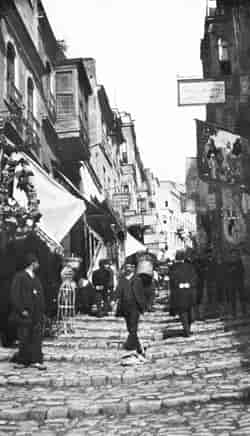 THROUGH THE NARROW STREETS OF THE CITY.
THROUGH THE NARROW STREETS OF THE CITY."If the Moslems believe in the Bible and in God as a supreme being, why did they destroy the mosaic representation of God on the ceiling?" inquired one of the visitors.
"The Moslems do believe in the Bible and in one Supreme God," was the reply, "and it was this very belief that led them to paint out the picture of God and to destroy all the images and paintings of saints; for God's command is: 'Thou shalt not make unto thee any graven image, or any likeness of anything that is in the heaven above, or that is in the earth beneath, or that is in the water under the earth. Thou shalt not bow down thyself to them.'"
"The Moslems," continued the guide, "regard Mahomet as the Prophet of God, and the Koran as written by him under the inspiration of God; but they do not worship Mahomet or any image or picture of him."
We paused to admire the four green marble columns taken from the Temple of Diana, and the polished shafts brought from the Temple of the Sun, relics of those two magnificent cities, Ephesus and Baalbek, of whose grandeur nothing now remains but broken stones. We gazed upward at the eight immense green shields covered with Arabic characters, high above our heads on the walls. But we doubted the miraculous healing power of a small hole that is always damp in a bronze-covered pillar, and hesitated also to accept the tradition[Pg 151] that the apparent imprint of a bloody hand in the marble wall was made by the Sultan Muhammed II when he rode into St. Sophia after the capture of the city.
"On Fridays," said the guide, as we stood at the foot of the marble steps that led to the elevated pulpit, "the priest, clad in a long red robe, reads a prayer for the Sultan, and, while doing so, holds in one hand the Koran and in the other a drawn sword to indicate that this temple was captured from the Christians by force."
"That prayer rug," he continued pointing to a beautiful carpet hanging on the wall near by, "was the personal prayer rug of the great conqueror Muhammed II. There is so much more to be seen," he added, "that we could spend the whole day here, but the dragoman is beckoning and we must go on."
We shook the slippers from our feet in the porch and were driven through narrow streets to the Grand Bazaar.
"The Grand Bazaar," said the guide, "covers several acres. It has one hundred entrances. There are twelve hundred narrow streets or passages under roof within the bazaar and on these streets are four thousand little shops."
The Grand Bazaar, we decided, was the enormous department store of Stamboul; but we noticed that each little shop had its own proprietor. To many of the visitors, this Bazaar was the most interesting place in Constantinople; for here were found the most tempting bargains in Oriental wares, in its narrow passages were seen the native people in their most picturesque costumes, and in its maze of dimly lighted corridors some tourists were lost for awhile and met with novel adventures.[Pg 152]
The store of Far-Away-Moses was one of the largest and most popular of the shops in the Bazaar and that genial trader did a thriving business. There seemed to be a magnetic power that drew the guides in the direction of certain shops, an unseen influence that urged them to recommend certain places, and one of these places was Moses' emporium. Some of the ladies found that when they slipped away and entered a shop without a guide a better bargain could be secured.
The price named for articles in the bazaar shops by the fezzed or turbaned dealers was generally three times the price that they would accept before losing a sale; but much tact was required on the part of the purchaser, and much valuable time was occupied in the diplomatic struggles between the acute Yankees and clever Moslems. When, however, the battle was won and the desired article secured at one-half or one-third the price at first demanded, the joy of the purchaser was doubled. The person, who, after an hour's dickering, bought a bronze ornament for twenty piasters, or one dollar of American money, was just as happy over the bargain as the one who succeeded in purchasing a magnificent silk rug for twenty thousand piasters. The money drawers of the Moslem traders were swollen with their contents but their shelves were less crowded when the Americans left the bazaar.
When we returned to the vessel we found that during our absence the decks had been converted into a rival bazaar. The tourists who had failed to obtain souvenirs had another opportunity to buy them; for here were displayed silk rugs ranging in price from three thousand[Pg 153] piasters downward, exquisite embroideries, rare silks, delicate fans, gold-laced shawls, fragrant attar of roses, and a multitude of articles in bronze, silver, and gold.
"How restful it is to recline lazily in our comfortable steamer chairs rolled up in a rug, dreaming or talking over the events of the day, without any cares or worries to disturb our thoughts," remarked one of our friends as we sat upon the deck in the later evening hours watching the glimmering lights on the shore.
"Yes," said another, "there seems to be nothing to disturb the serenity of the night; even the distant barking of the dogs appears to be in harmony with the soft lapping of the waves against the vessel. I feel that I shall rest to-night in my berth, as Shakespeare says, in a 'sleep that knits the ravel'd sleeve of care,' after the exertion of a full day of sight-seeing."[Pg 154]
CHAPTER IX.
THE SELAMLIK AND THE TREASURY.
One dark night in the faraway past, so the story runs, the barking of dogs in the outskirts of Constantinople wakened the sleeping garrison in the city, warning them of the approach of a crafty foe who sought to surprise and capture the place. At the same time, the young moon, coming out from under a cloud, revealed the position of the enemy. The barking of the dogs and the light of the crescent moon enabled the garrison to frustrate the designs of their foes and save the capital from capture. Since then the nightly howlings of the dogs have been tolerated by the Turkish people and the crescent has had a place of honor on the Turkish banner. To kill a dog is an unpardonable offense. The dogs, however, are not well fed, well groomed pets, fondled, kissed, collared, and blanketed, as in some other countries; but are ownerless, homeless creatures roaming at night in great numbers through the streets and sleeping by day on the thoroughfares and sidewalks regardless of passers-by. The people step over or go around the sleeping animals and do not disturb them. The dogs seem to know their privileges, for they will not move out of the way.
The city is noted for its dogs, not on account of their beauty or breed, for they are a disreputable lot of mongrel curs and bear the marks of many nightly brawls,[Pg 156] but on account of the legions of them and their usefulness as scavengers. At nightfall the residents of Stamboul empty their garbage cans in the streets and the dogs, howling and fighting, dispose of every scrap before daylight. When a Turk desires to express the utmost contempt for a person he calls him a dog.
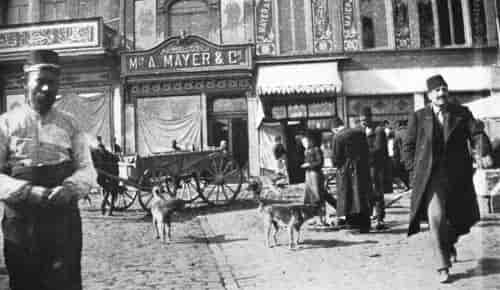 THE DOG FIGHT HAD JUST ENDED.
THE DOG FIGHT HAD JUST ENDED."If you wish to avoid trouble while in this city," cautioned the dragoman, "neither disturb a sleeping dog in the highways,—for the dog will resent the interference with his slumbers,—nor call a Turk a dog, for the anger of a Turk thus reviled is uncontrollable until the offender who called him by that vilest of epithets is severely punished."
A drive of one and a half miles along the Grand Rue de Galata, one of the wider thoroughfares in Galata parallel to the Bosporus, carried the tourists from the custom house pier to the gates of the Dolmah Bagcheh Palace. The entrance to the grounds of the palace is through a gateway of marble, beautiful in design and richly ornamented with elaborate Corinthian columns and delicate carvings of garlands, wreaths, and urns.
While we gazed at the carvings, the officer in charge of the guard carefully examined our permit. Then the massive gates were swung open for our entrance. Within the palace we ascended a magnificent wide marble staircase, the balusters of which were made of clear glass. We admired the intricately carved alabaster bath-rooms and wondered if their neatness had ever been disturbed. We passed through a multitude of richly decorated chambers and salons where every article was arranged in perfect order, and walked on[Pg 157] carpet strips laid for visitors' feet around the beautiful ball-room, not daring to tread on the highly polished hard-wood floor. Every apartment of the palace was immaculate, and resplendent in marble, porcelain, inlaid woods, and golden mosaics. The largest mirror in the world reflected the passers-by and costly paintings attracted the eyes of the visitors. The dark green malachite and the rich blue lapis lazuli harmonized pleasingly with yellow gold and white marble. And yet this grand show palace is unoccupied except by the hundreds of care-takers required to keep it in order. Its quiet is disturbed only by sight-seers who pay for the privilege of inspecting the stately apartments, and, on rare occasions, by imperial receptions which are held in the throne room. This immense apartment surpasses all the others in the elegance of its adornment. The dome overhead and the walls and the Corinthian columns which surround the room are richly decorated with oriental designs in white and gold. From the centre of the dome hangs a crystal chandelier noted for its size and beauty.
"In this throne room," said the guide, "five thousand persons can stand. On the day after the close of the Fast of Ramazan, which is the first day of the Feast of Bairam, the Sultan drives here from Yildiz Palace, along a road lined with soldiers, and holds a State reception. Several thousand of the nobility assemble in this room and the Sultan, seated on that crimson and gold sofa, receives the homage of his officials. The generals of the army in gorgeous uniforms, the heads of the religious orders, holy men, and state officials[Pg 158] approach according to their rank and make their obeisance to his Imperial Majesty. They reverently kiss the hem of his Majesty's garment, press the hem to their foreheads as a seal of their declaration of loyalty to his person, and then retire backward from his presence. During the reception every face in the assembly is turned toward the Sultan. To turn one's back to his Majesty, even for a moment, is unpardonable. That day after Ramazan is a great day in the city; cannons thunder, the bands play, the mosques are illuminated at night, and the people feast and rejoice."
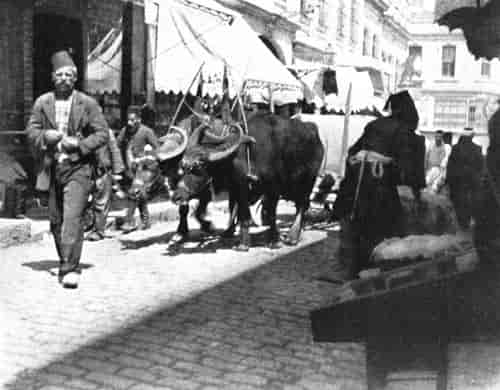 A TEAM OF GREAT HORNED OXEN.
A TEAM OF GREAT HORNED OXEN."What is the Fast of Ramazan and when does it occur?"
"The Fast of Ramazan," replied the guide, "is kept through the whole month of Ramazan, which corresponds to your month of September. For thirty days the Moslems do not eat bread nor drink water during the hours between sunrise and sunset. After sunset they may refresh themselves. The Prophet commanded that one specially named day in the month of Ramazan should be kept as a fast day; but the date of that particular day was somehow lost, and now, in order to make sure of keeping the fast on the day appointed, the Moslems keep every day in that month as a fast day. The Feast of Bairam immediately follows the end of the fasting. This festival consists of three days of feasting and festivities."
Friday is the Mohammedan Sabbath, but we could not see that it made much difference in the traffic of the city. We asked the guide if the Turkish bazaars would be closed.
"No," he replied, "but more of the faithful attend mosque on Friday than on other days, and on Friday each week the Sultan goes to his special mosque with great ceremony."
The Sultan's weekly visit to prayer is called the Selamlik or Sultan's Procession to Mosque. Our guide obtained a good position for our carriage in an open square near the mosque from which to see the procession. The parade was not to occur until one o'clock, but in order to secure the place we were there at eleven. The time of waiting was not tiresome as there was much of interest[Pg 160] going on around us all the time. Carriages of other visitors assembled in the open square; cabs containing invited dignitaries rolled up to the ruler's palace, which was within sight about one block away; guards drove the crowds from the streets; regiments of red-fezzed infantry tramped by and formed in lines along the street between the palace and the mosque; mounted lancers with flying pennons trotted to their positions; and the bands took their place near the palace. Uniformed policemen and spies in plain clothes circulated among the carriages and sight-seers, watching closely for suspicious characters, and listening to remarks made by visitors. We were advised by our dragoman not to mention the name of the Sultan.
"How the Turks do enjoy their coffee," said an occupant of our carriage, calling attention to a group squatting on the ground with cups in hand.
Near our carriage a Turk was making coffee on a portable stove and selling the beverage to thirsty customers; an itinerant barber placed his portable stool beside our carriage wheel, opened his kit of tools and was soon busy lathering and shaving dusky faces; a water peddler with his jar on his back played a tune on tumblers by rubbing them with his fingers; a cake peddler's table was upset by passing dragoons and he mournfully picked up the fragments. The trays of the Turkish peddlers of candies and cakes were clean and the articles offered appeared fresh and appetizing. We yielded to temptation and bought some "Turkish delight" and some light flaky biscuit, and, after eating the dainties, wished for more.[Pg 161]
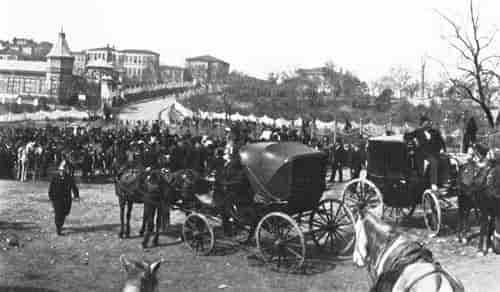 THE TIME OF WAITING WAS NOT TIRESOME.
THE TIME OF WAITING WAS NOT TIRESOME."It is nearly one o'clock," said the guide looking at his watch.
The street cleaners were hastily giving a final polish to the roadway over which the Sultan would drive between the lines of soldiers. A dozen carts filled with clean sand that had been standing near us were hurried up the hill and the white sand was spread over the Sultan's path. The bands ceased playing; the soldiers stood at attention; the Muezzin called to prayer; a trumpet sounded from the gates; and from the palace on the hill carriages emerged containing the veiled wives of the ruler attended by black eunuchs on horseback. A long line of military officers in handsome uniforms followed on foot; then a shout arose from the assembled troops, and a carriage appeared drawn by a very handsome pair of horses in gold-mounted harness. In the carriage the Sultan sat alone. The huzzas of the troops continued until his Majesty entered the mosque. Then all was silent, for the Sultan was at his prayers alone. His wives and his officials had been left at the entrance. No person was permitted to enter. The Iman, or priest in charge, and the Sultan were the only occupants of the mosque.
Without waiting for the ruler's return the visitors hastened away, the carriages raising such a cloud of dust that it was difficult to see across the road. A hasty luncheon in a Pera restaurant followed, and then we turned toward Stamboul. As we drove again across the Galata bridge through the ever interesting throng of humanity that crowds over it, our attention was called to the manner in which merchandise is conveyed through[Pg 163] the narrow streets of the city. Wagons are rarely used, but men carry the merchandise on their backs and shoulders. These men passed us laden with immense bales of hides, huge bundles of carpets and rugs, large boxes of dry-goods, great crates of fruits or vegetables, piles of trunks, barrels and sacks of groceries, and cans of oil. The ponderous burdens were heaped upon wooden frames fitted to the backs and strapped to the shoulders of the carriers. When the load was too heavy for one man to carry, it was suspended on poles and carried by two or more of the bearers.
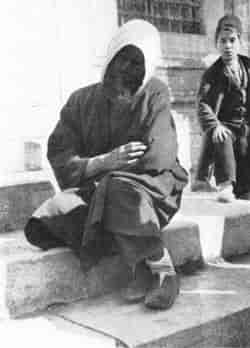 "WHAT A CONTRAST," SHE SAID.
"WHAT A CONTRAST," SHE SAID.A high wall surrounds the old Seraglio grounds. Before visitors may enter a permit must be obtained. A permit including the necessary fees to the keepers costs small parties of visitors about five dollars each; the permit and fees for the Molkte party, so it was rumored, cost the managers two hundred dollars. The captain[Pg 164] of the guard at the gate scrutinized our permit and kept us waiting until an official was summoned to act as our conductor. When we arrived at the Treasury building the huge door was opened with impressive ceremony and the uniformed officials kept the tourists under close surveillance while they were within.
Among the many curiosities that attracted attention in the first room of the Treasury was a throne captured from one of the Shahs of Persia four hundred years ago. This Persian throne is made of beaten gold inlaid with rubies and emeralds, and is said to be of fabulous value. Arranged in glass cases in another room a row of figures represents the Sultans of past ages clothed in the royal attire worn by them. The white turbans of these effigies are ablaze with jewels. The mantles which cover them are of Oriental brocade wrought in gold and silver patterns, and the belts, swords, and daggers are adorned with sparkling gems. A suit of chain armor worn by one of the Sultans of olden times is ornamented with gold and diamonds. On the second floor of the Treasury, to which we ascended by a narrow stairway, the most carefully guarded treasure is a throne used by a former Turkish ruler. This Turkish throne is made of precious wood inlaid with tortoise shell, mother of pearl, and gold and silver traceries, and is set with turquoises. A canopy overspreads the throne, and beneath the canopy, suspended by a golden cord, hangs an enormous pear-shaped emerald. In cases around the various rooms, crowns, sceptres, simitars, swords, daggers, and talismans, scintillate with rubies, emeralds, and diamonds.[Pg 165]
"Many of the highly valued treasures stored in these rooms," said our friend, the professor, "are trophies of the times when Crusader knight, Persian prince, and Saracen warrior went forth to battle arrayed in costly apparel, and encamped under silken canopies or in tents of cloth of gold. Then jeweled balls suspended from golden cords adorned the tent poles of the warriors, and luxury and opulence abounded underneath the canopies. The royalty of kings and princes moved with them to the field of war. Under pavilions of Oriental weave, silken carpets were spread over the turf for royal feet to tread, and thrones erected from which the sovereigns issued their commands. Retinues of retainers rendered obeisance and executed the mandates of their lords. Caravans of camels laden with robes of royalty and chests of treasure moved from camp to camp.
"Knights and warriors vied with each other in the splendor of their equipage. The trappings of their war steeds were embroidered in silk and gold; the breastplates and helmets which protected their bodies were embossed with silver or traced with gold; the scabbards and hilts of their weapons were encrusted with precious stones; and their mantles were clasped with fastenings and buckles adorned with jewels. In battle the body of a dead knight gave much booty to the slayer; the capture of a canopy enriched the captors; and the defeat of an army and seizure of its camp gave to the victors a train of spoils.
"For several centuries, the Turkish empire was dominant in the East and its armies victorious in the field. It was during these centuries of power that the[Pg 166] Moslem rulers gathered the great accumulation of trophies and spoils of war, valued at untold millions, which we find stored in the rooms of this marble edifice."
After leaving the Treasury we were led by the official conductor past the building in which the mantle, sword, and green banner of the great founder of Mohammedanism are treasured. These personal relics of the Prophet are considered by the Moslems too sacred to be gazed upon by infidel eyes.
We tarried awhile in the Bagdad Kiosk, a white marble palace noted for its interior wall decoration of blue tiling, beautiful doors inlaid with mother of pearl, and handsome furniture inlaid with inscriptions of silver, and thence proceeded to a marble pavilion in which, as guests of the absent Sultan, we partook of refreshments. These refreshments, consisting of Turkish coffee in tiny cups and Turkish preserves on small plates, were brought to us by the servants of the Sultan. We stood awhile on the portico in the rear of the pavilion and admired the magnificent view of the harbor with its shipping, and the surrounding shores covered with buildings.
Leaving the portico and its panoramic view with regret, we turned to the Museum of Antiquities, intending to inspect hastily the relics of ancient times which it contains. The collection, however, proved to be much more interesting than we had expected, so, instead of hurriedly passing through the building, we lingered around the sarcophagi and studied the hunting and battle scenes which were exquisitely carved on the polished marble of the exteriors of the old stone coffins.[Pg 168] The most beautiful of these sarcophagi, twenty-one in number, have been discovered within the past thirty or forty years at Sidon in Syria. The tireless archæologists, eager in pursuit of knowledge of the past, found and opened the graves in which the dead kings of Sidon had quietly rested for thousands of years; then disinterring the heavy stone caskets they brought them to Constantinople to be placed on exhibition.
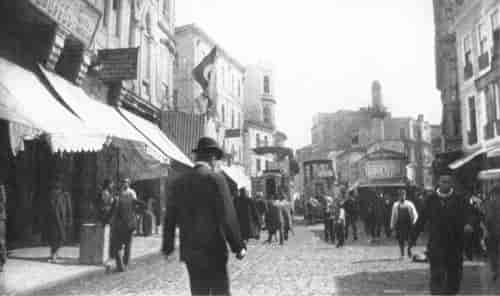 THE STREET CARS IN PERA ARE DOUBLE-DECKED.
THE STREET CARS IN PERA ARE DOUBLE-DECKED.These sarcophagi are stone caskets of great size and weight composed of two pieces, the chest and lid. The chest is hewn out of one solid block of marble and the lid of another. The sarcophagi range from ten to twelve feet in length, from five to six feet in width, and from six to eight feet in height. One of the stone coffins, made of black Egyptian marble and named the Tabnith, contained, when found, the dried up mummy of an ancient king, Tabnith, who lived four centuries before the time of Christ. An inscription on this in Egyptian hieroglyphics pronounced a curse upon the man who should despoil the tomb, but the dreadful warning was not deciphered until the casket reached the Museum. Another sarcophagus, called the Satrap's, cut out of Parian marble, somewhat resembles a Grecian temple in form. On the sides are depicted, in marble carvings, a funeral banquet, a governor on his throne, a hunting scene with a lion at bay, a frightened horse dragging its dismounted rider, and many other similar scenes.
"But this, in my opinion, is the most attractive casket in the collection," said the professor as we came to one named the Weepers, on the marble sides of which a master sculptor of ancient times had carved eighteen[Pg 170] female forms. "Notice how each figure is portrayed in a different graceful attitude of mourning and how each is a picture of sorrow. And notice, too, the exquisite workmanship of the frieze with its ornamentation of a hundred small figures in hunting scenes."
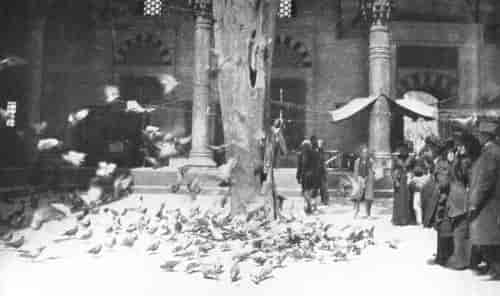 WE FED THE PIGEONS AT THE PIGEON MOSQUE.
WE FED THE PIGEONS AT THE PIGEON MOSQUE.Near to the Weepers is the sarcophagus known as the Alexander, the most famous in the collection, by many considered the most beautiful in the world, and in the opinion expressed by the American Consul in Constantinople, "worth crossing the ocean to see." The sculptures on this represent a battle between Greeks and Persians with many figures and incidents of battle, and elaborate hunting scenes with many details delicately worked out. These four sarcophagi, and the one named the Lycian on which Amazons in four horse chariots hunting lions are delineated, attracted the most attention from the tourists, but there were scores of other sarcophagi in the collection almost as interesting.
In another part of the Museum, called the China Pavilion, the noted stone tablet from the Temple of Jerusalem was on exhibition. This tablet, discovered at Jerusalem in the year 1871, originally stood in the Temple enclosure to mark the limit which Gentiles were not allowed to pass. The Greek inscription on the tablet is translated as follows:
"No Gentile may pass beyond the railing into the court round the Temple; he who is caught trespassing will bring death upon himself."
Statues, pottery, porcelain, jewels, and antiquities of various kinds were hurriedly passed by until an exclamation of one of the ladies caused us to pause.[Pg 171]
"Look at his eyes," she said, pointing to a bronze statue of Jupiter. "Did you ever see any eyes like that in a statue?"
The eyes of the god were represented by two bright rubies which gave them a very peculiar expression. This room contained many exquisite pieces of bronze work; one representing Hercules was particularly fine in execution.
"We will stop now to view the Hippodrome," said the guide, after driving a short distance from the Museum.
"But where is the Hippodrome?" inquired a tourist as we descended from the carriages in a long open square.
"Alas! the building is no more," sadly replied the guide. "This square is a part of the ground on which it stood. The space was originally very long and wide, but that great Mosque of Ahmed and other buildings now occupy a large portion of the old circus grounds.
"The ancient Hippodrome was an oblong enclosure fourteen hundred feet long and four hundred feet wide, surrounded by magnificent porticos adorned with statues of marble and bronze, and had a seating capacity of eighty thousand. It was used for chariot races, athletic sports, and bloody gladiatorial combats. Sometimes the seats were crowded with people, now assembled to glory in the triumphal procession of a returning conqueror, now to gloat over the burning of heretics and criminals who had been condemned to death by the flames.
"That high red granite obelisk covered with hieroglyphics at the end of the square is called the Obelisk of Theodosius the Great. It was originally erected in the Temple of the Sun in Egypt in 1600 B.C. by a[Pg 172] haughty king who inscribed on the stone a statement that he had 'conquered the whole world,' and that his 'royalty was as firm as that of the gods in the sky.' For two thousand years the obelisk remained in Heliopolis as a memorial of its builder, Thotmes III, but for the past fifteen hundred years it has stood here as a monument to the Emperor Theodosius, who brought it from Egypt as a trophy. In order that he might not be forgotten, the Emperor caused a representation of himself surrounded by courtiers, guards, and dancing girls to be carved on the base of the obelisk. These sculptures, as you see, are in good condition. The bronze 'Serpent Column' in the centre of the square, representing three serpents coiled around each other, once supported the tripod used in the ceremonial services of the Pythian oracle at Delphi."
When the guide had finished his remarks, our friend, the professor, stepped forward and said: "Some of the tourists may not be familiar with the story of the horses that lived as long and traveled as far as did the 'Wandering Jew' in Eugene Sue's well known romance. The conductor has requested me to relate the story."
"In some ancient time before the Christian era, a Roman conqueror found in an Oriental city four magnificent horses that pleased him. He took them to Rome to grace his triumph. Centuries later the covetous Emperor Constantine brought these same horses from Rome to Constantinople and stood them here to add glory to the splendor of his Hippodrome. For nine hundred years the horses remained undisturbed; then ruthless Christian Crusaders carried them[Pg 173] with other spoils to Venice. A long rest at Venice succeeded until the ambitious Bonaparte drew them away to beautify his famous Capitol. After the downfall of Napoleon the prayers of the Venetians were effectual in bringing the horses away from Paris, and now these gilded bronze travelers, that were coveted and prized by great rulers of the world, stand in front of the Church of San Marco in the city of Venice."
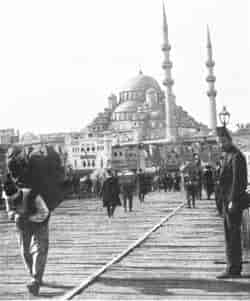 WAGONS ARE RARELY USED, MEN CARRY MERCHANDISE.
WAGONS ARE RARELY USED, MEN CARRY MERCHANDISE.As the professor ceased speaking, a clear penetrating voice was heard from overhead crying:
"Al-la-hu, Ak-bar! Al-la-hu, Ak-bar!" uttering each syllable distinctly.
It was the Muezzin calling the people to prayer. Looking up we saw him on a little balcony near the summit of a minaret which stood within the enclosure[Pg 174] of the adjoining Mosque of Ahmed. Then he disappeared and we heard more faintly his call from the farther side of the balcony. It is the Muezzin's duty to repeat his calls from the four sides of the minaret, to north, east, south, and west. His words were interpreted for us: "God is great," repeated four times on each side of the minaret.
Faithful Moslems on hearing the call repeated his words.
"There is no God but God," he called again, reciting it twice.
His hearers repeated this declaration.
"Mohammed is the prophet of God."
The people responded in the same words.
"Come to prayer."
"I have no power or strength but from God most high and great," all true believers replied.
"Come to do good," again the Muezzin called.
"What God wills will be; what he wills not will not be," answered the people, all responses being muttered in low tones.
"The ringing of bells to call the people to service is forbidden," said the guide. "It is written that when the Mohammedan meetings were first held in Arabia, there was difficulty in gathering the people together and propositions were made to 'Ring a bell as the Christians do,' and to 'Blow the trumpets as do the Jews;' but Omar cried, 'What! is there not a man among you who can call to prayer?' The prophet then said, 'O Billal! stand and make the call to prayer.' Since then the melodious voices of the trained Muezzins five times each[Pg 175] day summon the Moslems to prayer, and the tall graceful minarets which rise above the surrounding buildings were erected so that the voices could ring out over the city."
We followed the faithful into the mosque, after paying our fees and donning the slippers, and stood quietly in the rear of the great auditorium. The interior was brightened by beautiful blue and white tiling which lined the arches overhead and covered the immense piers that supported the roof. Inside the mosque, near the entrance, water was running from spigots into stone basins. The Moslems stopped at the basins and washed their hands and feet. Some of the better dressed worshipers appeared to have slippers inside their shoes and went through the motion of washing the feet, but the poorer classes used the water to cleanse their feet, and then walked forward barefooted on the rugs. Each man,—for there were no women at the service,—carried his shoes with him and placed them upon a board on the floor provided for that purpose.
The Koran, the sacred book, which, as the Moslems claim, was revealed to Mahomet by the angel Gabriel and was written by Mahomet under inspiration, commands:
"The clothes and person of the worshiper must be clean, the place free from all impurity, and the face turned toward Mecca." And also:
"O believers! when ye address yourselves to prayer wash your hands up to the elbows, and wipe your heads, and your feet to the ankles."
The worshipers, scattered around the vast interior,[Pg 176] all facing the black stone in the wall which indicates the direction of Mecca, repeated their prayers in low tones. At first they stood with hands close at their sides, then as they muttered the prescribed formulas the hands were raised to the sides of the heads, then with hands clasped in front the worshipers remained for a short time in devout attention. After bowing several times the Moslems knelt on the Oriental rugs continuing the muttered supplications and concluded their personal devotions by bowing forward on their feet. The Iman, or priest, then ascended the pulpit, the worshipers formed in lines, and as the priests read the prayers, they went through the same movements that they had previously made while at their personal devotions.
"Women do not take any part in the public worship on the floor of the mosque," said the guide. "The latticed galleries are provided for them. There they may sit in privacy during the service. The galleries, however, are rarely occupied."
The Mosque of Ahmed has six minarets; St. Sophia, only four. The minarets, slender, round towers, are not attached to the main edifices, but stand separate and distinct in the courts surrounding the mosques, with some space intervening between mosque and minaret.
Resuming our drive through the very narrow streets of Stamboul, which are paved with large rough cobble stones once laid in place but now very much out of place, we passed many old unpainted frame buildings with stove pipes projecting from the windows of the second and third floors.
"I do not wish any one ill," said a tourist who at[Pg 178] home was chief of a city Fire Department, "but I would give a ten dollar gold piece if I could see how the fire department of this old city manages to control or extinguish a conflagration after it has gained headway among these tinder boxes. The watchmen on the watch towers surely cannot locate a fire and give the alarm until they see a smoke or flame arising."
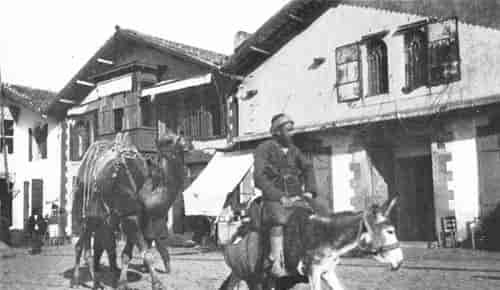 CAMEL AND DONKEY WERE BEDECKED WITH TRAPPINGS.
CAMEL AND DONKEY WERE BEDECKED WITH TRAPPINGS.The fountains of the city were one of the peculiar Turkish institutions that attracted the tourists' attention. The Koran enjoins all true believers to abstain from intoxicants, and to perform regular ablutions before prayers; so there are drinking fountains at corners where the thirsty assemble to drink from brass cups, and washing fountains or basins outside and adjoining the mosques, as well as inside these buildings, where Moslems were seen washing hands or feet regardless of our curious eyes. Some of the drinking fountains are very large and beautiful. The fountain erected by Sultan Ahmed surpasses all others in grace of proportion and beauty of design. This magnificent structure is ornamented with carved arabesques, inscriptions in gilt, and delicately colored green tile. Above the water tap may be seen in Turkish characters the builder's mandate:
"Wayfarer, admire this beautiful work; turn the tap in the name of Allah; drink thy fill and bless the founder, Ahmed Khan."[Pg 179]
CHAPTER X.
FROM THE BOSPORUS TO PALESTINE.
The program posted for Saturday, February twenty-eighth, announced that the Moltke would leave Constantinople at nine o'clock in the morning for a trip to the Black Sea, a distance of thirty-five miles. As we sailed up the Bosporus, which narrows and widens, twists and turns, a succession of picturesque scenes opened up before us. Scattered along the shores, which for fifteen or twenty miles beyond Constantinople may be considered suburbs of that city, white marble palaces of the rulers, summer residences of the foreign ambassadors, and villas of the wealthy Turks were seen interspersed with modern villages and ruined walls and castles of past ages. Pretty frame summer houses, groves of dark green cypress, gardens, boat-houses, and mosques added interest to the views.
"The sail up the Bosporus reminds me of one taken on the Hudson River, but the scenery on the banks is Oriental instead of modern," remarked one of the tourists.
"The old castles and ruined walls, and the legends connected with them, suggest the Rhine," commented another.
At the water's edge on the Asiatic side, a few miles from the city, we saw the beautiful white marble Beylerbey Palace, built in the year 1866 by Abdul-Aziz,[Pg 180] the predecessor of the present Sultan, as a residence for his harem. For their pleasure he surrounded the palace with groves and gardens and established a menagerie in the grounds. About eight miles from the city all eyes were turned toward a hill on the European shore, where, above a cluster of buildings, the Stars and Stripes floated in the breeze.
"That is the American College, which is doing good work in Turkey. It was founded by Mr. A. Robert of New York, and is known as the 'Robert College,'" said the guide.
 THE TURKISH STUDENTS WAVED HATS AND FLAGS.
THE TURKISH STUDENTS WAVED HATS AND FLAGS.As our steamer passed the college, the Turkish students from roof, windows, and campus waved hats, handkerchiefs, and flags, and cheered energetically, and the tourists waved to them in return. Just beyond the college we passed an old town surrounded by ancient towers and time-worn walls.
"This ancient stronghold," said the guide, "was[Pg 182] known as the Citadel of Europe. The fortress commanded the Strait and enabled the Sultans of four centuries ago to levy toll on all passing vessels. At this place, where the Bosporus is only about half a mile wide, the Persian ruler, Darius, with his army crossed on a bridge of boats to invade Greece. Here also the Crusaders crossed on their way to free the Holy Land from the clutch of the Saracens."
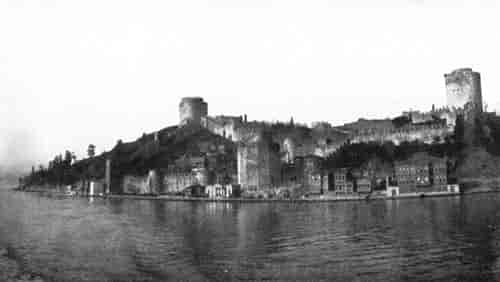 LEVIED TOLL ON ALL PASSING VESSELS.
LEVIED TOLL ON ALL PASSING VESSELS.The Moltke sailed into the Black Sea merely far enough to sweep around in a wide circle and then, returning through the Bosporus, passed by Constantinople and entered the Sea of Marmora.
"It seems like parting with a dear old friend," said a tourist as we looked back on the fading domes and waved farewell to mosque and minaret. "We have seen so much of the city in so short a time. Every hour has been used to the best advantage in the Turkish capital."
Sunday, March first, was not to be a day of rest for the tourists; for the Moltke had arrived at Smyrna at daylight and was to remain in the harbor of that city only until dark.
The principal reason for a day's stay at Smyrna was to give an opportunity for an excursion by train to the site of ancient Ephesus. Many of the tourists took this trip to see the few scattered ruins that mark the place where once stood the magnificent Temple of Diana. The clergymen of the party desired to view the place where the Apostle Paul had fought in the arena with wild beasts, and where Demetrius and his fellow silversmiths had led the rioters against this Apostle whose preaching interfered with the sales of silver shrines for Diana.[Pg 183]
Other tourists, who did not take the excursion to Ephesus, explored the narrow, badly-paved streets of Smyrna, and visited the bazaars. This city would have seemed more interesting to us but for our previous visit to the more picturesque Constantinople. In a crowded street we encountered a flock of turkeys driven by a native. The turkeys appeared to understand the driver's commands and were more easily guided by a touch of his long switch than would be a flock of sheep passing through a street in an American city.
Setting sail again, we passed late in the evening the island of Patmos, where Saint John wrote the book of Revelations, and on Monday morning we saw at a distance the island of Rhodes, noted for its historic defense by the Knights of Malta. About nine o'clock Tuesday morning the Moltke anchored in the Bay of St. George some distance from the shore. On the surrounding hill slopes rose the city of Beyrout. Fresh-looking white and yellow tinted buildings, red-tiled roofs, and a background of green groves and orchards interspersed with white villas, gave the city an appearance of newness. The whole scene, with the snow-capped Mountains of Lebanon beyond, presented a beautiful picture to the eye.
"Beyrout has a population of 120,000, and is a prosperous, growing city," said one of the managers of the tour. "It is a centre of missionary work, and has American and German colleges. The old streets are narrow, as are all old streets in Eastern towns; but they are clean. The newer streets are of modern width. Educational advantages, foreign enterprise, and Euro[Pg 184]pean mercantile firms have infused new life into the native population."
 LADEN WITH HUGE TIMBERS.
LADEN WITH HUGE TIMBERS.Madame Barakat, a native of Syria, and a well-known lecturer and Bible reader, had very kindly given us letters of introduction to her Syrian relatives in Beyrout. Among these were Mr. Sarkis, a highly respected gentleman who had been honored by the Sultan with decorations for services to his country, and who was also an author and editor of a daily newspaper; and Mr. Sabra, his assistant, a tall, fine-looking man. Another was the Rev. Mr. Zurub, pastor of the Congregational Church. The three gentlemen were able to converse in English as fluently as in their own tongue.[Pg 185]
 I. SCATTERED RUINS OF EPHESUS.
I. SCATTERED RUINS OF EPHESUS. II. WHERE ONCE STOOD THE TEMPLE OF DIANA.
II. WHERE ONCE STOOD THE TEMPLE OF DIANA.We were very cordially received by Mr. Sarkis, and, after meeting and conversing with the other gentlemen, were shown through their printing house, where Syrian type-setters were setting type to print Arabic letters that looked like shorthand characters, and Jewish girls were employed binding pamphlets. Our names were given to the printer, and in a few minutes he presented us with visiting cards containing the names in Arabic letters, thus:

"Let us visit a candy factory while waiting for the carriages I have ordered," said Mr. Sabra. "I know that the ladies are fond of sweetmeats and I can guarantee these to be perfectly pure. We think that our candies are delicious," he added as we entered the factory, and the ladies agreed with him after eating some of the sweets.
The Syrians take pride in their city, in its factories, its hospitals, its seminaries and colleges, its progressive business spirit, and the beauty of its suburbs. We visited one of the silk factories where hundreds of Syrian girls were engaged in unwinding the cocoons of delicate gossamer that had been tediously spun and wound by the silk worms among the leaves of the mulberry trees in the great orchards on the hillsides.
"On the slope of yonder mountain we have a villa in which we spend the hot summer months," said Mr. Sabra, pointing to the distant mountains as we reached an elevation from which a broad view was obtained.[Pg 187] "If there had been time I would have taken you there to see one of the most beautiful views in Syria."
 CACTI IN BEYROUT MADE AN IMPENETRABLE FENCE.
CACTI IN BEYROUT MADE AN IMPENETRABLE FENCE."The landscape is magnificent as seen from here," we replied. The fruitful valley lay before us, beyond rose the verdant hills, and above all towered the stately mountains of Lebanon. Villages, hamlets, villas, exuberant gardens, orchards of spreading mulberry trees, graceful palms, fig, lemon, and orange trees enhanced the beauty of the scene.[Pg 188]
"Our colleges and schools," said Mr. Sarkis, "are equal to those of a European city. Our people are becoming an educated people; almost all of the younger generation can read and write. My daughters have been educated in the American Seminary and can converse fluently in French, German, and English, as well as in Arabic."
In a narrow thoroughfare we passed horses laden with long boards strapped lengthwise on their backs, and camels laden with huge timbers strapped to their backs and sides in the same manner.
"This is my home," said Mr. Sarkis, as the carriage stopped before a large house surrounded by a small garden and a high wall. "I wish you to meet my wife and sister and daughters."
Our hostesses were dressed in the English fashion, and our hosts, too, wore modern English clothes, but the red fez on their heads designated them as Turkish subjects. When we expressed an interest in their way of living, the ladies took us from the reception room, which was furnished in modern style, into their garden where orange and lemon trees and semi-tropical plants were growing. They conducted us then through the spacious marble-floored central hall, permitting us to look into nursery and bedrooms fitted up partly in modern and partly in Oriental style, and led us up a stone stairway to the level roof, which, with its surrounding parapet, recalled the one described in "Ben Hur." Here fruit was served by a Syrian maid clad in the native costume. On our return to the lower floor, our hostesses conducted us to the divan salon or Oriental[Pg 190] smoking room. There, while we rested on low couches, the Syrian maid passed around Turkish coffee in dainty cups, and then brought a lighted narghileh from which, in turn, each one present took a few whiffs of the mild Turkish tobacco.
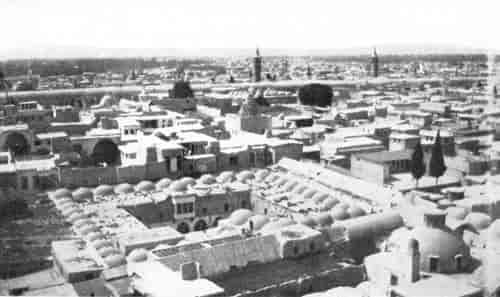 VISITED THE OLDEST CITY IN THE WORLD.
VISITED THE OLDEST CITY IN THE WORLD.Mr. Sarkis told us that he had visited the United States at the time of the Chicago Exposition. He took one hundred and forty Arabian horses to the Exposition and had some interesting experiences while there. The Rev. Mr. Zurub had spent sixteen months in America and spoke in the highest terms of the kindness with which he had been received by the American people.
In the evening a ball was given on the deck of the steamer, which had been tastefully decorated for the occasion. Our friends, Mr. Sarkis, Mrs. Sarkis and sister, the daughters, Fahima, aged about eighteen, Neda, aged about fourteen, and a son, aged about sixteen, together with Mr. Sabra, came on board to visit the ship. Mr. Sabra sang some Arabic songs and Fahima joined him in a duet.
About fifty tourists left the Moltke at Beyrout in order to take the side trip of three days to Damascus, the oldest city in history, and to the ruins of the great Temple of Baal at Baalbek. A narrow-gauge railway extends across the Lebanon Mountains from Beyrout to Damascus. The distance is but ninety miles, but as the train has to rise to an elevation of nearly five thousand feet and then descend to the valley beyond, the average speed does not exceed ten or twelve miles an hour. On Wednesday morning the steamer stopped[Pg 191] at the little seaport of Haifa just long enough to send ashore sixty passengers. Some of these wished to take the side trip to Nazareth and the Sea of Galilee by carriage; the others, to make the excursion through the interior of Palestine on horseback, camping on the way, and rejoining the main party in Jerusalem.
At noon on Wednesday the Moltke anchored in the unprotected harbor of Jaffa over a mile from the shore, as it is not safe for a large steamer to approach nearer. This was the landing place in the Mediterranean most dreaded by the tourists; for we had heard of jagged rocks that projected their black heads from the water, and of rough seas that on windy days broke over the rocks making the passage from the vessel to the dock very dangerous. The weather, however, was fair and the sea unusually smooth that noon as the tourists one by one dropped from the platform at the foot of the stairway into the row-boats as they rose on the swell of the waves. The boats were large and built expressly for this dangerous harbor. Each boat was managed by eight men, six rowers, a helmsman, and a bowman, and each boat carried about twenty passengers. As the Syrians labored hard at the oars they chanted continually a prayer to Allah for a fair passage.
After safely landing at the stone steps of the dock, we proceeded through the streets to the special train which was waiting to carry us up to Jerusalem, not stopping to visit the traditional house of Simon, the tanner, where the Apostle Peter had a vision on the roof.
"The oranges of Jaffa are noted as being the finest in[Pg 192] the world. Don't fail to buy some," said a gentleman from California. "We raise good oranges in my state, but ours are not quite equal to those of Jaffa."
Arab men and boys surrounded the tourists at the station offering carefully packed baskets, each containing two or three dozen fresh, juicy oranges at what seemed an extremely low price. When the train started every compartment contained one or more baskets of the delicious fruit.
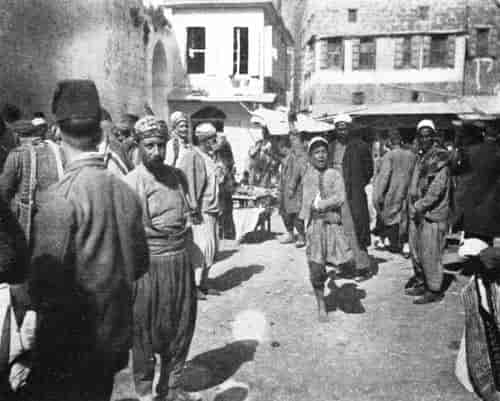 IT WAS A TYPICAL SYRIAN GROUP.
IT WAS A TYPICAL SYRIAN GROUP.The journey from Jaffa to Jerusalem was literally "up;" for the Sacred City is nearly three thousand feet[Pg 193] above the sea, and four hours was required for the trip of fifty-four miles. After leaving Jaffa the train passed through a succession of interesting panoramic views: gardens where richness of soil was manifested by the rankness of the growth of the plants and flowers; groups of palm trees with long, rough trunks, and tufted heads high in the air; long rows of tall, narrow-leaved, evergreen eucalyptus trees; orchards of orange trees where yellow fruit clustered amid the glossy dark green leaves; orchards of almond trees covered with a delicate pink bloom; and orchards of gray olive trees with a carpet of grass underneath, as beautiful as a park; bare fig trees whose time for leaf and bloom had not yet come; and fences of huge leaved prickly cactus plants protecting garden plots.
"What queer looking plows they have," said a companion, as we noticed near the train a plowman who had stopped his camel, and thrown his plow, which looked like a crooked root with a point, out of the furrow, while he gazed at the passing train. "The first gardener must have obtained a plow of the same kind from the original forest."
In stretches of sod the rich brown earth was being turned up by farmers with teams of camels, one great camel to each little wooden plow, or with teams composed of an ox and an ass hitched together. In one field twelve camel teams were plowing the sod. We use the word field, but there were no fences except the cactus hedges around small plots. The farm boundaries from ancient times have been marked by corner stones to which Moses referred when he gave the law: "Cursed be he[Pg 194] that removeth his neighbor's landmark." We were in the midst of historic places mentioned in the Bible. To the north lay the fertile level fields of the Plain of Sharon. Fields of young wheat were beautified by the roses of Sharon,—red poppies with black centres and short stems,—which dotted the carpet of green with flecks of red. At Lydda, where Peter healed the man who had the palsy, Arab urchins begged the passengers to buy little bunches of the red poppies and other wild flowers that they offered for sale. To the south stretched the Plain of Philistia, the scene of Samson's adventures, and the fields through which he sent the three hundred foxes with firebrands tied to their tails. In that direction also lay battle fields where Philistines and Israelites struggled for supremacy.
 A CARAVAN WITH BALES OF RUGS HAD JUST ARRIVED.
A CARAVAN WITH BALES OF RUGS HAD JUST ARRIVED.The towns and villages on the route were small and mean. The better buildings were constructed of stone with flat stone roofs, but many were made of mud with mud roofs on which a crop of grass was growing. After the first hour's ride, fertile rolling plains succeeded the level sandy loam. When about thirty miles from Jaffa, after a two hours' ride, the hill country of Judea was entered. From that point the train traveled slowly and laboriously up the hills and mountains by steep gradients. Overhead in the limestone cliffs were many caves, one of which was pointed out as Samson's Grotto. Whenever there was any soil among the rocks and stones, the grass grew luxuriantly, making good pasture for the herds of nimble-footed black goats that picked their way along the steep and rocky mountain side. The red rose of Sharon grew in profusion and took possession[Pg 196] of the uncultivated ground around the trees and between the rocks. At many places the abundance of these poppies and the beauty of their groupings gave to the land the appearance of a park planned and laid out by a landscape gardener. Nearer the summit the hills were bleak and barren. Here was the village of Bittir, a group of little stone houses clinging to the mountain side, where terraces supported by stone walls held up small gardens on which cauliflower and other vegetables were growing.
 THEY CHANTED A PRAYER TO ALLAH.
THEY CHANTED A PRAYER TO ALLAH."For the past hour," said a lady who had been intently gazing out of the window of the car, "yes, for a longer time, I have been looking forward expecting to see a city burst forth impressively into sight, a city upon a mountain top, 'beautiful for situation.' Now the[Pg 197] conductor tells us that we are nearing our destination, and yet cliffs and hills are all that we can see. Where is Jerusalem? 'A city set upon a hill cannot be hid.'"
"You have not read your Bible closely," replied a minister in our compartment. "David said, 'The mountains are round about Jerusalem,' As it was then so we shall find it now, on hills surrounded by other hills. Do not expect to see the city of Solomon's time which the Queen of Sheba came to visit. Its glory departed eighteen centuries ago. I fear that your imagination has led you to expect more than the modern Turkish town which we shall find, and you may feel like lamenting with Jeremiah, 'Is this the city that men call the perfection of beauty, the joy of the whole earth?'"
It was not until we were approaching the railway station, which is situated in the suburbs about a mile from the city, that we obtained a view of the yellow walls and buildings of the Holy City, and the sight then was not impressive, as we had expected. Then at the station, amid the noisy cries of many Arab drivers, we obtained seats in carriages, and were driven at breakneck speed over a good road down into the valley of Hinnom and up a long hill to the Jaffa gate.
The party had been divided by the managers into sections for the various hotels, and each tourist had been given a card with the name of his hotel. Those who were to go to hotels outside the walls of the city proceeded directly to their destination in carriages. Those who were to stay within the walls descended from the conveyances in front of the Grand Hotel just within the Jaffa gate, and went the rest of the way on foot through[Pg 198] narrow streets that carriages could not enter. The writer was assigned to the Casa Nova, or Hospitium Franciscanum, a monastery or hospital built expressly for the accommodation of pilgrims to the Holy City, and controlled and managed by Franciscan monks.[Pg 199]
CHAPTER XI.
JERUSALEM.
On Wednesday evening, after our arrival at Jerusalem, we visited a small store to purchase a guide-book of the city. But the merchant would not accept our French or English money, and we had no Turkish money. We laid the book down, but the dealer said, "You take the book and pay me another time."
"Are you willing to trust a stranger?" we inquired.
"Yes!" he replied, "I trust American any time. You may buy goods, all you want, three hundred dollars' worth. I trust you. When you go home to America, then you send me the money."
"Were you never cheated?" we asked.
"No," he answered, "I trust American many time. American always pay, but me not trust Frenchman; Frenchman forget."
Glad to know that our countrymen bear such a good reputation, we took the book without giving our names, merely telling him that we were staying at the Casa Nova and would pay the next day.
In our country we can travel from Maine to California with one kind of money. All that is necessary is to have plenty of it. But in these foreign lands the currency changes as we move from one country to another, so that we may have a pocket full of money and yet not be able to pay our bills. At Funchal, Portuguese[Pg 200] money was current; at Gibraltar and at Malta, English money; at Granada, Spanish; at Algiers, French; at Athens, Greek; at Constantinople and Jerusalem, Turkish. In Cairo another coinage was current, and in Italy the Turkish and Egyptian coins left over had to be sold to the money changers or taken home as souvenirs. In large cities the hotels and larger stores accepted American, English, and French money at its value, but small dealers and individuals knew nothing of foreign coins and wanted payment in their own currency. As it was desirable at all times to have plenty of small coins on hand, the tourists soon became acquainted with the value of shillings and pence, francs and centimes, drachmæ and lepta, piasters and paras. On our arrival at each port the managers of the tour and the purser of the vessel obtained a large number of small coins of that particular country so that the needs of the tourists could be promptly supplied.
Our room at the Hospice was rather cold but my room-mate said there was one compensation, we need have no fear of the hotel's burning down and so need not be anxious as to the location of the fire escapes before retiring. The Casa Nova is a stone building with stone stairways and floors. In our room there was nothing inflammable but the mosquito nettings and lace draperies over the iron bedsteads. Two candles furnished us with light, hempen rugs covered portions of the black and white marble floor, a gilded crucifix hung on the painted stone wall, and two chairs, a small table, and a washstand completed the furnishing.
 I. ENTERED BY THE JAFFA GATE.
I. ENTERED BY THE JAFFA GATE. II. STOOD IN THE PALACE OF CAIAPHAS.
II. STOOD IN THE PALACE OF CAIAPHAS.Early Thursday morning, with bright anticipations,[Pg 202] we started for a visit to Bethlehem. The drive of six miles over a good limestone road was one of much interest. Our dragoman pointed out the well where the wise men, stooping to drink, saw the reflection of the[Pg 203] star in the water before they beheld the star itself in the sky.
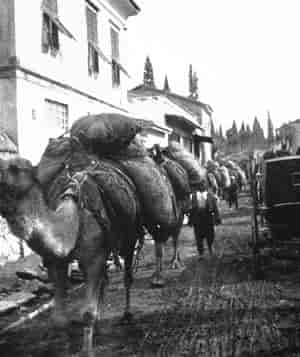 CAMELS SINGLE AND CAMELS IN TRAINS.
CAMELS SINGLE AND CAMELS IN TRAINS."Why, how could that be?" inquired one of the party. "I thought the wise men were following the star."
But the guide did not attempt to explain. It was his business to state facts in which he had believed all his life; not to enter into disputes with unbelievers as to the truth of his statements. He showed us a great rock in the road where Elijah, wearied in his flight, lay down to rest. It seemed to be a hard bed for a tired man, but we remembered that in olden times rocks and caves were selected for sleeping-places and stones often served for pillows.
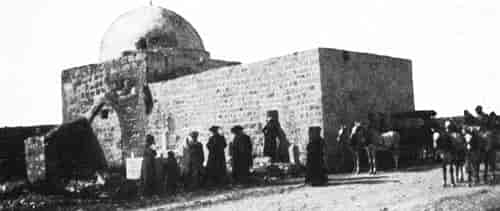 RECALLED TO MEMORY THE OLD LOVE STORY.
RECALLED TO MEMORY THE OLD LOVE STORY.Camels were so numerous on the road that they lost their novelty,—camels single and camels in trains, with great hampers swinging at their sides laden with sacks of lime or charcoal, with building stone or cauliflower, with fish or flagstones, with chunks of wood and gnarled roots, with bags of grain and crates of vegetables, each[Pg 204] camel carrying a quantity about equal to a one-horse wagon load. From a hill-top we caught a glimpse of the Dead Sea lying far below us in the valley twenty miles away. We met women on their way to market with heavy baskets of cauliflower and other vegetables poised on their heads, men bending under distended goat-skins filled with water or wine strapped to their shoulders, donkeys bearing basket-panniers filled with produce or laden with bags of grain heaped on their backs, Greek priests in black robes and high hats carrying white umbrellas for protection from the sun, and turbaned Arabs in brown robes plodding along with staves in their hands.
The mountainous suburbs of the city are composed of limestone, and the limestone rocks cropped out on every side. The rocks protruding from the soil were of a light gray color, but the broken rocks, the fences, and the houses built of stone had changed to a light yellow shade from exposure to the weather. The fields were covered with stones except where little patches had been cleared with great labor and the stones built into fences surrounding the small plots. The hill-sides were almost bare of soil. Where the stones had been cleared away, the soil of decomposed limestone produced a luxuriant growth. The cauliflower carried to market was the finest we had ever seen. The few scattered olive trees in the valleys appeared strong and healthy in their light green foliage. The fig trees were bare, but occasional groups of almond trees were covered with pink bloom.
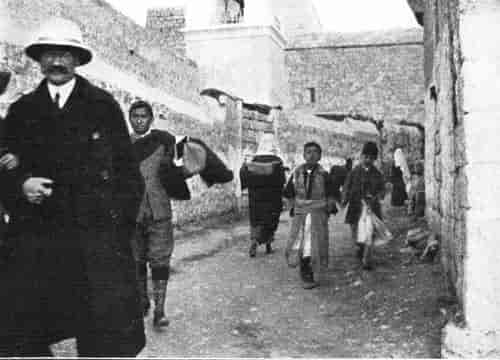 IN THE NARROW STREETS OF BETHLEHEM.
IN THE NARROW STREETS OF BETHLEHEM.During our drive we saw peasants plowing little plots[Pg 205] with single donkeys and crooked wooden plows, or digging between rocks and around grape vines with clumsy, heavy-looking hoes. The grape vines were trimmed back to within three or four feet of the ground and were not supported or trellised. Women gathered the trimmings of the vines, bound them into fagots, placed the fagots on their heads, and carried them away to the city for firewood. Not a sprig was wasted. The old roots that were dug out of the ground were borne away in the same manner. In a country without forests and without coal everything that will burn is utilized. We saw girls carrying flat baskets on their heads and the guide satisfied our curiosity by explaining that the[Pg 206] baskets contained dried cakes of camels' dung which the girls had gathered and were taking home for fuel.
Rachel's tomb, situated four miles from Jerusalem, and about two miles from Bethlehem, recalled to memory the old love story: "And Jacob served Laban seven years for Rachel; and they seemed unto him but a few days, for the love he had for her."
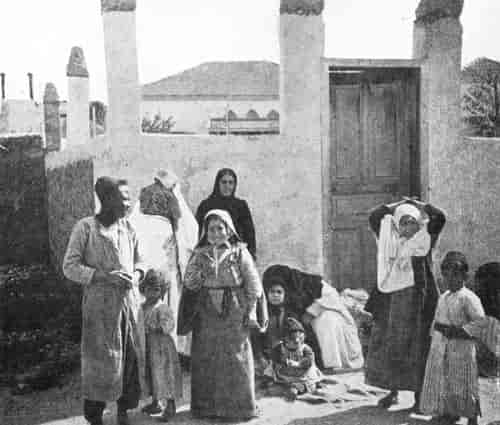 THE PEOPLE OF BETHLEHEM WERE BRIGHT AND CHEERFUL.
THE PEOPLE OF BETHLEHEM WERE BRIGHT AND CHEERFUL.Cut in the rock, near Bethlehem is an ancient well, known as the well of David. From that point we obtained a good view of the square stone houses of the[Pg 207] little town of Bethlehem, which is built on a sloping hill-side, and of the great spreading Church of the Nativity, which is the dominating feature of the place. Beyond the city we saw a verdant plain, where possibly Ruth gleaned, and, farther away, the hills where probably David led his flock to "green pastures" and the shepherds of later days received the "tidings of great joy."
In the narrow streets of Bethlehem our driver shouted to men, women, and children to clear the way and make room for the carriages to pass through, snapping his whip at them if they did not quickly obey. When we arrived at the old Church of the Holy Nativity we were told that this venerable place is in reality a group of buildings, the original edifice having been built fifteen or more centuries ago, and many additions having been made in after years. We saw a structure of yellowish stone walls pierced with small windows which appeared to us more like a prison or a fortress than a place of worship. There were no stained glass windows. There was no imposing portal opening into the temple. On entering the sacred enclosure we passed through a door in the stone wall so low that we were compelled to stoop and so narrow that but one at a time might enter.
"This doorway," said the guide, "should remind the pilgrims that the birthplace of the Savior is to be visited with humility and reverence."
In the large, time-worn interior of the church, faded mosaics, huge columns, and stone floors presented a rather gloomy aspect. The tourists hastened through and descended to the crypt or vault underneath the[Pg 208] church. This vault was paved with marble, and on a raised platform in the centre was a large, handsomely decorated altar. Suspended from the ceiling were many ancient lamps of curious make and smaller lamps hanging in festoons. On one side was a small room, called the Chapel of the Nativity, where thirty gold and silver lamps threw a dim, soft light on the scene below. In the pavement before an altar was a star of silver, and the words:
Opposite and near the Chapel of the Nativity was another small, rock-walled room called the Chapel of the Manger. In this room the dim light of golden lamps revealed a white marble manger in which a large wax doll reclined.
"The original wooden manger or cradle in which the infant Jesus reposed was taken to Rome," explained the guide. "If you return by way of Rome you may see it in the great church of Santa Maria Maggiore."
"The care of the chapels, shrines, and holy places of the Church of the Nativity," he continued, "is appointed to the Latin, Greek, and Armenian churches. The space inside the building is divided. Each sect has its own particular portion to care for, and an intense jealousy exists among the rival religious bodies. If the rug of the Armenian is accidentally pushed over the Latin line, the action is resented. If the broom of the Latin while cleansing intrudes upon the Greek domain, there is trouble. Disputes have arisen from very slight causes, blows have been exchanged, rioting,[Pg 210] blood-shed, and murder have followed. Priests at times have fought with priests until the Turkish soldiers intervened. Now, by the Sultan's orders, Moslem guards are stationed in the church to restrain the impetuous caretakers and prevent disturbances."
 THIS ROUND-TOPPED RIDGE IS CALLED THE MOUNT OF OLIVES.
THIS ROUND-TOPPED RIDGE IS CALLED THE MOUNT OF OLIVES.In one of the underground chapels of the church, a dark and gloomy cavern cut out of the solid rock, the guide said: "In this grotto Saint Jerome passed thirty years fasting, praying, meditating, and writing. His last communion was taken here."
We remembered that Domenichino's celebrated painting in the Vatican at Rome, called the "Last Communion of St. Jerome," represented the aged saint dying amid luxurious surroundings.
When we came out of the church, bright-faced boys and girls urged us to buy their wares or accompany them to the shops. The little town appeared to prosper from the manufacture and sale of souvenirs of carved mother-of-pearl and olive-wood. Crosses, crucifixes, rosaries, beads, glove-boxes, writing desks, inkstands, napkin rings, paper knives, and forks were offered as genuine wood from the olive trees of David's town, and the mother-of-pearl mementoes were carved with minute scenes of events in the life of Christ and of places in the Holy Land.
After the purchase of olive wood souvenirs had been made, the drive was continued to the Pools which Solomon had built to collect water for use in the Temple. These are situated among the hills about eight miles from Jerusalem. The stone walls of the reservoirs were so well constructed by Solomon's architects three[Pg 212] thousand years ago that to-day the masonry is in almost perfect condition. The Pools, we were informed are not in use at the present time, although water is conveyed in pipes to Jerusalem from springs near-by.
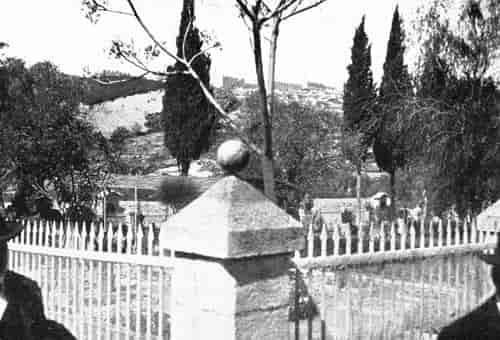 A GARDEN SURROUNDED BY AN IRON FENCE.
A GARDEN SURROUNDED BY AN IRON FENCE.The glare of the sun on the white road and gray rocks, the lack of green in the bare landscape, and the fine dust from the limestone caused a slight smarting in the eyes of the travelers. So it was with relief that in the suburbs of the city, about half a mile from the Damascus gate, we descended a long flight of stone steps into the shade of an excavation in the rocks about twenty feet in depth. This open chamber, known as the Tombs of the Kings, is about ninety feet square. At one side is a doorway in the rock four feet high and thirty inches wide, and beside the doorway stood a huge stone, rounded at the corners, that might, by the united efforts of several men, be rolled in front of the entrance so as to close it completely. We crawled through the hole in the rock and entered a cavern. The candles of the guides revealed on each side of the cavern small rooms or caves containing shelves or apertures which had been used as the sepulchres of the Kings.
Jerusalem, situated on four hills, is surrounded by hills which are separated from the city and from each other by deep valleys or gulleys. We drove from Jerusalem to the Mount of Olives over a well constructed modern limestone road that wound among these hills and valleys in long curves and horseshoes in order to reach a place that seemed almost within a stone's throw.
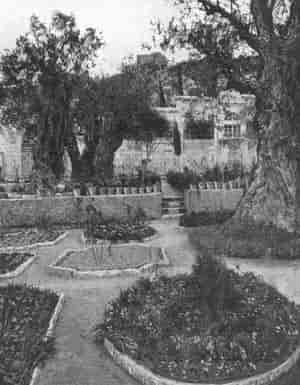 CAREFULLY TENDED AND GUARDED BY FRANCISCAN MONKS.
CAREFULLY TENDED AND GUARDED BY FRANCISCAN MONKS."The summit of this round-topped ridge, which is[Pg 214] called the Mount of Olives, is owned by Russia," explained the guide, "and the Russians have erected an observation tower, a chapel, and other buildings upon it. These buildings are surrounded by a courtyard enclosed within high stone walls, and a fee must be paid at the gate in order to gain admittance. Within the court a small circular pavilion covers the place from which, it is claimed, the ascension of the Savior was made."
As we approached the gate, a group of Russian men and women were seen coming sadly away. We were informed later that these peasants, after tramping a long distance on a holy pilgrimage in order to kneel down and kiss the stone that marked the sacred spot of the Ascension of their Lord, were refused admittance because they had not the required fee to pay for entrance. In a Roman Catholic church, built on the spot on Olivet where Christ is said to have taught His disciples to pray, the Lord's Prayer is displayed on charts in large letters in thirty-six different languages, so that pilgrims from all parts of the world can read the prayer in their own tongue.
From the summit of Olivet, which is two hundred feet above the city of Jerusalem, we looked down over the Holy City; but a finer panoramic view of the surrounding country was obtained afterwards from the Russian observation tower. The climbing of the two hundred stone steps which lead to the top of the tower was not easy, but we felt amply repaid by the magnificence of the view. Near the foot of the mountain lay the Garden of Gethsemane. Beyond and four hundred feet below[Pg 216] us, the little brook Kedron trickled through the narrow Valley of Jehoshaphat. Across the valley on the opposite heights of Mount Moriah, only half a mile away in a direct line, prominent in the foreground, stood the Mosque of Omar, and back of it rose the square roof and round domes of the city buildings. Away off to the east, deep down in the valley, we could see a portion of the Dead Sea and could trace the Valley of the River Jordan.
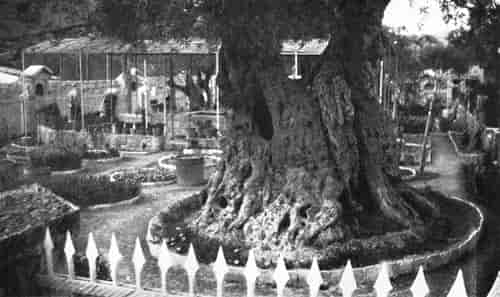 AND A FEW LEAVES FROM ONE OF THE ANCIENT OLIVE TREES.
AND A FEW LEAVES FROM ONE OF THE ANCIENT OLIVE TREES.We walked from the summit of the Mount of Olives down a steep, rocky, crooked, narrow lane, hemmed in by stone walls, to the foot of the slope, as it is considered too dangerous for the tourists to remain in the carriages while descending this short cut to a lower road. The carriages rejoined us later. At the foot of the hill there was a piece of land about half an acre in extent enclosed by a white stone fence. Within the enclosure was a garden surrounded by an iron fence. Between the stone fence and the iron railing was a wide path. Within the garden were eight gnarled olive trees that appeared to be of great age, and flower beds which were carefully tended and guarded by Franciscan monks. It was not necessary for the guide to tell us that this was the Garden of Gethsemane. Small shrines with pictures above them, fourteen in all, representing the fourteen traditionary stations of the Via Dolorosa, were arranged at intervals along the path around the garden. Before these shrines pilgrims were kneeling in prayer. As we were leaving the garden an old monk with tonsured head, in long brown robe girt about with a hempen cord and having sandals laced on his bare feet, presented[Pg 218] each, of us with a flower from the garden and a few leaves from one of the ancient olive trees.
 I. BETHANY IS A POOR LITTLE VILLAGE.
I. BETHANY IS A POOR LITTLE VILLAGE. II. THE EMPTY TOMB OF THE RISEN VIRGIN.
II. THE EMPTY TOMB OF THE RISEN VIRGIN.The Tomb and Chapel of the Virgin, which is but a short distance from Gethsemane, had a venerable aspect, and the olive trees surrounding it were patriarchal in appearance. We crossed the sunken court and descended a broad staircase of sixty steps to a gloomy chapel which seemed to have been excavated in the rock.
"These tombs on the right are the tombs of the parents of the Virgin, Joachim and Anna," said the guide as we halted in the dim light. "That tomb on the left is the tomb of Joseph, the husband of Mary. The small chapel at the end of the grotto contains the empty tomb of the risen virgin."
On the road to Bethany we passed many trains of pack mules, twenty or thirty in a train, and caravans of camels striding along in single file. A light rope or chain connected the leading camel with the others and kept them from straggling.
The Arab who drove our carriage told us that he was a scholar. He explained by stating that he could converse fluently in four languages, besides his own native Arabic tongue. These languages were Turkish, Russian, Latin, and French, and in addition, he knew enough English to give some information to the tourists. The linguistic ignorance of the occupants of his carriage seemed to impress him with the idea that education in America is neglected.
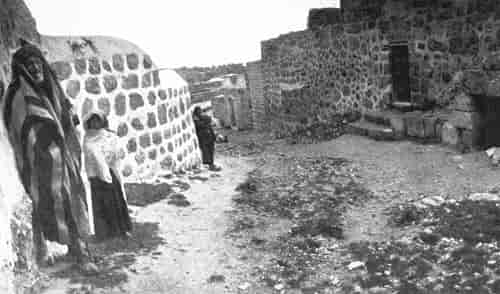 IN A STREET IN BETHANY A LOCAL GUIDE WAS WAITING.
IN A STREET IN BETHANY A LOCAL GUIDE WAS WAITING.Bethany, barely two miles distant from Jerusalem, is a poor little village with steep, rough, dirty lanes and[Pg 220] a number of old and dilapidated small stone houses amid broken walls of other houses which evidently have been equally insignificant. One of these piles was pointed out by the Bethany guides as the ruins of the home of Mary and Martha, and we were then taken to a narrow lane where a dark and slimy stairway led down to the reputed tomb of Lazarus. Our dragoman, who firmly believed in the traditions of the country, said that he could not vouch for the statements made by the Bethany local guides.
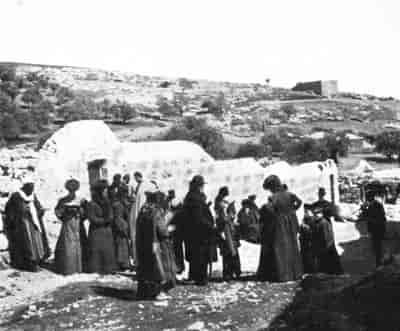 AT THE ENTRANCE TO THE TOMB OF LAZARUS.
AT THE ENTRANCE TO THE TOMB OF LAZARUS.Returning to Jerusalem, we visited the so-called[Pg 221] palace of Caiaphas, the High Priest. This palace is an excavated ruin. Steps lead down to the marble floor, which is fifteen or twenty feet below the present level of the street.
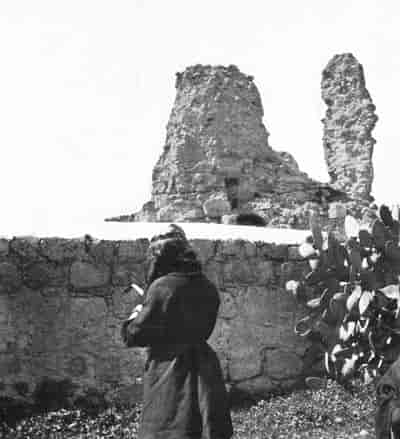 THE RUINS OF THE HOME OF MARY AND MARTHA.
THE RUINS OF THE HOME OF MARY AND MARTHA."The circle on the pavement," said the custodian,[Pg 222] "marks the place where Peter stood with the soldiers, warming his hands by the little fire which they had kindled in a brazier, when he was accused by the maid of being a companion and follower of the Prisoner then on trial before the High Priest. The stone pillar that you see in the courtyard of the palace is the stone on which the cock was perched when its crowing quickened Peter's memory, softened his heart, and brought bitter tears to his eyes."
After leaving the palace we followed the guide through a rough narrow street to a view point on the wall. Far below us lay the Valley of Jehoshaphat, the village of Siloam, and the site of the pool to which Jesus sent the blind man to wash.
"The walk to the pool through the rough and crooked streets would be difficult now for a man with good sight," remarked one of the tourists, "how much more so would it be to a blind man groping his way."
Permission to visit the Temple Area, or Haram, as it is called by the Moslems, had been obtained from the Turkish authorities by the payment of heavy fees. We proceeded to that place on foot accompanied by the dragoman. At the gate of the Area the authorities furnished Moslem guides to conduct the visitors through the enclosure, and sent Turkish soldiers to accompany the party to restrain any possible irreverent or unseemly conduct while within the holy precincts.
 I. WITHIN THE TEMPLE AREA.
I. WITHIN THE TEMPLE AREA. II. THE AREA EXTENDS OVER THIRTY-FIVE ACRES.
II. THE AREA EXTENDS OVER THIRTY-FIVE ACRES."The Temple Area, which probably covers the place where was once the Court of the Temple," explained the dragoman, as we halted within the grounds, "is thirty-five acres in extent, about one thousand feet wide by[Pg 224] two thousand feet in length, and is surrounded by high walls. It is revered by the Moslems as one of their most holy places. This is the Mount Moriah hallowed by the sacrifices of Abraham, glorified by the prayers of King David, consecrated by the Temple of Solomon, and made additionally sacred by the ascension of the Prophet of Allah. The Moslems forbid the entrance of Jews into the Haram, although the Jews have as great reverence for the place as the Moslems."
In the centre of the Area, on a raised embankment or platform, paved with marble slabs, stood a handsome octagonal building covered below the window line with marbles of various hues and above that line by decorated tiles of blue-and-white porcelain edged with green. As we stood on the marble pavement and gazed at the tiling mellowed by age, and at the round lead-covered dome above, the guide continued his explanations.
"This edifice, called by the Moslems the Dome of the Rock," said he, "but better known as the Mosque of Omar, is built on the site of the Temple of Herod, and also on the site of the Temple of Solomon, which preceded that of Herod. Each side of the octagon is sixty-six feet in length, and the top of the dome is one hundred and fifteen feet above this platform."
Underneath a small pavilion at the entrance, attendants laced slippers to our feet and then conducted us into the Mosque. On the floor lay precious Oriental rugs. Overhead in the dome, the light entered through richly stained glass windows, tinting and beautifying the interior and disclosing the mosaic decorations of the ceiling and the Arabic inscriptions on the walls. At[Pg 225] one side was an exquisitely carved wooden pulpit inlaid with ivory and mother-of-pearl. In the centre of the Mosque a great rock, at least fifty feet long and almost as wide, rose to the height of our heads. A beautifully designed, gilded and bronzed iron railing prevented infidel fingers from touching the rock.
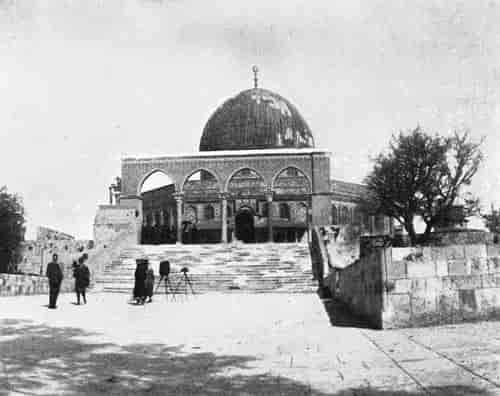 WE WILL TAKE THE PICTURE AND INCLUDE THE TURKS IN IT.
WE WILL TAKE THE PICTURE AND INCLUDE THE TURKS IN IT."This mountain-top, the crown of Mount Moriah," said the Moslem dragoman, as we stood reverently before it, "is the place where the arm of Abraham was stayed as he lifted the knife to slay his son. This rock, in David's time, was the threshing floor of Araunah, whose[Pg 226] oxen trampled out the grain upon it until the time when King David purchased the land and built here an altar to the Lord. When King Solomon erected the temple upon the site prepared and dedicated by his father David, this Holy Rock became the altar upon which the priests of the temple offered sacrifices. When Mohammed, the Prophet of God, took his flight to Heaven he rose from this sanctified place, which is nearer to Heaven than any other spot on earth, leaving as a memorial the impression of his foot which you now see there in the rock. The print of the hand in the rock near the footprint was made by the angel Gabriel when he prevented the rock from following the Prophet in his ascent."
At the foot of the flight of steps which the tourists descended on their way from the marble platform of the Dome of the Rock to the Mosque of El Aksa, the tourists encountered Turkish photographers, who, hoping that the Americans would gladly make use of their services, had been patiently awaiting their arrival. But the tourists were well supplied with their own outfits, and these amateurs, disdaining the offered professional services, secured snapshots themselves.
"What!" said one of the amateurs indignantly, "let the Turks take us? No! let some of the party stay on the steps and we will take the picture and include the Turks in it."
While returning through the extensive grounds of the Haram, one of the tourists lighted a pipe. Immediately a Moslem guard approached and with unintelligible words, made it known by his frowning face and threatening gestures, that the pipe must be extinguished.[Pg 227]
CHAPTER XII.
THE CHURCH OF THE HOLY SEPULCHRE.
The floor of the vast Church of the Holy Sepulchre is below the level of Christian Street. We descended to the church through a narrow alley about a hundred feet in length, which by slopes and steps led downward. On each side of this alley peddlers had stands for the sale of beads, rosaries, crucifixes, candles, and souvenirs, which they earnestly besought the visitors to buy. The church is so surrounded by other buildings that it could not be seen until we arrived at the foot of the alley, where a few steps to the left led down to a wide stone paved court. Even then only the rough stone facade and the top of the dome were visible. The door was guarded by Turkish soldiers, but they did not object to our entrance.
Within the Church, in the centre of the vestibule, we paused beside a marble slab six feet in length, elevated slightly above the stone floor. A canopy overspread the marble and at the sides of the canopy stood six immense ornamented silver candlesticks rising higher than our heads. In these were tall candles.
"This is the Stone of Unction," said the guide. "On this marble the body of Jesus lay while it was anointed for burial. Two of these candlesticks belong to the Greek Church, two to the Armenian Church, and two to the Latin Church. In this holy edifice each religious[Pg 228] sect claims the privilege of taking part in the worship and in the care of the sacred places."
Not far from the vestibule the guide halted, and pointing to a circle on the stone floor, said: "This circle marks the place where the Mother of Jesus stood at the time of the anointing."
The Church of the Holy Sepulchre, we ascertained, is composed of many parts. A rotunda, sixty-six feet in diameter, occupies the center. Above this rises the dome, supported by eighteen large piers. On one side of this round room, an opening leads into a Greek church; on the other side, entrances between the piers lead into small chapels. Grouped around outside of these, but connected with the central rotunda, church, and small chapels, are other chapels, rooms, and sacred places, the whole covering a space of over two acres. In the centre of the rotunda, directly underneath the dome, stands a small marble building twenty-six feet long by eighteen feet broad, richly decorated with carvings, inscriptions, and figures of angels. At one end of this building there is a small door guarded by huge bronze candlesticks ten feet in height and over-hung with gold and silver lamps of curious oriental design. Three golden crosses surmount the front of this miniature building: one of Greek form furnished by the Greek Church; one of Roman form, by the Latins; and one of the Syrian shape, by the Armenians.
"This small building," said the guide, "encloses the place of the Sepulchre. The interior is divided into two parts. The first you will enter is the Chapel of the Angel. The Tomb of the Savior is in the second part."[Pg 229]
 I. ENTRANCE TO THE CHURCH OF THE SEPULCHRE.
I. ENTRANCE TO THE CHURCH OF THE SEPULCHRE. II. THE VIA DOLOROSA.
II. THE VIA DOLOROSA.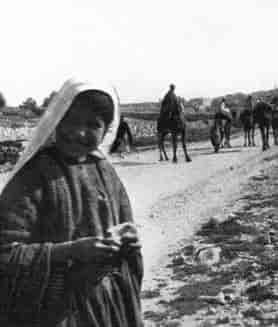 A CRUST IN HER HAND, A GRIN ON HER FACE.
A CRUST IN HER HAND, A GRIN ON HER FACE.Passing between the lines of huge candlesticks and underneath the clusters of overhanging lamps, we entered the small doorway and were in the Chapel of the Angel. In the centre of this small room stands the stone upon which, the guide said, the angel sat after rolling it away from the entrance to the Savior's tomb. Stooping low we passed singly through the narrow opening to the tomb. This is a small chamber about six feet square, the floor and walls of which are covered with white marble. At the right hand side of the tomb a marble slab about two feet wide extends the length of the chamber. This marble is much worn by the millions of kisses that have been tearfully and reverently pressed upon it by the pilgrims of many centuries. Two score of golden lamps, continually burning overhead, shed a soft but brilliant light upon the tomb. Our visit to the interior of the tomb was short; for not more than five persons may stand in it[Pg 232] at one time, and other pilgrims from other lands were waiting their turn to enter.
For a small fee the local guides provided us with tapers, for some of the chapels and grottoes within the vast cluster of the buildings of the church were dark, and in the gloomy recesses the holy places could not be seen without a light. In the dark grotto of the Syrian chapel our tapers shed a dim light on two tombs, which the guide said were those of Nicodemus and Joseph of Arimathea.
 WE WALKED THROUGH THE NARROW VIA DOLOROSA.
WE WALKED THROUGH THE NARROW VIA DOLOROSA."This is the Chapel of the Apparition," explained the guide, after leading us to another part of the church. "Here the Lord appeared to Mary, His mother, after the Resurrection. In a niche beside the high altar is a hole in the wall. If you hold your taper up to it you may see within the wall a part of the column to which the Savior was bound during the Flagellation. You may touch the sacred column with this round stick, provided for the purpose, if you wish to do so. The stick, being worn smooth by the numberless kisses that have been pressed upon it by the pilgrims after touching the holy column, can do it no harm."
In a vestibule outside the chapel a star in the marble floor marks the place where Christ appeared to Mary Magdalene after the Resurrection, and a second star a few feet beyond marks the spot where Mary stood when she recognized the risen Lord.
We passed from the rotunda into the Church of the Crusaders or Greek Church, through a wide opening directly opposite the door of the Holy Sepulchre. In this large chapel the walls and ceilings, the seats of the[Pg 234] choir, the high altar, and the seat of the Patriarch in the rear of the altar, are composed of precious woods beautifully carved and ornamented with gold and silver and jewels. Hundreds of superb golden and silver lamps, varying in form and design, hang suspended from the ceiling at various heights. In the centre of the chapel, standing in the middle of a fancifully designed circle on the checkered marble floor, is an urn containing a marble ball.
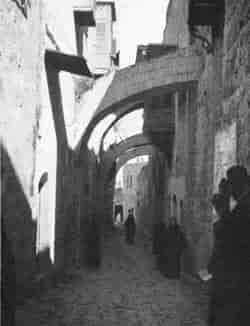 THE VERY STONES HIS SACRED FEET HAVE PRESSED.
THE VERY STONES HIS SACRED FEET HAVE PRESSED."This ball marks the centre of the world," explained the guide, as we halted beside the urn. "About eight centuries ago certain wise and holy men ascertained, by calculation or by inspiration, that this spot is the exact centre of the world. It was marked in this manner so that the pilgrims coming here from all parts of the earth might see it and carry the knowledge of the wonderful discovery back with them to their various countries."
Beyond the Greek Chapel we descended, by aid of our burning tapers, a flight of thirty stone steps to the ancient, dimly-lit Chapel of St. Helena.
"When the Empress Helena was inspired to search for the true cross," said the guide, "she employed workmen to excavate here. There is the seat on which she sat while superintending the search, and there below us is the excavation in which she found the three crosses, the crown of thorns, the nails, and the inscription."
We peered into the darkness below but could see only a gloomy hole about eight feet deep and twenty feet across, a short flight of steps cut in the rock, and an altar at one side.[Pg 235]
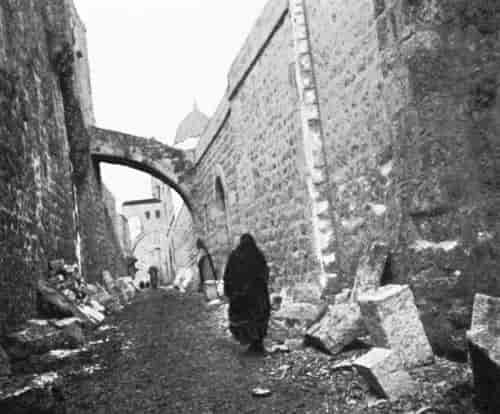 THE OLD STREET OF SORROW LIES BURIED TWENTY FEET BELOW.
THE OLD STREET OF SORROW LIES BURIED TWENTY FEET BELOW.Reascending to the main floor, we halted at the Chapel of the Mocking. There the guide showed us the stone upon which the Jews made Jesus sit while they crowned Him with thorns. The guide then led the way up a flight of steps to the Chapel of Golgotha, which is within the great structure of the church but upon the summit of a rock fifteen feet higher than the main floor. At one side of this chapel, where the rock itself projects slightly above the floor, a figure of the Christ in dying agony is suspended upon the cross, and at the foot of the cross stand the figures of Mary, His mother, and St.[Pg 236] John, both dejected and sorrowful. These figures appear to be made of gold and silver. The crowns on their heads are covered with diamonds, rubies, emeralds, and other precious stones. A hole in the rock surrounded by a gold plate marks the place where the original cross stood. On the right and left are the holes where stood the crosses of the thieves. A movable gold plate covers the crevice in the rock caused by the earthquake. In this chapel the pictures on the walls are encircled with diamonds and other precious stones. Adjoining this room is the Chapel of the Crucifixion, where, as the guide informed us, Christ was nailed to the cross, and close by is the place where the Virgin Mary stood during the Crucifixion.
Descending a flight of steps to the main floor, we entered a small cavern-like chamber.
"This," said the guide, "is the Tomb of Adam, and the little chapel beyond is the Tomb of Melchizedek."
When one of the ladies, doubting the truth of these traditions, excitedly began to remonstrate with the guide, a clergyman in the party said to her: "It is not worth while to enter into a dispute with the guide. You cannot convince him that his assertions are incorrect. Let us leave the topic for discussion in the evening when we cannot go out sight-seeing."
We departed from the Church of the Sepulchre with the intention of returning without a guide to inspect portions of the building more leisurely. Preceded by the guide, we walked through the narrow Via Dolorosa, pausing a moment at each of the fourteen stations, which mark the location of the historical and traditional events[Pg 237] that occurred in the street of sorrow. After the guide had explained the route, one of the tourists devoutly said: "Little did I think a year ago that I should walk along the very path that has been stained by the blood drops of the Savior on His way to the Cross, and tread perhaps on the very stones that His sacred feet have pressed."
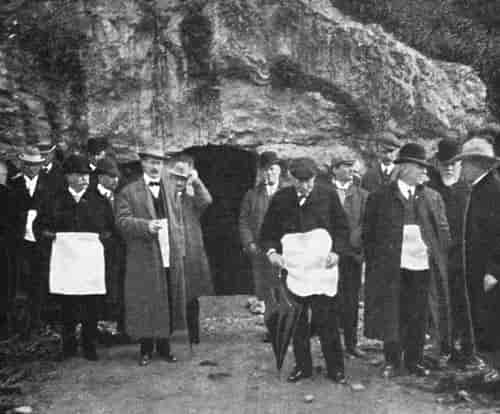 AT THE ENTRANCE TO SOLOMON'S QUARRIES.
AT THE ENTRANCE TO SOLOMON'S QUARRIES.A few minutes later we were admitted to a convent on the Via Dolorosa. One of the gray-gowned nuns, after exhibiting and offering for sale laces and embroideries made by the sisters, led us to an excavation in[Pg 238] the rear of the convent. There a courteous Abbess met us, and said: "The excavation made here uncovered a part of the original Via Dolorosa. The old way lies buried twenty feet below the level of the modern street known by that name, and at this place is one hundred feet to the right of the one on which you were walking."
"You must bear in mind the history of Jerusalem," continued the Abbess in reply to our questions. "Forty years after the Crucifixion Titus captured the city, demolished the buildings, and slaughtered the inhabitants. Jerusalem became 'heaps' and a 'desolation' as predicted by the holy prophets. For a century thereafter a village of huts built upon the ruins occupied the site of the city; then the idolatrous Emperor Hadrian rebuilt the city, laying out the streets to suit his pagan ideas, and for two centuries it was a pagan city whose people were devoted to the worship of strange gods and regarded not the sacred places. Three hundred years after the Ascension of our Savior, the blessed St. Helena, mother of the Emperor Constantine, made a pilgrimage from Constantinople to Jerusalem. Inspired with holy zeal, she gave orders for the erection of churches on the sites of the Nativity at Bethlehem and the Ascension at Olivet. She prayerfully sought for the sacred tomb in which the Lord had been laid, and her efforts were rewarded by the finding of the true cross. She cleared away the accumulated rubbish and built the chapel on the holy ground, and that chapel has grown into the great Church of the Holy Sepulchre. Afterwards the locations of the events on the way to the cross were marked on the modern street to corre[Pg 240]spond as nearly as possible to the places on the ancient street which lay buried many feet below. The finding of a part of the true Via Dolorosa in the excavation within our enclosure has been a blessing to the convent."
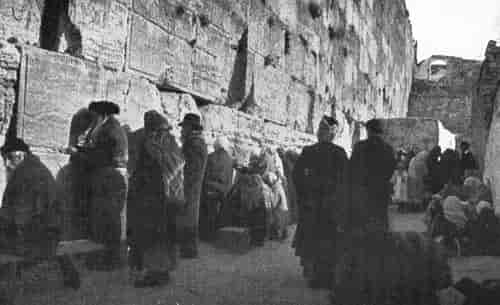 WITH FACE TURNED TO THE WALL, KISSING IT AND MUTTERING PRAYERS.
WITH FACE TURNED TO THE WALL, KISSING IT AND MUTTERING PRAYERS.The Abbess deserved and received more than spoken thanks for her courtesy. We realized then the truth of her last words.
During our walk we visited an old Armenian church, which was gaudily decorated with red brocade hangings and very antiquated paintings quaintly representing scenes from Bible history. In the court-yard of the church a young Armenian kindly offered us a pitcher of water, which he said had been brought from a spring outside the city for the use of the monks in the adjoining convent. We received it most gratefully, for the drinking water of Jerusalem is noted for impurity, and, as we had been cautioned against it, we had abstained from drinking water for three days.
"Will it be difficult for the tourists to find their way through the narrow crooked streets of the city without a guide?" inquired one of the ladies of the dragoman at the noon hour.
"Oh no!" he replied. "Please open your map. I notice you have one. You see that the city is divided into four marked sections by the two principal streets which cross each other at right angles: David street extending from the Jaffa Gate at the west, through the center of the city, to the Temple Area at the east; and Damascus street extending from the Damascus Gate on the north, through the center of the city, to the Zion Gate on the south. The bazaars and little stores[Pg 241] that tourists visit are on these two streets, on Christian street near the Church of the Holy Sepulchre, and in the vicinity of the Jaffa Gate. The Church of the Holy Sepulchre is in the north-west section of the city, known as the Christian Quarter; the Via Dolorosa passes through the north-east section, called the Moslem Quarter; the Temple Area is on the east side; the Wailing Place of the Jews is near the south-west corner of the Temple Area, in the south-east or Jewish Quarter; and the Citadel is in the south-west of Armenian Quarter. Jerusalem is not a large city. David Street is only half a mile in length, and Damascus Street from the gate on the north to the gate on the south is but three-fourths of a mile long."
"This afternoon," said the guide at the noon hour on Friday, "those of you who desire to do so may go with me to the Wailing Place of the Jews. The Turkish authorities do not permit Jews to enter the Temple Area so the Jews, on Friday afternoons, congregate in a narrow court, outside and adjoining the western wall which encloses the Temple Area, to mourn over the downfall of their beloved Zion and pray for the return of Jewish dominion over the land of their fathers, and for the renewal of the ancient glory of the City of David."
When we arrived at the Wailing Place, we found about a hundred Jewish men, women, and children assembled in the court, with faces turned to the wall, the men at one end of the court, the women at the other. Some of the mourners pressed their faces against the wall, kissing it and muttering prayers; some, as the guide[Pg 242] explained to us, were reading the Talmud; some reciting verses from the Lamentations of Jeremiah; and some chanting the penitential Psalms of David. Others we saw weeping, the tears running down their faces, while one or two looked around with curious gaze at the strangers.
 PITIED THOSE MISERABLE LEPERS AT THE GATE.
PITIED THOSE MISERABLE LEPERS AT THE GATE.Thence we returned through portions of the Mohammedan and Jewish quarters of the city. The narrow streets through which we passed,—if passage-ways ten feet wide may be called streets,—are lined with little stores. The stocks of provisions, groceries, bread,[Pg 243] vegetables, and general merchandise for native consumption are displayed in the open fronts of the shallow store-rooms and the proprietors sit or stand outside waiting for customers, like huge spiders waiting for their prey, or with loud voices and many gesticulations bargain with the buyers.
The streets of the Mohammedan Quarter are filthy; those of the Jewish Quarter are worse.
"Are these alleys ever swept or cleaned?" inquired one of the disgusted visitors.
"Oh, yes!" answered the guide, "the city, being built on the hills, has a natural drainage. Whenever there is a heavy rain the flowing water washes the streets."
"Well," said the visitor, "the city of Constantinople has the reputation of being the filthiest city in Europe, but it has a brigade of canine street cleaners to assist the rainfalls in cleaning the thoroughfares. If the city of Jerusalem were in Europe, it could easily claim the leading place in respect to filth; for dogs are few here and heavy rains do not appear to be frequent."
The tramp through these quarters was not agreeable to any of the senses. The ears were annoyed with the jargon of many dialects; the harsh voices of the natives, the loud exclamations of the dealers, and the whining cries of the beggars for backsheesh. The eyes were offended by the sight of the crowds of dirty beggars, who stretched out hands in appeal and tried to clutch the garments of the tourists with their dirty fingers, until disgust drove away all feelings of pity. The odors from the foul thoroughfares, from the messes of soft[Pg 244] cheese and mixtures of eatables offered for sale, from the discarded and decaying cauliflower leaves under neath the stalls, from the pipes of Turkish tobacco, and from the donkeys and unbathed human beings with whom the tourists came in close contact, were inhaled with loathing. The uneven, stone-cobbled paving of the narrow streets without sidewalks, the steps up and down the grades, and the slippery condition of the muddy surface when wet caused weary feet.
"I will not give away another piaster," exclaimed a lady whose purse had been drawn upon frequently during our tramp. "I never met such disagreeable beggars. There were many beggars in other cities, but they did not whine and display their dirty rags so disgustingly as these do. I pitied those miserable lepers at the gate, but when I threw them some money they crowded around and tried to touch me with their diseased hands, instead of keeping at a distance and crying, 'Unclean! Unclean!"'
The beggars were the most objectionable feature of the city; they persisted in following visitors and it was almost impossible to drive them away. When rid of one lot, others soon took their place. Repulsive cripples insisted on calling attention to their deformities; sore-eyed children clamored for assistance; and little tots with dirty, fly-covered faces, shrilly prattled "Backsheesh." The streets were full of these wretched creatures; they congregated near the sacred places and there the clamor was so annoying that the tourists had little opportunity for contemplation until they were inside the buildings and away from the beggars' entreaties.[Pg 245]
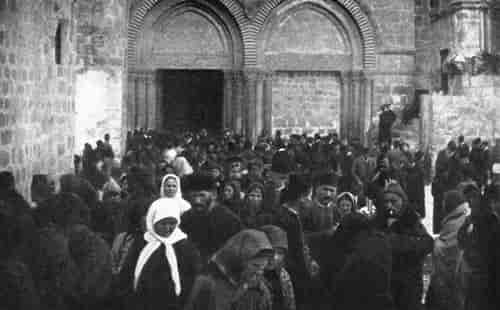 PILGRIMS FROM EVERY QUARTER OF THE GLOBE.
PILGRIMS FROM EVERY QUARTER OF THE GLOBE.We made several visits to the Church of the Holy Sepulchre in order to observe the people; to view quietly and leisurely the gorgeous decorations, especially those in the Greek Chapel where each visit disclosed new beauties; and to see the jewels, precious gems, and pictures encircled in diamonds, in the Chapel of Golgotha.
 PASSED OUT THROUGH THE DAMASCUS GATE.
PASSED OUT THROUGH THE DAMASCUS GATE.During one of these visits we sat for awhile on a bench by the wall of the church not far from the entrance to the Sepulchre. It was interesting to note the diversity of costumes and to watch the difference in the behavior of the tourists and pilgrims of the various nationalities.[Pg 247]
 I. FIELDS WERE COVERED WITH STONES.
I. FIELDS WERE COVERED WITH STONES. II. FAR BELOW LAY THE VALLEY OF JEHOSHAPHAT.
II. FAR BELOW LAY THE VALLEY OF JEHOSHAPHAT."Notice that Russian group," said a companion as a party of Russian pilgrims entered the church.
These people from the North, long-haired, heavy-bearded, long-booted, heavy-coated men, and short-frocked, heavy-shod women had come there, we could plainly see, on a holy pilgrimage to the tomb of their Savior, believing and trusting in the reality of everything they saw. At the Stone of Unction they prostrated themselves and kissed the stone slab, and as they rose we could see the shaggy-bearded men wiping away the tears with their rough hands. Then, with uncovered heads, they slowly approached the entrance to the Sepulchre, bowed down, crossed themselves, knelt inside, and after kissing the marble tomb, backed out, bowing and crossing themselves until well away from the tomb.
"The people of other nationalities outwardly show more reverence for the sacred places than do those of our own country," commented my companion. "The guards have just censured that group of Americans on the other side of the room. I could not hear what was said, but the actions of the guards spoke louder than words, and I noticed that the loud talking ceased at once."
The party of Americans came laughing and chatting toward the Sepulchre and entered the tomb without any appearance of reverence in their manner,—a striking contrast to the devout Russian pilgrims. Other Americans, however, following, entered the tomb silently, and came out with a look of awe upon their faces. One of these told us that he had placed some postal[Pg 249] cards and letters on the tomb to be blessed by contact with it before mailing them to his friends. Another had taken some bunches of flowers and laid them on the tomb for the same purpose before pressing them for souvenirs. A party of Germans stood near us for awhile, apparently arguing in low tones over some statement of the guide, and then quietly and with uncovered heads advanced and entered the Sepulchre. Some Italians knelt for a long time before the door, and Africans, Greeks, and natives of countries unknown to us, bowed or crossed their foreheads or breasts before the entrance. No other nationality, however, showed such zeal and intensity of feeling as did the Russian peasants.
On Saturday afternoon we visited the Church of the Holy Sepulchre to be present at the special service held on that day. We found that the number of guards at the door had been doubled, and that companies of armed Turkish soldiers had been stationed within to preserve order in the assembled throng of sight-seers and worshipers and to keep a passage-way open through which the expected processions might pass. Pushing our way through the crowd we obtained a good position behind some Syrian women and children who, attired in gala costumes, held unlighted candles in their hands. At the Place of Sepulchre the oriental lamps above the door and the candles in the huge candlesticks had been lighted for the special service, brilliantly illuminating the marble front of that small building and bringing into clear relief every detail of the carved ornamentation. In the Greek Chapel the golden lamps and the candles[Pg 250] at the altar were burning, and the chapel was ablaze with reflected glory.
"They are coming," whispered some one as the tramping of feet on the stone floor was heard.
A procession of Greek priests in gorgeous garments, swinging censers of smoking incense and bearing aloft a golden cross, marched to the Sepulchre, made obeisance there, then proceeded slowly around the building several times and entered the Greek Chapel where a short service was held. After the Greeks had left the building, a procession of Armenian priests appeared clad in black silk robes and peculiar looking black silk hoods draped over their heads. They were led by a venerable Patriarch arrayed in a magnificent embroidered robe. The Patriarch knelt and kissed the Stone of Unction, then the procession marched singing to the Sepulchre, which they entered, two priests at a time. After this part of the ceremony was concluded the priests marched singing three times around the room, while a bell in the gallery merrily clanged an accompaniment. When the Armenians had withdrawn, a procession of Roman Catholics entered singing. The chanting was accompanied softly by an organ in an adjoining chapel. The censer bearers waved their smoking bowls until the whole place was fragrant with the odor of the incense. Tonsured monks with sandaled feet, in gowns of brown, girt with hempen cord; censer bearers, cross bearers, brazier bearers, and choir boys in white embroidered surplices and skirts of scarlet; priests in black; bishops in purple; and higher dignitaries in capes of fur and long-trained robes,—all these marched round and round[Pg 251] bearing lighted candles and chanting the ritual to the strains of the organ, and then proceeded toward the Latin Chapel. Our Syrian neighbor and her children lighted their candles and joined other worshipers with candles in the rear of this procession, and we followed to the Chapel where all knelt for service.
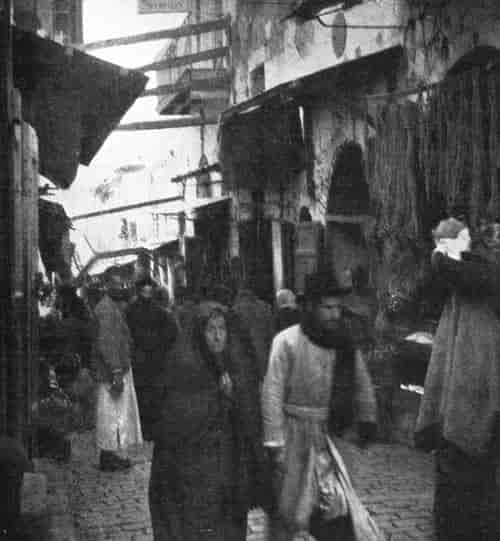 DAVID STREET IS ONLY HALF A MILE IN LENGTH.
DAVID STREET IS ONLY HALF A MILE IN LENGTH.Palestine appeared to us to be a land where history and tradition were so curiously mixed that it was difficult to know where history ended and tradition began. During our tramps around the city of Jerusalem and its vicinity the guides pointed out the spring where the Virgin Mary washed the clothes of the infant Jesus in the same way that we saw other women in the East washing clothes on the banks of public streams; the hill of evil counsel where the avaricious disciple had been tempted by gold to betray his Master, and the field where the horror-stricken traitor ended his life; the place just without the Gate of St. Stephen where the sainted Stephen knelt and prayed for his persecutors until the stones cast by the infuriated Jews crushed out his life; the spot where the Apostle James was beheaded, commemorated by the church of St. James which now stands on that location; the large room outside the Zion Gate in which the Lord washed the disciples' feet and partook of the Last Supper; the tomb of the wayward, long-haired Absalom, and the mausoleum that covers the resting-place of his father, King David; the footprint of Jesus in the rock and the hole made by His staff on the Mount of Olives; the imprints of the Savior's feet in the rocky floor made during the time of the scourging; the site of the house in which the Virgin lived with the disciple John after the Crucifixion.
Palestine was noted in olden times as a land flowing with milk and honey. At the Casa Nova we drank of the milk, the milk of the black-haired goats that fed along the hillsides, and ate of the honey, which was of delicious flavor. The Syrian waiters who served our[Pg 253] meals and also cared for our bedrooms were picturesquely dressed in long gowns of blue striped material falling to their ankles, and encircled with bright sashes, and these men at all times, whether making beds or serving tables, wore on their heads the red fez of Turkish subjects. The managers of the Hospice, the Franciscan monks, wore the garb in which the monks of that order are always seen, brown gown, rope girdle, rosary with pendant cross, and sandals.
On Sunday a cold rain fell during the day, making it unpleasant for sight-seeing and confining the travelers to the house during most of the day.
"How disappointing this is to be kept in the house by the rain," exclaimed a discontented tourist while watching the rain drops glide down the window-pane.
"Have you thought," said another who was busily engaged with guide-book and pencil, "that until to-day not one unpleasant day has interfered with our trip? The temperature has been neither uncomfortably warm nor disagreeably cold, but just delightful for the exertion of sight-seeing."
The tourists having made a request for some heat in the house, one of the gowned Arab servants carried a brazier into the reception room, placed a handful of charcoal in it and lighted a fire. As we gathered around the little fire trying to warm our hands, one could realize the scene many centuries ago, in the Palace of Caiaphas, when the soldiers coming in at midnight from the cold hills, kindled a fire in the midst of the hall, and Peter, shivering from cold and fear, joined the group around the brazier to warm himself.[Pg 254]
"I have been trying for the past three days," remarked an elderly clergyman, "to realize that these bare hills were once 'a land flowing with milk and honey,' producing 'grapes, pomegranates, and figs' in abundance. To-day I have been thinking of the changes that the tempests of a few short years have made in the hills of my own native state, New Hampshire, since the rapacious lumber-men have been denuding our mountains of the forests. There, the unprotected soil is being washed away by the heavy rains, gulleys have been formed, the brooks have diminished or dried up, and the part of our once beautiful White Mountains that has been cut over is desolate indeed. Now, since thinking of the changes that have occurred in a decade at home. I can more fully realize the changes that centuries have made here.
"Looking backward," said he, "I can see more clearly in my mind the picture that David saw with the eye of an artist, and described with the heart of a poet, when these bare, gray, rocky, treeless hills were crowned with forests that protected the soil from the beating storms; when these slopes, now furrowed with gulleys and spread with stones, were covered with orchards and clad with verdure, where the flocks might 'lie down midst pastures of tender grass;' and when these dried up waterways were purling brooks, where the flocks were 'led beside the waters of quietness.' I believe that David's description of this country was a true picture of the land as it appeared then. 'Thou waterest the ridges thereof abundantly; thou settlest the furrows thereof; thou makest it soft with showers; thou blessest the springing thereof. The pastures are[Pg 256] clothed with flocks; the valleys also are covered over with corn; they shout for joy, they also sing.'"
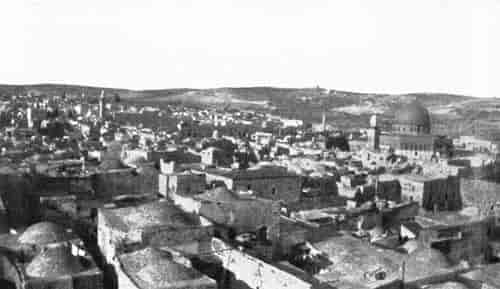 WHEN THESE BARE HILLS WERE COVERED WITH ORCHARDS AND CLAD WITH VERDURE.
WHEN THESE BARE HILLS WERE COVERED WITH ORCHARDS AND CLAD WITH VERDURE."In those days the vicinity of Jerusalem was beautiful with palm trees," continued the clergyman, "and the City of Palms was but fifteen miles away. Now the City of Palms is a squalid, unhealthful village, and in the vicinity of Jerusalem it is difficult to obtain a leaf of the palm."
The low spirits caused by the drizzling rain during our last evening in the Sacred City were increased by telegraphic news received from Jaffa. The telegram stated that the weather was stormy and the waves running high, and that if the sea did not subside we might not be able to embark. This information caused considerable anxiety among the timid members of the party and many surmises were made as to the developments of the following day. As usual, all the arrangements for our departure had been carefully made in advance by our managers. We were notified that the Syrian bell boys would waken us at five o'clock, and our baggage must be ready at five-thirty; breakfast would be served at six o'clock; the carriages would be at the Jaffa Gate at six-thirty; and the train would leave the Jerusalem station at seven.[Pg 257]
CHAPTER XIII.
CAIRO AND THE PYRAMIDS.
On Monday morning, after enjoying our usual breakfast at the Casa Nova of boiled eggs, rolls and pure honey, good coffee, and delicious oranges, we bade farewell to our tonsured hosts and the staff of gowned attendants. The carriages were waiting near the Jaffa Gate to convey us to the station. The train moved off promptly at the appointed hour, and looking backward, we took our farewell glimpse of the Tower of David and the yellow walls of the Holy City.
During the three hours' ride to Jaffa the threatening clouds passed away, the sun re-appeared, the rough winds changed to soft breezes, and our depressed spirits rose correspondingly. By the time the orange groves in the suburbs of Jaffa came into sight, the tourists were in a gay and cheerful humor. But when we arrived at the pier of Jaffa, we discovered that the sea still felt the effects of the gale. The surf was rolling high and the angry waves were breaking violently over the ugly-looking rocks in the harbor, hiding them for an instant from view and sending the snowy spray high into the air. As we looked out toward the Moltke riding at anchor a mile away, many of the gay faces became sober. The boatmen holding the tossing boats to the pier urged us to embark.[Pg 258]
"But timorous mortals start and shrink to cross the narrow sea,
And linger trembling on the brink and fear to launch away"
"Oh, I cannot venture! Go without me! Leave me behind!" exclaimed one of the ladies, trembling and almost fainting through fear. "Those black rocks momentarily emerging and disappearing seem like the heads of terrible monsters waiting to devour us as soon as we come within their reach."
"Do not be alarmed," said one of the officials on the pier, encouragingly. "The sea, as you say, has a threatening look, but I assure you that if there were any danger we would not permit you to attempt the passage. These Syrian boatmen have been carrying passengers for years and know every rock in the harbor. They brought the Damascus tourists from the Moltke without mishap this morning when the sea was rougher than now. Trust the boatmen and you will soon be safely on board the steamer."
As our boat in its passage over the stormy billows plunged downward into the trough of the sea, and horizon, ship, and land were hidden from view, we thought that the uplifted, on-coming crests of the waves would engulf the boat beneath them; but, expertly handled by the trained rowers, the craft rose with each immense surge and safely passed the breakers. The Syrian boatmen, who had been continually chanting their hymns to Allah while plying their oars, suddenly stopped singing.
"Bachsheesh! Backsheesh!" they cried, ceasing to row, while one of them, doffing his fez, passed it around the boat for contributions. The passengers, grateful[Pg 260] for safety, dropped their coins into the fez; again the oars were put in motion, the chant was resumed, and in a few minutes the boats were alongside the vessel.
 SHE WAS WASHING CLOTHES IN THE CANAL.
SHE WAS WASHING CLOTHES IN THE CANAL.Then came the difficulty of getting on board the steamer; for the little boat lay underneath the platform at the foot of the ship's ladder, tossed by the billows. As each heaving swell, however, bore the boat upward, two sturdy seamen on the platform, reaching down, grasped a passenger's arms and drew him up while the boatmen assisted from underneath. In this way, one with each wave, the tourists safely embarked. The passage from the pier to the steamer affected the tourists in various ways: many were frightened, notwithstanding the assertion of the official that the dangers were more apparent than real; others were exhilarated by the tossing waves and enjoyed the thrilling experience.
"I was so interested in watching the muscular development of the boatmen as they pulled at the oars, and in admiring the dexterity and skill with which they managed the boat, that I did not think of danger," remarked a man who had been stroke oar on a college crew.
While the tourists were being transferred to the ship, the band on deck was playing "Home, Sweet Home," and the Captain and other officers standing at the head of the stairway gave a friendly greeting to the wanderers as they came on board.
"It is pleasant to be welcomed back in this friendly manner," remarked one of the ramblers to another as they entered their cabin, "and then it is so homelike here in our stateroom, with our photographs and nick-nacks pinned around the walls."[Pg 261]
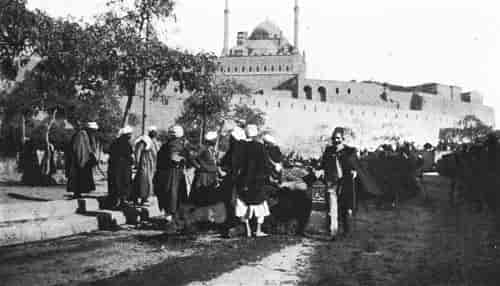 BELOW THE CITADEL WE SAW AN OPEN-AIR MARKET.
BELOW THE CITADEL WE SAW AN OPEN-AIR MARKET.A busy afternoon of re-packing followed the departure from Jaffa, for on the following day the tourists were to leave the steamer at Alexandria to remain twelve days in Egypt. Clothing that was considered suitable for the climate of that warmer region was carefully selected and condensed into the smaller receptacles, and every article that the tourists supposed would not be required was left in the staterooms.
On Tuesday morning, March tenth, at seven o'clock, the Moltke was anchored in the commodious port of Alexandria, which is enclosed by long stone breakwaters that have been built into the sea to protect the harbor. Many vessels were at the docks or at anchor in the port, and a handsome white yacht flying the imperial flag of Germany lay within a stone's throw of our steamer.
"The Crown Prince of the German Empire is visiting Egypt and that is his yacht," said one of the officers.
The morning was bright and clear. It was a delight to breathe the warm salt air and feel its invigoration. Overhead the sky was brilliantly blue and the sea reflected it in various hues.
"Did you ever see such wonderful coloring on the waters of sea or river?" asked an enthusiastic beholder. "Near by the sea sparkles in the morning sunlight in azure and olive and darkens into sapphire and emerald, and there beyond the breakwater it changes to tints of violet and purple. I have heard that the colors of the Mediterranean are beautiful; now I know they are."
The row boats that were to carry us ashore gathered around the steamer. The bare-footed boatmen, with faces of various shades from light yellow to intense[Pg 264] black, were attired in red fez, white bloomers, and long red sweaters.

 AT THE NILE BRIDGE WE WAITED FOR THE DRAW TO CLOSE.
AT THE NILE BRIDGE WE WAITED FOR THE DRAW TO CLOSE.At the custom house on the dock the custom officials accepted the statement of the managers that the baggage of the tourists contained nothing dutiable, and the baggage was passed without examination. A special train was on the pier ready to convey the party to Cairo. Beggars and peddlers attempted to approach the train to ask alms or sell their wares, but were driven away with whips by black Nubian soldiers in dark blue uniforms, who appeared to take delight in snapping at the bare legs of the intruders.
It was just noon when our train, the second special section, moved out of Alexandria through long rows of large warehouses; for Alexandria is the chief seaport of Egypt and exports the cotton, grain, sugar, rice, and other productions of the valley of the Nile. As the train passed rapidly southward through the delta of the Nile, we realized that we were in a land entirely different from any that we had previously visited. The trip of one hundred and thirty miles to Cairo will be remembered by the tourists as a panoramic succession of interesting pictures of agricultural life. The land on both sides of the railway was a black, sandy loam, level almost as a floor, intersected and broken only by the canals and irrigation ditches. For some distance out of Alexandria the Mahmudiyeh canal was in sight.
"There is a scene that is familiar to me!" exclaimed one of the party. "A landscape hanging in the art gallery of our city represents the light blue water of a canal mirroring tufted palms and wing-like sails. It[Pg 266] was painted by a noted artist, who has successfully reproduced many beautiful Egyptian views."
 "WANT A GUIDE? WANT A GUIDE?" THEY INQUIRED.
"WANT A GUIDE? WANT A GUIDE?" THEY INQUIRED.Nile boats with breeze-filled canvas, caravans of camels on the embankment of the canal, and trains of donkeys laden with marketing for the city by the sea, seemed stationary as we rushed by. The land appeared to be thoroughly cultivated. There were no fences or waste corners in sight. Every foot of workable ground was utilized for raising crops.
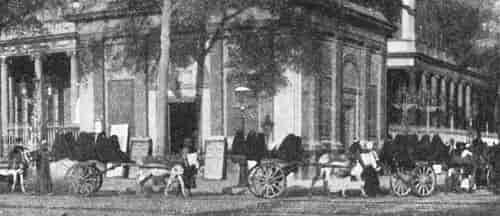 EACH ARAB'S CART CONTAINED HIS WIVES.
EACH ARAB'S CART CONTAINED HIS WIVES."Irrigation makes this almost rainless region the most fruitful on the globe," remarked one of the managers of the tour. "By the aid of irrigation the Egyptian farmers can raise two or three crops every year. To do so, however, they must labor incessantly and give the land thorough cultivation. Irrigation with them is not opening the gates of a sluiceway and letting the water flow over the land. It means severe labor, pumping the water up from the ditches, canals, or river, in which the surface of the water may be ten or[Pg 268] twenty feet below the surface of the land. The pumps are the same kind that the people used in the days of the Pharaohs, and the methods of cultivation are the same as in those ancient times, without modern agricultural implements or modern machinery. Three crops, therefore, does not mean great prosperity, but simply enables the Egyptian farmer to pay taxes that would seem enormous to an American farmer, and then to have a surplus sufficient to supply his very moderate wants."
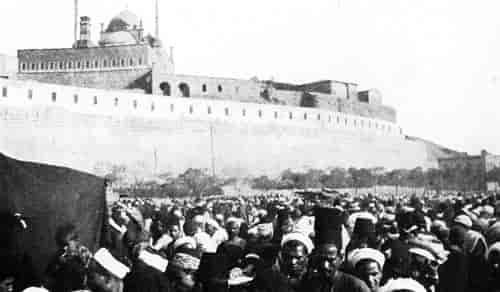 WHERE EGYPTIANS OF MANY TYPES WERE ASSEMBLED.
WHERE EGYPTIANS OF MANY TYPES WERE ASSEMBLED.The monotony of the level stretches was varied by groups of palm trees whose tall rough trunks upheld graceful heads of outstretched, drooping leaves, and by villages of small mud huts roofed with stalks of sugar-cane, sufficient, we imagined, in that dry country, to protect the inmates from the burning noonday heat, and to shelter them from the chilling night dews. Occasionally the train stopped at large and apparently prosperous towns, where there were substantial stone buildings and busy factories. At these stations Arab venders offered coffee, lemonade, fruit, and other refreshments to appease the hunger and thirst of the travelers.
The fields were full of life. Each cultivated acre had its dark-hued laborers with hoes, or bare-legged toilers drawing water from the ditches for irrigating the thirsty land, or plowmen guiding teams of ungainly, striding camels or dark gray, crooked-horned oxen. In the lush meadows many of these curious-looking animals were grazing. The camels, the small donkeys, and the gray oxen or water-buffaloes as the natives called them, tied to stakes, were restricted to the pasturage[Pg 270] within reach of their tethers. Along some of the irrigating canals naked dark-skinned men and boys splashed about in the water, or stood unabashed on the bank of the stream, gazing at the passing train.
 I. SMALL AND HAZY IN THE DISTANCE.
I. SMALL AND HAZY IN THE DISTANCE. II. "MADAM MIGHT DROP HER SHAWL."
II. "MADAM MIGHT DROP HER SHAWL.""Look at that scene," cried one of the passengers. "I wonder whether our cattle at home would not enjoy similar treatment."
In the canal some naked boys were mounted on a buffalo, and near them an Arab, also in the water, was scrubbing the back of another buffalo, to the evident enjoyment of that animal.
As we approached Cairo, the great valley of the delta narrowed, and mountain boundaries loomed up in the distance. Far away to the right the tops of the Pyramids, looking very small, silhouetted the sky. On the left, high hills broke the landscape, and presently the buildings and minarets that crowned the hills were outlined on the horizon. Handsome villas, beautiful gardens, good roads, and increasing traffic in the suburbs indicated the nearness of a prosperous city.
Just four hours after leaving Alexandria our train entered the station at Cairo, where hotel-runners, cab-men, and porters gave the passengers a noisy reception. Complete arrangements having been made in advance for our party, we had time to take in the novel sights leisurely. The party had been divided into two sections; one section booked for the famous Shepheard's Hotel, the other section for the Hotel Grand Continental. The avenues through which we were driven on the way to the Hotel were bordered with large shade trees. The streets were full of life. The buildings were modern,[Pg 272] seemingly of French style, with a mixture of Oriental architecture.
 I. THE SAND HAD BEEN SHOVELED AWAY FROM THE SPHINX.
I. THE SAND HAD BEEN SHOVELED AWAY FROM THE SPHINX. II. THE GRANITE TEMPLE, REMAINS EMBEDDED.
II. THE GRANITE TEMPLE, REMAINS EMBEDDED."What a contrast," said one, thinking aloud of the city we had left but two days ago, as our carriage glided smoothly over the well paved highways. "Did two cities ever present a stronger contrast than Jerusalem, with streets narrow, rough, filthy, and depressing to the spirits, and Cairo, with avenues broad, smooth, clean, and pleasing to the senses? The interest in the city of Jerusalem had to be stirred by the memorials of the sacred events of the past; the discomforts of the present had to be overlooked. The city of Cairo appeals to us at once as a pleasure ground with attractions on all sides, and the promise of comfortable surroundings."
The hotels of Cairo are famous throughout the world for the magnificence of their appointments, the cosmopolitan character of their guests, and the novelty of the sights that may be seen at their doors. When we drove up to the Hotel Grand Continental, a military band was giving an afternoon concert in the beautiful Esbekieh Gardens opposite the hotel. On the wide pavement in front of the piazza of the hotel, dragomen in elaborate Arabic costumes were offering their services as guides or interpreters. "Want a guide? want a guide?" they inquired of all strangers who they thought might need such service. Arab urchins, whose hands may have once been clean, offered picture postal cards for sale; bootblacks solicited patronage and beggars asked for alms; match peddlers endeavored to dispose of their little boxes; flower sellers thrust their bouquets forward into notice; dealers in scarabs and miniature mummy[Pg 273] cases proclaimed the virtues of their charms; and venders of beads offered endless varieties of their fanciful, colored Egyptian wares. Interest in the scene was heightened by the variety of the characteristic flowing gowns peculiar to the natives of Egypt. On the piazza, groups of guests were taking afternoon tea, and listening to the music in the park opposite, or, seated comfortably in wicker chairs, found amusement in watching the animated throng on the sidewalk; in observing the arrivals and departures on donkeys and in victorias; and in viewing the constant panoramic procession on the street.
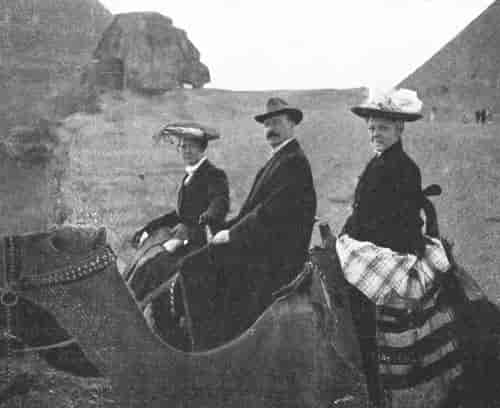 MAY TAKE CAMELS OR DONKEYS AND RIDE.
MAY TAKE CAMELS OR DONKEYS AND RIDE.The head porter, in gorgeous uniform, received us with the air of a proprietor; Arab bell boys in bright red silk gowns responded to the call of the manager and conducted us to our rooms; and Arab men in white gowns brought up our luggage. There were French maids on each floor to attend to the calls of the ladies; but Arab men in spotless robes made the beds, cared for the rooms, and took the place of chambermaids. These Arab men were seated in the wide halls when not employed at their tasks, but whenever a guest approached they rose and stood at attention, appearing very tall in their white drapery. In the dining room the English head waiters in dress suits contrasted strangely with the dark-skinned Arab waiters in handsome silk gowns of various colors.
On the evening we arrived in Cairo the large gardens of Shepheard's Hotel were beautifully illuminated with thousands of electric lights and hundreds of Chinese lanterns festooned among the shrubbery. Two military bands alternately played selections from favorite composers during the evening. An exhibition of fire-works made a brilliant display, and this was followed by a "battle of confetti" in the garden and a dance in the hotel. Our party bought packages of paper confetti and joined the gay crowd of merrymakers in casting handfuls of the colored squares of paper at each passer-by. At the dance the great variety of handsome uniforms worn by the English officers attracted our attention, the red jackets of some of the men being particularly noticeable among the light gowns of the French and English women.[Pg 275]
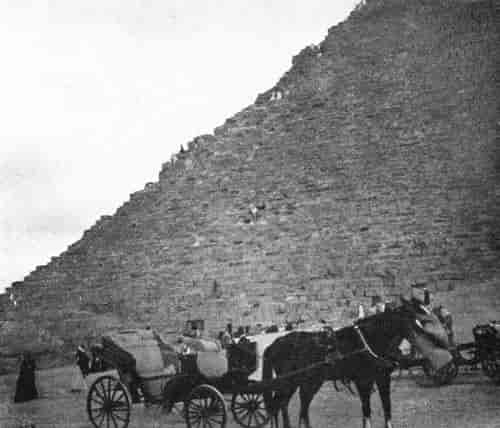 THE CLIMBERS DWINDLED IN SIZE.
THE CLIMBERS DWINDLED IN SIZE.Plans to utilize our time to the best advantage were carefully made, so that during our one week in Cairo we might give precedence to the places of particular interest, and see them at the most suitable hours.
 AFTER REACHING THE TOP OF CHEOPS.
AFTER REACHING THE TOP OF CHEOPS.When we visited the Egyptian Museum, the wealth of antiquities displayed within its commodious and well-lighted halls held us with a grasp from which it was difficult to break loose. The mummies of the old kings who had been dead for thirty centuries urged us to remain. "We will tell you the story of remote ages,"[Pg 276] they seemed to say. There Ramses II, with gray hair, thin beard, and pierced ears, the great conqueror, builder of temples, erector of statues, and maker of history, lay peacefully at rest. His lips were firmly closed, his hands folded across his breast. His high forehead indicated the judgment with which he governed, and the strong nose suggested the greatness of his power. And near him, in hieroglyphic-covered coffins, reposed Seti I, constructor of magnificent edifices; Ramses III, oppressor of the Israelites; and many other famous kings, queens, priests, and warriors. The wooden statue of a village sheik with good-natured face and crystal eyes,[Pg 278] and the tinted limestone, lifelike statues of Prince Rahotep and his wife Nofret, could they have spoken, might have revealed the secrets of ages long before the times of the mummies; and the gray stone figure of Chepren, which was found in the well of the temple of Gizeh, might have explained the mysteries of pyramid and sphinx.
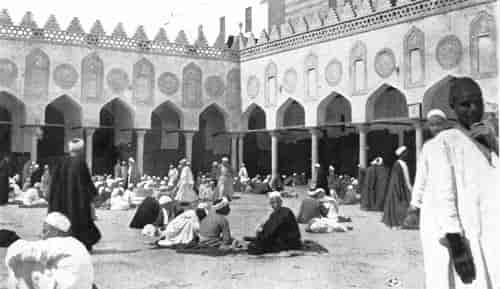 IN THE UNIVERSITY THE STUDENTS WERE SEATED ON THE FLOOR.
IN THE UNIVERSITY THE STUDENTS WERE SEATED ON THE FLOOR.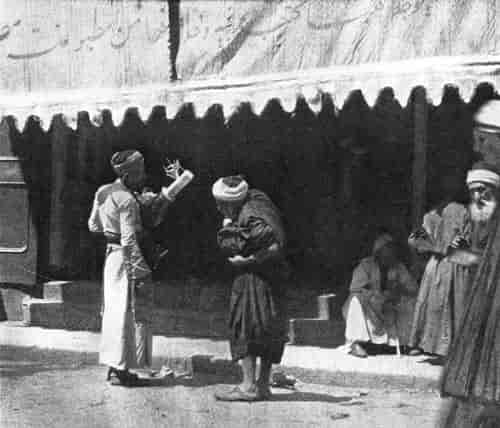 THE PENNIES APPARENTLY CANNOT BE FOUND.
THE PENNIES APPARENTLY CANNOT BE FOUND.From the parapet of the citadel which crowns the heights above Cairo, we gazed at the extended view of roofs, mosques, minarets, and tombs of caliphs, and[Pg 279] listened to the story of the massacre of the Mamelukes and the legend of the one who marvelously escaped by leaping on his horse over the parapet to the ground sixty feet below. To convince us of the truth of this legend, the dragoman showed the impression of the horse's hoofs in the stone coping on the wall. The large Mosque of Mehemet Ali, on the heights, is built of pure alabaster and carpeted with costly rugs. The older Mosque of Sultan Ahmed, at the foot of the citadel hill, is built of sandstone taken from the Pyramids, and, although partly in ruins and with bare stone floors, it is yet beautiful.
"This mosque make Ahmed glad. He not want another built like it, so he chop hand off architect," explained our good-natured dragoman, whose control of English was limited, but he endeavored to relate the legends and give information.
While returning from the citadel we came by an open-air market, where Egyptians of many types were gathered in groups around piles of merchandise and vegetables. Here our camera man, taking advantage of an opportune moment, caught a dense mass of faces before the natives became aware of his presence.
On Friday afternoon we visited the Monastery El Akbar to see the religious exercises of the Twirling Dervishes, which take place there every Friday afternoon. The shrill music, the fanatic faces, the obeisance to the leader, the whirling men, the naked feet, and the never-touching skirts, just as we beheld them, are pictured vividly by Canon Rawnsley, in his "Idylls and Lyrics of the Nile."[Pg 280]
THE DANCING DERVISHES.
We drove from Cairo to the Pyramids of Gizeh, a distance of ten miles, over a substantial macadamized avenue. This broad highway, elevated eight or ten feet above the adjoining lands in order to protect it from the flood of water during the time of inundation, was bordered for seven miles with large shade trees, and was in perfect condition. On one side of the avenue an electric tramway extended from the bridge at Cairo to the Mena House Hotel near the Pyramids.
"We might have reached our destination more quickly in the cars," said our manager as an electric car sped by us, "but at such speed we should have missed much that is strange and curious. We thought it preferable to take the trip in open carriages."
The scenes along the way as we drove to the Pyramids were indeed novel. In the gardens in the environs of the city, the cabbage, onions, beans, and strawberries were in readiness for the market, and in the fields, the clover and forage plants, dark in color and luxuriant in growth, were ready for the sickle, but the wheat was yet green. The fellahs—the Egyptian farm-laborers—were cutting the rank clover in square patches and stacking it on the backs of camels or donkeys. Along the road stalked camels beneath huge stacks of fragrant clover, and donkeys so laden with newly-cut forage that only their heads and feet could be seen. A crooked-horned ox with an Arab farmer on his back ambled by. A caravan of camels laden with blankets, tents, and military supplies, accompanied by a guard of white-helmeted English soldiers, almost blocked the road as they marched past. Bronzed-faced natives seated[Pg 282] in the shade dealt in sugar-cane stalks, cutting pieces of cane from the pile of stalks beside them as they were sold. Turbaned Arabs sauntered by, chewing with evident enjoyment the sweet stalks which they had purchased. Bedouins from the desert rode past on camels bedecked with tasseled trappings, swaying back and forth as they rode. Women, partly veiled, coming from the wells, balanced on their heads large earthen bottles filled with water.
"There are many pyramids," said the guide, as our carriage emerged from the shade of the trees and the Pyramids were seen in the distance, "but Cheops is the greatest, and it is the one that is ascended by visitors; the other Pyramids are viewed at a distance but are visited by few. Cheops is four hundred and fifty feet in height and each side of the base measures seven hundred and fifty feet. It was originally much larger and higher but the outer layers of stone were torn down and carried away to Cairo to build mosques and palaces. The adjacent Pyramid of Chepren is almost as large but as some of the steps are cased, it is more difficult to ascend. When we arrive at the pyramids you may take camels or donkeys and ride around the base of Cheops. Or if you prefer to go on foot, you may walk around it, but walking in the sand is tiresome. Then we will proceed to the Sphinx and, after viewing it, descend to the excavated temple near the Sphinx. Afterwards, those who feel equal to the exertion may climb to the summit of Cheops. As this Pyramid is built of huge blocks of stone about three feet in thickness each step upward requires some effort. The[Pg 284] Bedouins, however, will assist you in the ascent, two of them mounting the step ahead and drawing you up while a third pushes behind."
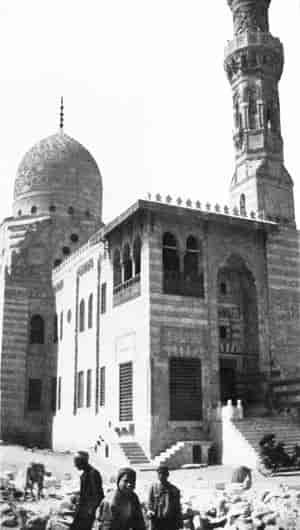 THE TOMB MOSQUE OF THE KHALIF KAIT BEY WAS THE FINEST.
THE TOMB MOSQUE OF THE KHALIF KAIT BEY WAS THE FINEST.As we neared them, the Pyramids, which at first had seemed small and hazy in the distance, became distinct and grew in size. When very close to them they appeared enormous, but their magnitude was not fully appreciated until some hours later, after we had tramped through the sand around the four sides of great Cheops. After that walk, a distance of more than half a mile, we could judge with greater exactness the immense proportions of the extensive base. The slope of the sides prevented a fair conception of their height when looking upward at them; but after reaching the top of Cheops, panting with the exertion of the laborious climb in which we had been assisted by three Bedouins, we looked down at the midgets moving on the sand below, and were convinced that the altitude stated by the guide was not exaggerated.
The Pyramids of Gizeh stand upon a plateau about four hundred acres in extent, which appeared to be thirty or more feet above the level of the surrounding country. The surface of this plateau is a barren sandy tract, bordered by cultivated land on the side toward the Nile and merging on the west into the Libyan desert which stretches to the distant hills. Just as far as the inundation of the Nile spreads or the irrigating water was pumped, the land was fertile; where the surface rose above the height reached by the water, the land was a barren waste. Almost as suddenly as landing from an emerald sea on to a desert shore, we stepped from a rich growth of verdure to a bare slope of yellow sand.[Pg 285]
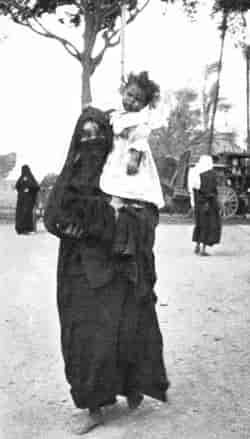 ASTRIDE ITS MOTHER'S SHOULDERS.
ASTRIDE ITS MOTHER'S SHOULDERS.At the foot of the Pyramid of Cheops a gesticulating, vociferous throng of Bedouins crowded about us, shouting in Arabic mixed with a few intelligible English words. Camel-drivers and donkey boys offered the services of their animals to make the circuit; helpers, almost dragging us away in their eagerness, insisted that we should climb to the summit; and guides with candles in their hands importuned us to accompany them into the gloomy interior. After a selection of camels and donkeys had been made by those who desired to ride, the clamorous crowd of natives separated, and we were allowed to start accompanied by but a few, who followed in case they should be needed. "Madam might drop her shawl, or want her umbrella carried, or need an arm to steady her in the saddle," explained the guide.
"For scores of centuries," remarked the professor,[Pg 286] as we stood before the Sphinx, "the strong winds from the west have carried particles of sand from the desert and deposited them around the Pyramids. Now the original base of Cheops lies twenty or thirty feet beneath banks of sand and debris that have collected around it. In the same manner the encroaching particles, drifting like the light dry snows of the prairies, have almost engulfed the Sphinx. Many times in the past the sand has been shoveled away to prevent the Sphinx from being hidden from sight, and if this excavation in which it now stands should be neglected for a time, the desert winds would fill the pit again and gradually cover the monument. The Granite Temple adjacent to the Sphinx was covered over so completely in the progress of centuries that its location was forgotten. It is but fifty years since the French archæologist Mariette discovered and excavated the interior of this large structure, the exterior of which, as you see, yet remains embedded in sand as far as the capstone on the walls."
After descending the steps that led down to the floor of the buried temple and passing through rooms constructed of blocks of alabaster, we stood in the main hall, surrounded by monolithic pillars of granite which supported enormous blocks of the same material overhead. The guide said that these huge blocks of granite had been brought from quarries at Assuan, far up the Nile, but he could not tell how the ancient Egyptians had been able to handle the monoliths.
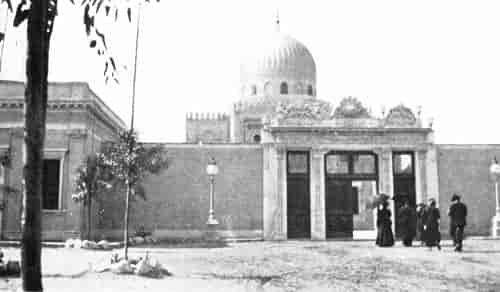 ENTERED THE FAMILY BURIAL MOSQUE OF MOHAMMED ALI.
ENTERED THE FAMILY BURIAL MOSQUE OF MOHAMMED ALI."My theory may not be correct," said the professor, as we turned to him for a reply to the query[Pg 288] "but I will state it. We know how the great blocks of limestone that were used in the erection of the Pyramids were brought from the Libyan mountains; for the father of history, Herodotus, relates the story. He says that the Egyptians constructed a solid road sixty feet wide of polished stone from the quarry in the Lybian mountains and over this smooth roadbed dragged or rolled the huge blocks. He also states that as the work progressed, these blocks were lifted by machines from step to step and imbedded in their places in the pyramid. When granite or other stone had to be brought from a great distance for the erection of temples and palaces, as for this granite and alabaster temple of the Sphinx, the Egyptians probably adopted the simplest way of conveying the material in a land where task-masters drove tens of thousands of slaves to labor on the public works. That is, they probably excavated canals from the Nile to the quarries, supplementing these, where necessary, with stone roadways or slides, and made other canals from the Nile to the location selected for the buildings, and transported the unwieldy masses of stone on barges to their destination."
"I made some calculations for comparison last night," continued the professor, seeing that we were interested in his statements. "Professor Petrie, the archæologist, says that there are over two million large blocks of stone in the Pyramid of Cheops, or ninety-two million cubic feet."
"Now, Professor," said one of the ladies, interrupting him, "you are getting above our comprehension when you soar into millions."[Pg 289]
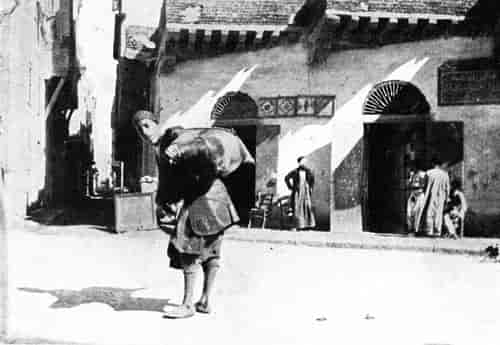 BEARING ON HIS BACK AN UNWIELDY GOATSKIN.
BEARING ON HIS BACK AN UNWIELDY GOATSKIN."Am I?" he replied. "Well, I will leave the millions and give you something more familiar. The Capitol at Washington is seven hundred and fifty feet long,—just the length of each side of the base of Cheops,—but the Capitol is not half that in width. The Capitol covers an area of three and one-half acres; the Pyramid spreads over thirteen acres. The apex of the Pyramid is one hundred and sixty feet higher than the head of Freedom on the dome at Washington. The Capitol is a hollow structure; the Pyramid, a solid mass, excepting the comparatively small chamber of the tomb and passage ways. The stone used in the construction of Cheops would be sufficient to build the Capitol and the Library of Congress, and there would be enough material[Pg 290] left over for capitol buildings in each of the states in the Union. When you have time, calculate how many miles of stone wall might be constructed with ninety-two million cubic feet of stone. It is only by comparison that we can comprehend the stupendous bulk of these magnificent monuments, and realize the prodigious amount of labor that was required for their erection."
It was but a short drive from the Hotel Grand Continental to the Muski, the narrow street that is the centre of the bazaar district, a district which every visitor is sure to find soon after his arrival in Cairo. When we entered the crowded Muski, we left the broad avenues of the modern city behind and walked in narrow Oriental streets through which carriages are not allowed to go.
"Everything is novel and interesting in this busy thoroughfare," said one of our party. "I suggest that we move along very slowly and stop frequently. See that lemonade vender with the brass tank strapped to his back. When he bent forward the water flowed from the spout over his shoulder into the cup he held in his hand, without his touching the tank. He is waiting for his customer to produce the pennies that apparently cannot be found."
The street scenes in the Muski were so kaleidoscopic that it is impossible to give more than a suggestion of their character. A few representative scenes can be given and around these the imagination must picture a constantly changing throng, not hurrying as in busy American cities, but moving leisurely in the Eastern manner. The crowd was orderly, but not quiet, for[Pg 292] tongues were in constant use. Merchants and customers chattered and parleyed. Venders of licorice water and sweetmeats did not permit their presence to be overlooked, and donkeys occasionally joined in the chorus. Each figure unfamiliar to our Western eyes, in turban or in fez, in slippers or in bare feet, in scant gown of cotton or full robe of silk, was a subject worthy of being considered individually.
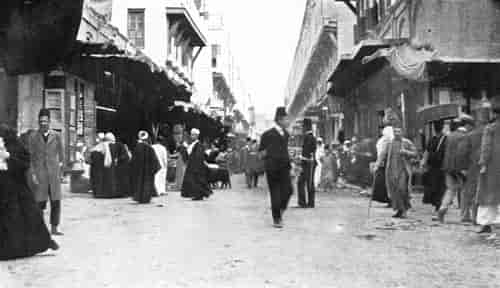 FIGURES UNFAMILIAR TO OUR WESTERN EYES.
FIGURES UNFAMILIAR TO OUR WESTERN EYES.A baby, astride its mother's shoulder, clung to her head while she walked along and made her purchases, apparently unconscious of her child. A bare-footed water carrier, bearing on his back an unwieldy goatskin distended with its contents, cried, "Water for sale." A donkey boy pushed aside the crowd to let the closely veiled, silk-mantled lady rider pass through on her caparisoned donkey. Muscular fellahs, or peasants, in brown skull caps, and blue shirts which reached to their ankles, their feet bare, their teeth remarkable for whiteness, sauntered along chewing stalks of sugar-cane. Women of the poorer class passed by, wearing scanty gowns of plain blue cotton, heavy copper bracelets, and nose ornaments of brass, which held in place the veils that covered the lower part of their faces but did not conceal the beauty spots tattooed on their foreheads. A funeral procession, with professional mourners chanting monotonously a hymn to Allah, followed a casket borne on the shoulders of men. And these curious scenes, which we tried to catch with the camera, formed but unimportant parts in an ever-moving picture in which were intermingled the costumes, colors, and facial characteristics of dervishes, priests,[Pg 293] and soldiers, of Arabs, Nubians, Turks, and Americans.
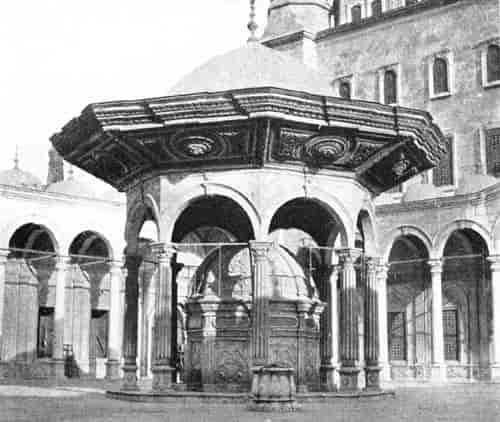 IN THE COURT OF THE ALABASTER MOSQUE IS A FOUNTAIN.
IN THE COURT OF THE ALABASTER MOSQUE IS A FOUNTAIN.The Muski and the crooked little passage-ways that intersected it were lined with small shops where many of the dealers sat cross-legged on platforms within arm's reach of their stock of goods. The stores for the sale of each kind of goods had a special quarter of their own. At one place we saw the shops of the coppersmiths with stocks of bright kettles, pitchers, basins, trays, and pans; at another, the stores of the shoemakers, where hundreds of bright red slippers dangled on lines over[Pg 294]head. In one crooked alley, but four feet in width, we watched the goldsmiths, squatted in narrow quarters, busily at work with brazier and blowpipes and curious little tools, hammering, twisting, and welding chains of gold, and making ornaments of silver filagree.
We bought souvenirs at the stalls of the fez dealers, where but one style of headgear was sold, always red in color, and with prices varying according to the quality of the cloth and lining. We stopped at the warerooms of the brass-smiths, which were larger in size than the ordinary shops, and found these filled with an array of hammered trays, censers, bowls, tankards, curiously wrought lamps, and ornamented candlesticks, that attracted many buyers. We looked into the little factories of the saddlers, which were gay with red and yellow trappings for donkeys and horses, and where the saddlers were stitching with bright colored-threads.
The light open-front workshops of the makers of hempen camel harness were hung with the twisted rope and tassel adornments of variegated colors with which the Bedouin delights to array his ship of the desert. The stores of the grocers were adorned with long decorated candles suspended by the wicks. We saw hundreds of tiny bazaars for the sale of perfumes, placed side by side in a narrow lane where the air was scented with musk and attar of roses; and we walked through narrow streets where, each kind in its own section, earthen water jars, lanterns, books, ornamented leather work, gems, and precious stones were displayed for sale.[Pg 295]
The guide insisted that we should spend a little time in the carpet stores in a side street. We yielded to his entreaties, and were surprised by the immense stacks of exquisite silk rugs; but to the courteous salesman's offer to show us everything in his place, we were compelled by lack of time to reply, "Another day." When we arrived at the more prominent silk bazaars, the ladies wished to buy some light shawls interwoven with gold thread and table covers embroidered with silk. They soon found out, however, that, as in the other Oriental cities, much time would be required for bargaining, and so the shopping was put off until the sight-seeing was over.[Pg 296]
CHAPTER XIV.
LUXOR AND KARNAK.
The Nile party No. 2, consisting of forty-two persons, left Cairo on Friday morning, March thirteenth, in sleeping cars. The cars were painted white outside, finished in cherry inside, and divided into rooms, each room having two comfortable berths and a washstand, and a passageway along the side of the car. We ate our dinner that evening and breakfast the following morning in a modern dining car attached to the train.
At nine o'clock on Saturday morning the train arrived at our destination, the town of Luxor, about four hundred miles south of Cairo. The Hotel de Luxor, at which we stayed, was situated in the midst of a large irrigated garden where palms cast a grateful shade and roses and lilies bloomed among tropical plants. Within this hotel, built with thick stone walls and floored with flagstones, the tourists found a pleasant refuge from the heat when they returned from excursions into the desert. In its cool dining room, decorated in the old Egyptian style with figures of gods and goddesses, with lotus blossoms and papyrus flowers, with hieroglyphics and symbols, painted on frieze, walls, and window sash, the tourists were waited on by white-robed, white-turbaned, red-sashed, red-slippered natives.[Pg 297]
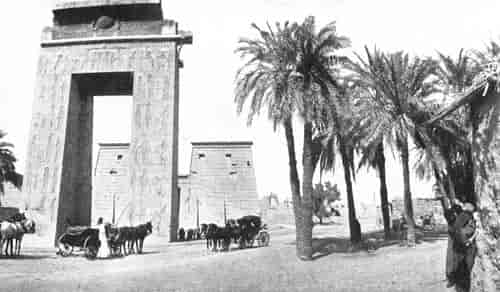 THE HUGE PROPYLON OR OUTER GATEWAY AT KARNAK.
THE HUGE PROPYLON OR OUTER GATEWAY AT KARNAK.The flies were a great pest. They were numerous and annoying, although we found that they did not bite so hard nor tickle the skin so much as do the flies in our country. Among the first purchases made by the tourists in Luxor were fly brushes made of palm fiber or of white horsehair with wooden handles and loops to attach them to the wrist. It was amusing to see English, German, and American tourists switching at the flies with their horsetail brushes while the natives passively endured the crawling insects. Egyptian mothers in the village permitted the flies to creep over the babies' faces and settle in clusters around their eyes without attempting to drive the tormentors away, either too lazy to do so or desirous that the babies should become hardened to the annoyance. We pitied the infants, however, and some of the ladies of our party became very indignant over the indifference—cruelty they called it—of the mothers. We saw many older children afterwards whose skin appeared to be insensible to the tickling feet; for they made no attempt to brush away the flies which covered their faces.
 I. WALKED ALONG THE AVENUE OF SPHINXES.
I. WALKED ALONG THE AVENUE OF SPHINXES. II. THE LITTLE MOSQUE COULD NOT BE PURCHASED.
II. THE LITTLE MOSQUE COULD NOT BE PURCHASED.Our party was joined during the morning by another party of tourists. After luncheon we all proceeded to the end of the shaded garden, where, at the gateway, we found Mahmoud, the dragoman who had been selected to take charge of the expedition. His assistants were assembled there and with them were eighty donkey boys, each with his donkey, a number of jinrikisha men with carts, and chair men with chairs. The donkey boys were of all ages from lads scarcely in their teens to veterans of three-score years. The donkeys were of[Pg 300] various sizes but the largest were not over four feet high. The jinrikishas had each two attendants, one man to pull in the shafts of the cart and one to push. The chairs borne on poles on the shoulders of men had each six carriers, four to carry and two as a relay. Chairs or jinrikishas were chosen by the tourists whose bodies required careful treatment and by those who preferred to travel in luxury. The donkeys, however, were selected by the majority, who considered it a far greater pleasure to ride.
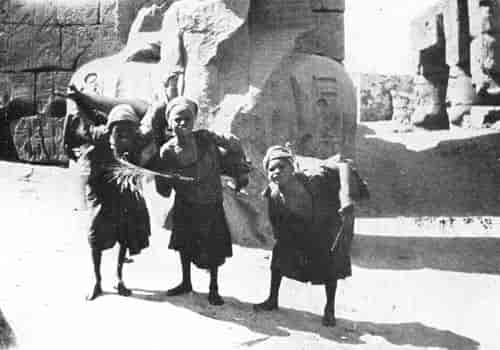 THEY BROUGHT WATER IN GOATSKINS FROM THE NILE.
THEY BROUGHT WATER IN GOATSKINS FROM THE NILE."This way! this way! ladies and gentlemen, if you please!" exclaimed Mahmoud, and the merry cavalcade of eighty tourists and one hundred attendants started[Pg 302] off through the village, donkey boys chattering, donkeys braying, and riders gaily chaffing one another on their appearance in the saddle; the long-legged professor holding up his feet to prevent them from scraping the ground and the jolly stout parson mounted on the smallest donkey. Each donkey was followed by a donkey boy who whipped the patient beast, jabbed him with a sharp pointed stick, twisted the animal's tail, or talked to him in Arabic, when it was necessary to urge him to greater speed. When urged, the donkeys were fast walkers. But whether the donkeys were walking, trotting, or galloping, the boys with little exertion managed to keep close to their heels, and the jinrikisha men and chair men could keep up such a rapid speed with their loads that it was difficult to leave them in the rear.
 BUILT OVER FORTY CENTURIES AGO.
BUILT OVER FORTY CENTURIES AGO.My donkey boy, aged about sixteen, told me that his name was Abda Mohammed and that the medium sized white donkey on which I rode was known as Alice Lovell. With broad smiles which showed a perfect set of white teeth, he repeated over and over again, at intervals during the short ride, "Alice Lovell, nice donkey, good donkey. Abda, nice boy, good donkey boy," doubtless thinking that if I could fully realize that fact the backsheesh at parting would be larger.
A half hour's ride on an embanked road across fields and desert sands brought us to the ruins of a great arch, formerly one of the gateways into the magnificent ancient temples of Karnak, but now an entrance way to the famous ruins. There, the Egyptian guards ordered us to show our government permits, or monu[Pg 304]ment tickets, as our dragoman called them, without which we could not inspect the ruins.
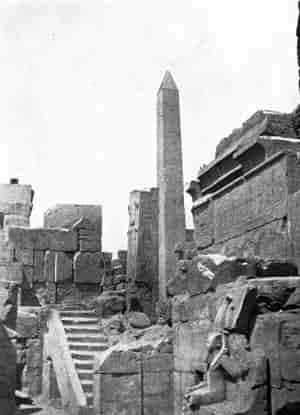 HAVE ENDURED THROUGH MANY AGES.
HAVE ENDURED THROUGH MANY AGES."Oh! I have forgotten my ticket!" said one of the tourists. "I left it with my satchel. What shall I do?"
At luncheon before starting Mahmoud had cautioned the tourists to be careful not to forget their permits, and his cautionary words, "Monument tickets are very much wanted," were familiar and often repeated. A hurried consultation was held and the difficulty overcome, but the forgetful one and others were warned that it must not occur again.
In order to provide a fund to be used in excavating, preserving, and caring for the ancient temples and tombs, the Egyptian government requires a permit costing six dollars to be taken out by each person desiring to visit these places, and without such a permit he cannot enter. At Cairo the managers of the tour had obtained from the government for each member of the Nile party a little cloth bound "Service des Antiquites L'Egypte" made out in the name of the holder. This open-sesame for the iron gates was given to each person with the warning that it must not be forgotten.
We stopped to view and kodak one of the huge Propylons or outer gate ways and found there some visitors who had driven to Karnak in modern carriages instead of using the Oriental way of conveyance that we had taken. An avenue of Sphinxes with rams' heads was also stowed away in the kodak to be brought to light at some future time.
"These stupendous ruins of Karnak," said the dragoman, "were once a group of magnificent temples cover[Pg 305]ing an area of many acres. The most ancient of the structures was built over forty centuries ago. Other temples were added and alterations and improvements made during the ages following when the city of Thebes was a prosperous capital; but for over two thousand years these places of worship have been abandoned and the sand of the desert has collected around them, almost burying them out of sight. The Egyptian government for a number of years has had many natives excavating, and also has been raising some of the fallen columns."
As we passed through the temple grounds we saw a number of men and boys at work, as the dragoman had stated. These excavators scooped the sand and debris into small baskets, while a taskmaster stood over them, whip in hand. Then placing the filled baskets on their heads they started off in long lines, singing as they marched to the deposit heap. The men, we were informed, earned twenty-five cents a day at this labor, and the boys ten to fifteen cents a day.
"One thing noticeable about these most magnificent ruins in the world," continued the guide, as we halted in the great court, "is that the architecture, the sculpture, the inscriptions, of the earlier temples is equal, if not superior, to the workmanship of a later date. The construction work done under the great kings Ramses I, Seti I, Ramses II, and Amenophis III, who ruled over Egypt thirteen centuries before the Christian era, has never been surpassed. Stones of immense size were handled by their architects in some manner unknown at the present day, and walls and columns were erected[Pg 306] of such solidity and strength that they have endured through these many ages. The First Pylon or gigantic portal to the Temple of Ammon, which was dedicated to Ammon-Re, the King of the Gods, is three hundred and seventy-two feet wide, with walls sixteen feet thick and one hundred and forty-two feet high. The wonderful Hypostyle Hall, or Hall of Columns, is three hundred and thirty-eight feet long by one hundred and seventy feet broad."
"Before we enter, let me read you what the noted Egyptologist Rawlinson says with reference to this Hall of Columns," said the professor, drawing out his note book. "He writes: 'The greatest of all Seti's work was his pillared hall at Karnak, the most splendid single chamber that has ever been built by any architect, and even in its ruins one of the grandest sights that the world contains."
The huge columns, some in place, some leaning, and others prostrate, were an impressive sight. The guide called our attention to the inscriptions that covered all the columns and to the traces of coloring that might still be seen on the protected parts. In order that we might more fully realize their size, he suggested that we measure the circumference of one with our arms. It required six of us with outstretched arms to span one of the larger columns.
As we passed through the various halls, Mahmoud interpreted and explained many of the historical inscriptions and reliefs with which the ancient Egyptian kings had covered the walls, commemorating the victories they had gained over their enemies. One wall pictured[Pg 308] the triumph of Shishak over Rehoboam, the son of Solomon. The captured cities were represented by circles each enclosing the name of the city; the captives, by rows of Hebrews bound with cords. King Shishak stood over the captives grasping a group of them by the hair and smiting them with a club, and slaves carried the golden treasures that had been stripped from the temple at Jerusalem, and the plunder taken from Rehoboam's palace.
 WITHIN THE TEMPLE OF AMMON AT KARNAK.
WITHIN THE TEMPLE OF AMMON AT KARNAK.On our return to Luxor my donkey boy Abda and I had a disagreement. I gave him, as backsheesh, a tip equal to a man's wages for a full day's work in Egypt; but he pleaded with tears in his eyes for "more backsheesh," and departed apparently in great anger.
After resting awhile in the cool halls of our hotel, we walked to the ruins of the great Temple in the village of Luxor, close by the river bank and not far from the hotel.
"In the year 1884," said Mahmoud, as we assembled around him in the ruins where the gigantic columns rose forty feet above our heads, "I was living in a house that stood just over where we are now standing and I did not know that a part of the temple was buried in the earth underneath. The government officials, after much haggling and complaining about the prices my neighbors and I demanded, bought the houses and lands of us, about thirty properties in all, and gave us other lands, so that the excavations could be continued. That year this part of the temple was uncovered. The little white mosque at the corner could not be purchased, as that ground is sacred and must not be disturbed to uncover ruins underneath it."[Pg 309]
 PLACED THE FILLED BASKETS ON THEIR HEADS.
PLACED THE FILLED BASKETS ON THEIR HEADS."This edifice, dedicated to the worship of Ammon," continued the guide, "was erected by King Amenophis III thirty-three hundred years ago; but King Ramses II, one hundred years later, added to the structure and[Pg 311] made it a memorial of his reign by embellishing the temple with statues of himself and covering the exterior walls with reliefs and inscriptions picturing and describing his triumphs."
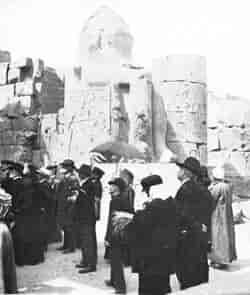 EMBELLISHED THE TEMPLE WITH STATUES OF HIMSELF.
EMBELLISHED THE TEMPLE WITH STATUES OF HIMSELF.We saw two colossal sitting statues of Ramses forty-five feet in height, one of which was completely excavated, the other buried breast high in rubbish, and in a court of the temple were many gigantic standing figures of Ramses placed between the pillars. Beside one of these was a small figure, representing the queen Nefertari, which just reached to the height of the knees of Ramses.
"The king desired to indicate by the size of the statues that he was a great conqueror," said the dragoman. "His wife was the daughter of Pharoah who, while bathing in the Nile, found the Hebrew babe hidden among the papyri plants."
"If Nefertari was the princess who rescued Moses, she deserved a larger statue," responded one of the tourists.
"This series of scenes represents the victory at Kadesh in Syria," explained the guide as we stood before a wall covered with pictorial representations of conflict cut in the stone. "Here is the King in his chariot charging with fury on his foes amid flying arrows. Notice the dead and wounded scattered over the field of battle and the Hittites flying in confusion. At one side you see the Egyptian camp, and on the other side the fortress of Kadesh and the Syrian king amazed at the sight of his army in wild flight. The hieroglyphics that cover the side of the tower give a detailed account of[Pg 312] the battle and of the glorious deeds of valor performed by King Ramses. There were originally two large obelisks here in front of the temple, but one of them was taken to Paris a number of years ago."
"Yes, I saw it there," remarked one of the party, "but the inscriptions on the one at Paris looked worn and weather-beaten; while those on this obelisk are almost as distinct as when they were cut in the pink granite three thousand years ago."
On the morning of March fifteenth, after an early breakfast, we started at seven o'clock to visit the Tombs of the Kings and the temples on the west side of the Nile,—the village of Luxor and the temples of Luxor and Karnak being on the east side. Crossing the river in ferry boats propelled by sails and oars, the tourists found donkeys, boys, chair-men, lunch carriers, guides, and extra men crowding the western shore. We had hardly landed when the donkey boys surrounded us, gesticulating, shouting the merits of themselves and their beasts, and pleading that their donkeys might be selected. Much to my surprise, Abda, the offended and angry boy of the Karnak ride, pushed his way to my side with Alice Lovell and smilingly claimed me as his friend and benefactor, with the familiar tale: "Alice Lovell a good donkey; Abda a good donkey boy," so our relations were renewed.
The ladies decided that the men's saddles would be more comfortable for a long ride, and that there would be less danger of the saddle turning; so side saddles were generally dispensed with and most of the women mounted astride. From the landing we rode slowly[Pg 314] over a long stretch of loose sand, tiresome to the donkeys, and then along a good path on the embankment of an irrigating ditch. The sun was sending down hot rays by the time we reached our first halting place, the Temple of Kurna, and we were glad to dismount and seek shelter and rest in the shade of the great walls while we examined the beautifully executed reliefs and inscriptions.
 BESIDE ONE OF THESE IS A SMALL FIGURE OF THE QUEEN.
BESIDE ONE OF THESE IS A SMALL FIGURE OF THE QUEEN.In the treasure chamber of the temple, Mahmoud related the story of the architect who built the chamber for King Seti. "This rascal of an architect," said Mahmoud, "left one stone loose so that he could secretly remove it and enter the chamber to steal. The robber was caught in the act of carrying off the treasure and fittingly punished as you may see represented in the reliefs on the walls. This man pictured here in disgrace and chains as a warning to ill-doers was the first thief in Egypt, but I am sorry to say he was not the last."
After leaving the Temple of Kurna, which is situated near the cliffs that bound the Nile valley, our procession entered a narrow ravine through which the path leads to the Tombs of the Kings. Here we met another large party of Americans and we all rode together for some distance, one of the tourists meeting a friend whom she had not seen for seven years. We passed two Englishmen with their guide, who moved off the path and gazed through their eye-glasses in mild astonishment at our animated cavalcade in varied costumes; while we in turn looked at their immaculate sporting outfits and thought how lonely the couple must be, traveling through these dismal solitudes. Our party had not thought it worth while to purchase special[Pg 316] riding outfits for the few days in the desert, but had utilized what they had. For protection from the sun some used white helmets or cloth neck protectors, some covered their heads and necks with veils or tied down their soft hats, others wore straw hats or caps regardless of sunburn.
 RESTED IN THE SHADE OF THE TEMPLE OF KURNA.
RESTED IN THE SHADE OF THE TEMPLE OF KURNA. WE ENTERED THE RAMESSEUM.
WE ENTERED THE RAMESSEUM.Overhead was an unclouded sky; at each side rose yellow limestone cliffs glaring in the noonday sun, and underneath white sand and limestone chips reflected the burning rays. Not a sign of vegetation relieved the eye in this waterless gorge during our one hour's ride from Kurna to the Tombs.
"Backsheesh! backsheesh!" demanded the donkey boys, as we dismounted.
"Why do you want backsheesh now?"
"Boy don't want backsheesh, donkey want backsheesh, donkey eat hay while man in tombs."
In order that the Tombs may be satisfactorily examined by visitors, the government has built an electric light plant in the gorge and the thirty-five tombs are illuminated by electricity. Our party entered and examined the six of these tombs which are considered the most interesting. At each of these an Egyptian guard politely scrutinized the "Services des Antiquites," although it was printed in French that he could not read, and then permitted the holder to enter.
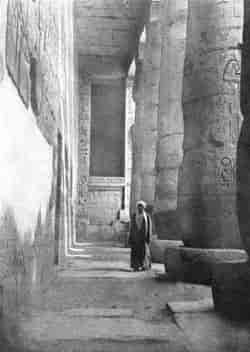 STOOD IN THE COLONNADE AT MEDINET HABU.
STOOD IN THE COLONNADE AT MEDINET HABU.In Tomb No. 17, we descended a passage hewn in the limestone cliff, about ten feet wide, ten feet in height, and three hundred and thirty feet in length, which leads inward and downward by inclines and steps to the resting-place of King Seti, a tomb prepared during his life[Pg 318] to be the receptacle for his mummified remains after death. The smooth polished walls and ceilings of the corridors and chambers were sculptured by the best artists of Seti's time with reliefs of great beauty, representing scenes of a sacred character. The praising of the great God Ammon-Re, the offering of incense and gifts to various deities, the passage of the boat of the sun, the punishments in the underworld, the sacred sun-disk, animal-headed gods, patron goddesses, fierce demons, sacred animals, winged serpents, flying spirits,[Pg 319] evil genii, coiled snakes, and creeping scarabs are portrayed repeatedly.
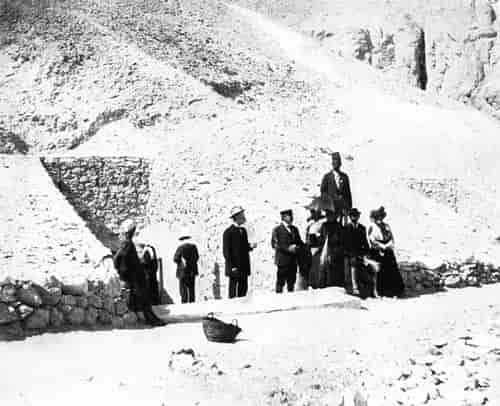 AT THE TOMBS OF THE KING.
AT THE TOMBS OF THE KING.Mahmoud explained the pictures and inscriptions as we slowly went forward, stopping frequently to inspect more closely those of greater interest.
"After Seti's death," said Mahmoud, as we stood in the chamber of the tomb, brilliantly lighted by the electric bulbs, "his body was embalmed and with great pomp and ceremony the mummy was carried from the palace in the great city of Thebes through the dismal gorge and deposited in a magnificent alabaster sarcophagus that had been prepared for its reception in this chamber in the limestone rock ninety feet below the surface of the ground. Then the tomb was closed and sealed so that the body of the king might remain in peace until it should be called forth at the end of time to undergo trial before the god Osiris.
"For hundreds of years, the mummy lay tranquilly in its sealed tomb; then the seals were rudely broken and the tomb was despoiled by robbers who wished to obtain the valuables deposited with the body. When this despoliation was discovered, the rulers of the Empire removed Seti's mummy and the mummies of other kings to a tomb near the Temple of Der-el-bahri which could be more closely guarded. There the mummies remained until the year 1881, when they were taken away to the Museum at Cairo."
"And now," said one of the visitors, as the guide concluded, "after thirty centuries of repose, the proud features of this oppressor of the Israelites, little the worse for the lapse of time, are exposed in the great[Pg 320] hall of the National Museum in Cairo to the gaze of the rude multitude from whom he desired to be hidden, and his alabaster sarcophagus is admired by visitors in the Soane Museum of London."
Almost all the articles of value in the Tombs that the robbers did not succeed in carrying away, as well as the mummies and sarcophagi, have been removed to museums in the large cities, the most valuable being retained for the Museum in Cairo. In the tomb of Amenophis II, however, the mummy of the king in a decorated coffin remains for the inspection of visitors. Above the head of this ruler of the ancient empire, a modern electric bulb hangs, illuminating the rugged features and showing every detail of high nose, sunken cheeks, and straggling hair on the head and chin. The tombs of Ramses III, Ramses IV, and Ramses IX were interesting each in its own way. That of Ramses III had, in addition to the sacred scenes, pictures of agricultural and family life; plowing, sowing, reaping, baking, slaughtering, and cooking.
"Shall we return through the gorge or take the shorter path over the cliffs and obtain a view of the Nile valley?" inquired the dragoman.
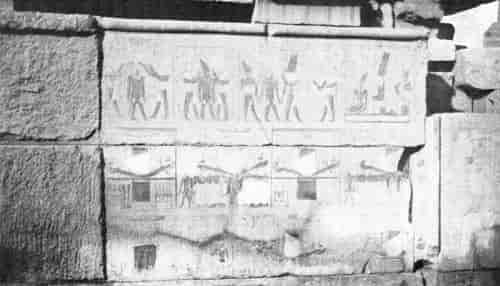 USED CHISELS ON LASTING STONE INSTEAD OF BRUSHES ON PERISHABLE CANVAS.
USED CHISELS ON LASTING STONE INSTEAD OF BRUSHES ON PERISHABLE CANVAS.Some, dreading the exertion under a broiling sun, chose the level road on a donkey's back. Others, intent on obtaining the view, started to climb the zigzag path regardless of the glare of the sun, the donkey boys following with the donkeys. The view from the summit amply repaid us for the climb. On one side we looked down into the desolate valley of the Tombs. On the other we saw the rich green valley of the Nile, with groups[Pg 322] of palms, villages, and temples. Directly below at the foot of the yellow cliff, and in strong contrast to it, was the white marble temple of Der-al-bahri. And not far from the temple was a cottage, which at once became interesting to the tired party when the guide, pointing to it, said: "That is the rest-house. A good luncheon will be ready on the tables when you arrive there."
 POSED TO BE KODAKED.
POSED TO BE KODAKED.We had been riding on a very narrow trail along the edge of a precipice, but now we dismounted and descended, on foot, a winding path, too steep and dangerous for riding, that led us to the rest-house in the valley below. Here, at the Chalet Hatasu, as it was named, the servants had unpacked the hampers which they had brought from the hotel at Luxor, and the hungry travelers were soon seated around well-spread tables. During the meal a throng of scantily clad men, boys, and small children assembled outside the Chalet. These bare-footed Arabs offered for sale scarabs, stone mummy images, mummified feet, skulls, beads, and trinkets so clamorously and persistently that our dragoman had to[Pg 324] use his long lashed whip to clear the way. After leaving the chalet, naked boys, apparently from four to ten years of age, followed us with outstretched hands, begging for backsheesh. Some of these boys earned money by posing to be kodaked.
 I. COLOSSUS OF RAMSES LAY BROKEN.
I. COLOSSUS OF RAMSES LAY BROKEN. II. MOSLEMS HAD MUTILATED THE STATUES.
II. MOSLEMS HAD MUTILATED THE STATUES.The walls and columns of the Ramesseum, the magnificent temple built by Ramses II, and those of Medinet Habu, the great temple built by Ramses III, were covered with pictures in relief, made in the golden days of Theban prosperity.
 TWO WEATHER-WORN FIGURES OF PRODIGIOUS SIZE [Pg 325]
TWO WEATHER-WORN FIGURES OF PRODIGIOUS SIZE [Pg 325]"The ancient artists, to perpetuate their work, used chisels on lasting stone instead of brushes on perishable canvas," remarked the professor as we examined the reliefs, "and their pictures carved on the stone walls have endured through centuries."
We saw battle scenes with the king leading in the fray, archers discharging arrows, charioteers riding down the foe, and enemies fleeing in dismay; triumphal marches with the king borne aloft on a canopied litter, fan-bearers waving fans, musicians blowing trumpets and beating drums, courtiers bearing standards, and captives led in chains; festal processions with the king marching in front, the sacred white bull festooned with wreaths, maidens carrying flowers, and priests bearing images; and nations paying tribute to the king upon his throne, Nubians bringing leopard skins, giraffes, and grinning apes, and princes presenting gems, costly vases, and golden shields. One picture at Medinet Habu represented the soldiers cutting off the right hands of their enemies who had been slain in battle and bringing these gruesome emblems of the dead to the secretaries to be counted and recorded. The secretaries had counted and recorded twelve thousand five hundred and thirty-five hands. To enumerate the many interesting scenes sculptured on the temple walls would be like cataloguing a picture gallery.
At the Ramesseum, the enormous Colossus of Ramses lay broken on the ground, overthrown by some mighty force.
"This huge granite figure," said Mahmoud, "was, before its fall, the largest statue ever carved out of one[Pg 326] block of stone. Its height was nearly sixty feet, the fingers three feet long, and its weight has been estimated at one thousand tons."
The Colossi of Memnon, the two enormous seated figures in the midst of level cultivated fields, were passed and photographed as we returned to Luxor. Their hugeness may be judged by comparing their size with the height of the tourists alongside in the illustration.
"During the weeks of inundation each year," said Mahmoud, after he had told us the dimensions of the statues and the mythical stories associated with them, "these grain fields as far as the vegetation extends are covered with water to a depth of from ten to fifteen feet. When the Nile is at its height the heads of the great Colossi, surrounded by water, rise forty feet above the flood."
A bath and a thorough brushing of clothes at the hotel removed the desert sand. We sipped our afternoon tea in the shaded garden and then the party of forty-two persons boarded the Nile steamer Amasis in time for an evening dinner on the boat. Suit cases and satchels were unpacked and the staterooms made cozy, for the Amasis was to be the tourists' home for a number of days during the trip down the Nile.[Pg 327]
CHAPTER XV.
ON THE NILE.
At daylight on Monday morning, March sixteenth, the Amasis steamed away from Luxor and by nine o'clock had arrived at the landing for Dendera. The donkey boys of Dendera, having been notified of our coming, were waiting with their donkeys. In a few minutes the tourists were mounted for a half hour's ride on narrow paths through green barley fields to the ruined temple. I rode on a donkey named Whiskey and Soda, with my donkey boy Hassan running behind prodding the animal occasionally with a sharp-pointed stick, and yelling "Haow! Haow!" to urge Whiskey and Soda to a more rapid gait. Along the paths through the fields many children ran to greet us with outstretched palms. Their costumes were those of the Garden of Eden before the fall; but having been informed of our approach, the bronze colored youngsters had decorated themselves for the occasion with wreaths of green barley around their waists and crowns of the same material on their heads. The little Arabs, bright-eyed, smooth-limbed, and handsome featured, attractive and picturesque in appearance, shouted with glee when a few small coins were thrown among them.
"Look at that!" exclaimed one of the party. "I have heard of the shepherds carrying the lambs on their[Pg 328] shoulders, but here is a man coming with the foal of a donkey in his arms."
"What a dear little pet," said the ladies as the Arab passed us with the young donkey nestling contentedly on his breast.
"The famous Temple of Dendera was not so magnificent nor so large as the temples of Karnak and Thebes," said the guide, as we stood before the gates, "but it was more richly decorated with carvings and paintings. Every inch of column, wall, and ceiling was carved with hieroglyphic and pictorial decorations. These were painted in bright colors which are yet faintly visible. This structure is a modern one compared with Karnak; for Karnak was an ancient temple more than one thousand years old when King Ptolemy began the erection of this building just before the Christian Era. An inscription on the walls states that the time required for its construction was one hundred and eight years, six months, and fourteen days. When Egypt became a Roman province after the death of Cleopatra, the Roman emperors continued the construction of the unfinished temple. Augustus, Tiberius, Caligula, Claudius, and Nero are represented in reliefs on the walls. The temple was dedicated to the worship of the Goddess Hathor, the Egyptian Venus, or goddess of love and beauty."
"Why was the temple built here two miles away from the river, instead of near the banks of the Nile?" inquired a tourist.
"It was because this terrace is higher than the valley," answered Mahmoud. "Remember that these green fields through which we rode are made fertile by the[Pg 330] overflow of the Nile; then I think that the reason for building on this plateau will be plain to you."
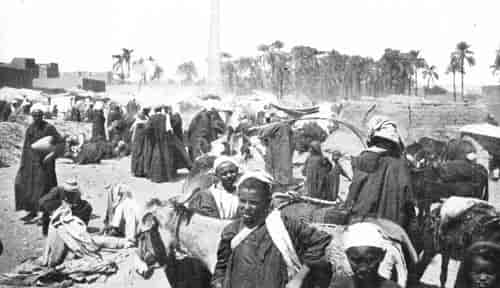 DONKEY BOYS WERE WAITING FOR US.
DONKEY BOYS WERE WAITING FOR US."But why was it built in a depression?"
"It was not originally in a hole," explained the guide, "but was built on level ground. Some sixteen hundred years ago the Christian Roman Emperor Theodosius forbade the worship of idols. After that time, the worship of the goddess Hathor being discontinued, the temple was neglected and a village of mud huts sprang up around it. These huts, built of sun-dried bricks, crumbled to dust in the passage of years and were trampled under foot. Again and again new huts supplanted the old until in the course of centuries the debris accumulated many feet in depth. When the government, fifty years ago, undertook to restore the temple, the workmen had to begin by shoveling mud huts off the roof."
We descended a long flight of steps to reach the level of the floor of the excavated temple, and passing the blue-uniformed guards entered the grand hall of columns. The hall, as the guide had told us, was richly decorated. Master sculptors had carved every available space on the walls and columns with hieroglyphic inscriptions and beautiful reliefs; master artists in color had heightened the effect with tint and shade. Looking up we saw, pictured on the ceiling, the Egyptian deity, Nut, the goddess of the sky, controlling the movements of sun and stars; the rays of the sun shining in blessing on the head of Hathor; the moon issuing from Nut's mouth; the signs of the Zodiac; the flying Hours of day and night; and the sailing boats of the planets.[Pg 331]
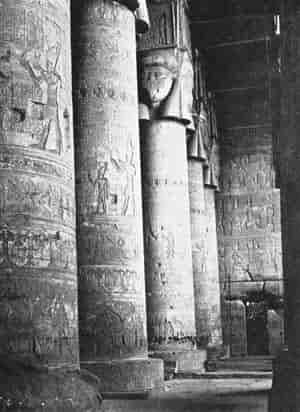 RICHLY DECORATED WITH CARVINGS AND PAINTINGS.
RICHLY DECORATED WITH CARVINGS AND PAINTINGS. OFFERED INCENSE TO THE GODS.
OFFERED INCENSE TO THE GODS.The guide raised a stone trap door less than two feet square in the stone floor and through this small entrance we squeezed, candle in hand, and descended a stone stairway to explore the dark crypt underneath. Although the ladies screamed when the bats, disturbed and blinded by the light, flew wildly overhead, they bravely followed the guide. The long passage was but three feet in width and we wondered why the dragoman had brought us down into its close and gloomy recesses; but when magnesium wires were lit, our wonder turned into admiration, for the sputtering white light revealed on the smooth sidewalls most beautiful reliefs in well preserved coloring.
"Did you see anything remarkable in that dark cellar?" inquired a voice from above as we ascended through the trap.[Pg 333]
"Why didn't you come along?" was the laughing response.
"I've not trained down to the proper size yet," rejoined the fat man who could be jolly on all occasions. "Do you think that a man of my size could squeeze through a hole like that?"
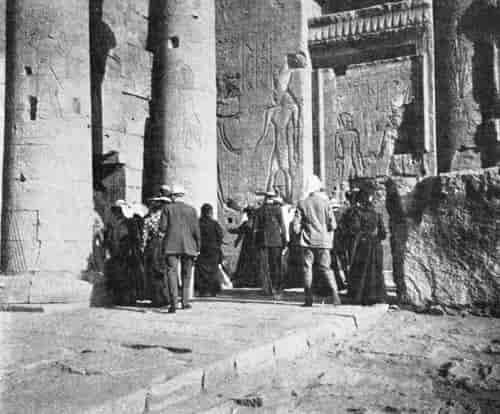 ENTERED THE GRAND HALL OF COLUMNS.
ENTERED THE GRAND HALL OF COLUMNS.By a long stone stairway of easy steps we ascended leisurely to the roof, stopping frequently to admire the ceremonial procession of priests pictured on the walls of the staircase. From the flat stone roof we saw on[Pg 334] one side the green cultivated fields extending to the river's edge and on the other side the yellow desert stretching to the distant cliffs.
"This is a picture of Cleopatra and her son Cæsarion," said Mahmoud, as we inspected the reliefs on the outer walls, "and this is King Ptolemy offering incense to the gods Osiris and Isis, and hawk-headed Horus their son. Here also is Hathor's picture repeated many times."
The trip down the river Nile on the fine steamer Amasis, which had been chartered for us, was thoroughly enjoyed by the forty-two people who made up the party. The staterooms were bright and clean and the meals served were equal to those of a first class hotel. The captain and his officials did all they could to make the trip pleasant for us. Life on board was a life of ease; the air though warm was balmy and restful, and cares were forgotten. The centre of the upper deck was roofed over but open at the sides with rugs on the floor, easy chairs, small tables, and a piano. In this open piazza-parlor we sipped the coffee that was served to us there after luncheon and after dinner. There, too, we partook of the tea and cakes that were handed around at four o'clock, and when we returned from excursions on shore, tired and warm, we found refreshing lemonade ready to quench our thirst.
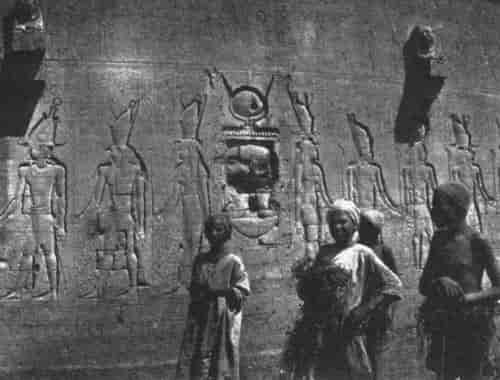 RELIEFS ON THE OUTER WALL.
RELIEFS ON THE OUTER WALL.Our dragoman, Mahmoud Achmed, the Egyptian conductor of all our sight-seeing excursions on land, was an interesting character and became a great favorite. He was a native of Luxor and while we were at that place his bright-eyed little girl, neatly dressed, came to meet us. Mahmoud had a fund of information regard[Pg 335]ing the history of the country, the legends of the gods, and the fabulous deeds of the ancient kings. He had a most interesting way of interspersing history with mythical tales and humorous incidents, and so kept the party in high spirits. Mahmoud was noted, too, for his ability to answer intelligently all reasonable inquiries and for his great patience in replying to many questions, that must have appeared to him very silly. Each day on the boat while we were all seated at dinner, Mahmoud came into the dining saloon and announced the program for the following days, always beginning: "Ladies and gentlemen, if you please," and closing with, "Monu[Pg 336]ment tickets are very much wanted. Galloping donkeys is not allowed."
For some one to mislay or forget a permit was a daily occurrence and the caution had to be repeated often. As to the donkeys, the riders paid no attention to the restriction, but walked, trotted, or galloped the donkeys as they felt inclined.
During the daytime Mahmoud wore a plain gown suitable for traveling on shore in heat and dust, but in the evenings he was resplendent in robes of silk. One night, at the request of one of the ladies, he brought to the mid-deck five handsome silk gowns to be inspected by the tourists. He also brought his book of references written by people whom he had conducted. In this we read the dignified prose of preacher and college president, the practical remarks of business men, and the nonsensical lines of the rhymster. One of his feminine admirers, seemingly impressed by the dragoman's silk robes, polite attention, and general good humor, had left the following jingle on the record:
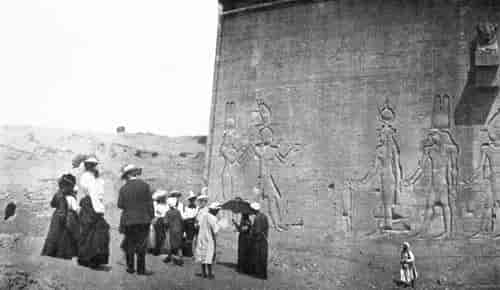 THIS IS A PICTURE OF CLEOPATRA AND HER SON.
THIS IS A PICTURE OF CLEOPATRA AND HER SON.Mahmoud took great pride in showing his many references in prose and rhyme, and the members of our party were glad to contribute in prose to his collection. But at the end of the week we presented him with another testimonial of a more practical kind.
"The Nile is a most wonderful river," remarked the professor one evening as we sat on the open deck watching the moonlight glisten on the green water. "Several other rivers rival it in length; the Congo is noted for its size; the Amazon, swelled by great tributaries, discharges a volume of water immensely greater; and the Missouri, including the Mississippi to the Gulf, may be longer; but the Nile is unique in that for twelve hundred miles it flows without a tributary through a rainless region. Not a drop of rain nor a single brook adds to its volume in all that distance, and a hot sun, canals, ditches, sakiyehs, shadoofs, and water carriers are continually taking away from it throughout every mile of its winding course. The river is wider here but it has less volume than one thousand miles farther up the stream. It is unique also in the regularity of the annual inundations, which begin on almost the same day, continue the same length of time, and rise to an almost similar height each year, and have done so annually for untold centuries. In our land a flood is a disaster causing loss and sorrow; in this country it is a blessing producing wealth and joy. When the slowly rising waters[Pg 339] each year reach the figures on the stone column of the Nilometer which show that the Nile has spread abroad his fertile bounty by covering the cultivable lands, and has filled the dams and ditches for future needs, the news is spread abroad and the people rejoice with festivities and processions."
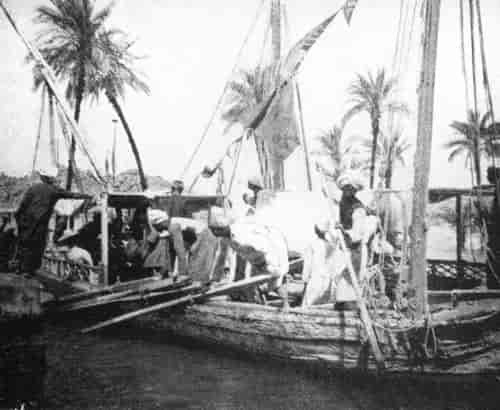 'TWAS SCENES LIKE THESE WE LOOKED UPON.
'TWAS SCENES LIKE THESE WE LOOKED UPON.Before taking the trip on the Nile we had thought that the days on the river might become monotonous and tiresome; but we found, on the contrary, that every hour was full of interest. Each day some excursion on shore was taken. One day the patient donkeys carried[Pg 340] the tourists on a long trip to the ruins of the great temple of Seti at Abydos to view its sculptured columns and famous list of kings. On another day carriages conveyed us to the rock tombs on the limestone hills above Assiout and we visited the bazaars and the noted potteries of that busy town. On the last day of our sail the donkeys of Bedrashen were called into service for a ride through the palm forest and green fields, past the fallen columns of Ramses, to Sakkara, the tombs of the sacred bulls, and the pictured tombs of Ptahhotep and Ti.
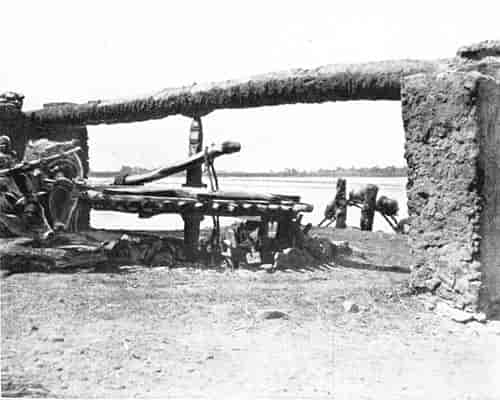 TROD ROUND AND ROUND THE WHEEL.
TROD ROUND AND ROUND THE WHEEL.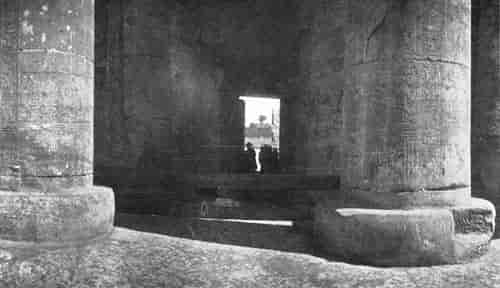 THE COLUMNS AT ABYDOS ARE OF GREAT SIZE.
THE COLUMNS AT ABYDOS ARE OF GREAT SIZE."This is the height of enjoyment," said a member of our party one day while we were lounging in easy chairs taking afternoon tea on the deck, and lazily watching the panoramic scenes as the Amasis steamed down the river.
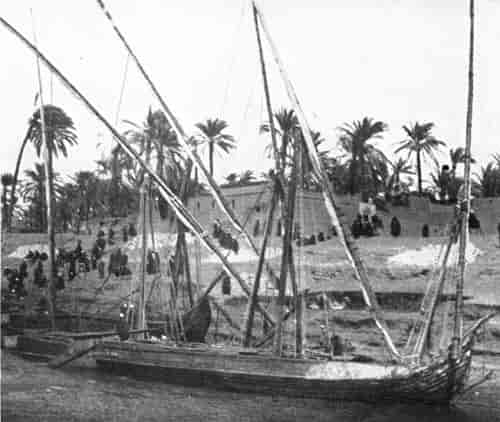 DOTTED WITH PILES OF YELLOW WATER-JARS.
DOTTED WITH PILES OF YELLOW WATER-JARS.It was scenes like these we looked upon. Along the banks of the river at short intervals, the shadoof man, or drawer of water, with his shadoof resembling an old-fashioned spring-pole or well sweep, drew up his[Pg 343] dripping bucket and lowered it again, his only garment an apron at the waist.
Where the bank was very high, a series of two, three, or four natives, each with his spring-pole, raised the water one to the other until it reached the top and was poured into the little channels that carried it over the rich, but very thirsty soil of a rainless land. On the river-bank, also, interspersed with the shadoofs of the poorer class of agriculturists, the more prosperous farmers, who were the happy possessors of buffaloes or camels, lifted the irrigating water from the stream by means of sakiyehs, or wooden power wheels, which creaked unceasingly as the patient camels or buffaloes, with eyes covered by blinders of mud, trod round and round the wheel.
A large Dahabeah with rugs, easy chairs, and piano on deck, and the stars and stripes hanging listlessly overhead, floated by, propelled by fourteen Arab rowers—there being no wind to fill the sails. A drove of gray[Pg 344] buffaloes, forty in number, were taking their bath, splashing the water like a party of schoolboys in a swimming pool. A group of women filled earthen jars at the water's edge, and with the dripping jars on their heads mounted the steep river bank. Here and there were irregular groups of mud huts, intersected by crooked alleys and surrounded by date palms, little villages where doves were flying overhead and from which came the sound of barking dogs to mingle with the puffs of the steamer. Flat-bottomed boats freighted with sugar cane lay with drooping sails in a noonday calm, or, later in the day, sped before the evening breeze. Near the pottery towns the river banks were dotted with yellow water jars in scattered piles ready for shipment to the city market. Immense stacks of the sugar-cane just harvested had been brought to the shore for conveyance to the sugar factories. And fields of cotton covered with white bloom extended into the distance.
We could see, too, the fertile Nile valley, not more than ten miles in breadth at its widest part, bounded on both sides by ranges of yellow, barren cliffs. On the western side the cliffs were farthest away; on the eastern side the valley was narrow, and the cliffs were sometimes distant, sometimes so near that they completely crowded out the cultivable soil and approached to the water's edge.
"There is something peculiar in the air of this dry land," observed one of the tourists after sitting quiet awhile. "The atmosphere lends a softness to the outlines of distant objects and adds delicate tints in the afternoon light. See how the barren cliffs are glorified[Pg 346] with a flush of pink, the wheat fields are a brilliant green, and the barley fields, almost ready for the harvest, are golden. Even the mud huts and the white-washed mosque of that village on the western shore have lost their crude outlines and have become picturesque. At sunset the western sky will change to crimson and the eastern cliffs will change to gold. The sunsets, though, are not so gorgeous in coloring, nor do they show such striking contrasts as I have seen occasionally in my western home, but they are beautiful."
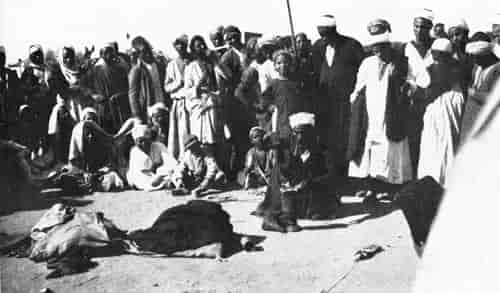 ALL EYES WERE FIXED ON THE MAGICIAN'S MOVEMENTSALL EYES WERE FIXED ON THE MAGICIAN'S MOVEMENTS.
ALL EYES WERE FIXED ON THE MAGICIAN'S MOVEMENTSALL EYES WERE FIXED ON THE MAGICIAN'S MOVEMENTS.During the latter part of our sail down the Nile, where the river broadened and was shallow, we had some interesting experiences with sandbars.
"This is the Amasis' last trip of the season," said one of the officers as we stood on the upper deck at the bow of the steamer watching two sailors poling below. "The Nile always falls rapidly in the spring, the channels change, new sandbars form, and navigation becomes difficult. The water is now very low, and we have to be careful and alert wherever the river broadens as it does here before us."
On account of the indications of shallowness ahead the Amasis was steaming very slowly, occasionally merely drifting with the current. The two Arab boatmen stationed in the bow continually tested the depth of the water with poles and shouted in Arabic the results of their measurements to the anxious commander on the deck above. Notwithstanding these precautions, our steamer occasionally scraped on the sandbars, sometimes sticking on them for a short time.
"Surely this is an unlucky day," exclaimed the[Pg 347] captain later, looking at his watch as we came within sight of a railroad bridge with a draw in it that was then being closed for an approaching train. "It is now four o'clock, and, according to the official rules, that drawbridge is closed for the day and will not be opened for steamers to pass through until nine o'clock to-morrow morning. We shall have to anchor here until that time. That last stop of half an hour on the sandbar robs us of half a day's time."
 SHOVING FROM ITS DECK WITH LONG POLES.
SHOVING FROM ITS DECK WITH LONG POLES.The delay at the bridge was provoking, but a greater test of the temper of the officers and patience of the[Pg 348] passengers was to come. On Friday morning while at breakfast we felt a jar that caused the vessel suddenly to stop. We heard an unusual puffing of the engine and felt vibrations that caused the steamer to tremble and the dishes to rattle.
"What's the matter? What's the trouble?" cried several.
"Struck another sandbar," laconically remarked the doctor at the end of the table. "Eat your breakfast. We'll be off in a few minutes."
But succeeding events proved that the doctor was a false prophet. For during the next twenty hours the Amasis lay helpless in the midst of the stream, notwithstanding all the attempts of the officials and crew to free her from the bar, and it was not until Saturday morning that their efforts were crowned with success and the steamer floated free.
However, we took the doctor's advice the first morning and finished our omelet and coffee. Then we hurried to the deck to investigate and ask numberless questions of the worried officials. Our baggage had been packed in anticipation of landing before noon at Cairo, which was but sixty miles distant, and we feared that a delay might interfere with our plans for a busy afternoon of sight-seeing in the city.
"'Misery loves company,' says an old proverb. If that is true we should be happy," remarked one of the tourists as we gathered on the deck gazing at an animated scene. "Look! There are thirty boats in the same predicament as our own."
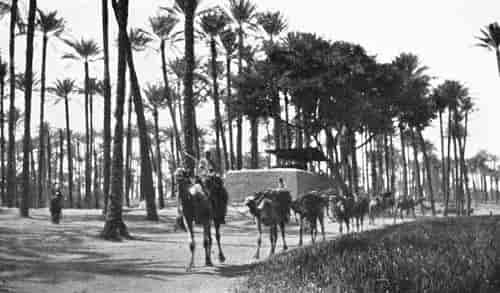 PALMS GROW ON THE SITE OF ANCIENT MEMPHIS.
PALMS GROW ON THE SITE OF ANCIENT MEMPHIS.Within sight in different directions on the wide river[Pg 350] lay thirty loaded feluccas stranded on the bars, and in addition to these were sixty-five others not aground. Alongside of one laden with live cattle a dozen sailors were in the shallow water, shouting and splashing, endeavoring to push their sloop off the bar. On many of the stranded sloops the sailors were transferring parts of their cargoes to other boats which were not aground. At some places the dark-hued laborers were shoveling grain from a stranded felucca into a lighter one; at others they were carrying unwieldy bundles of sugar-cane from one deck to another. Here they were handling, with much difficulty, large blocks of stone; there throwing yellow water-jars one at a time, passing red-bricks slowly, or shifting stacks of green clover from deck to deck. They accompanied the work of disburdening the vessels with strange cries and chants in which the name of Allah noticeably recurred, occasionally stopping to test the result of their labor by plunging into the water and pushing the felucca, or by shoving from its deck with long poles.
One of the officers of the Amasis with some sailors in a row-boat carried an anchor to its cable's length from the steamer and dropped it in the water, then a donkey-engine on deck to which the cable was attached was started and the steamer shook with the throbs of the engine endeavoring to pull it off the bar toward the anchor. Unsuccessful in tugging the steamer in that direction, they raised the anchor into the row-boat and took it to other locations one after another; but the engine panted and throbbed in vain. In the meantime the captain had gone to a village on the shore, had hired[Pg 352] sixty natives, and brought them out in boats. The Arabs, dropping off their long blue gowns, and arrayed only in loin cloths, jumped into the water, which was not over three feet in depth. Then, placing their shoulders against the steamer, the gang of naked Arabs, chanting in unison a prayer to Allah for help and protection, pushed, or pretended to push, in order to assist the puffing engine in its task. With intermissions for rest, the pushing, the throbbing, and the chanting of the Arabic song, "Allah il Allah, Allah il Allah," continued during the remainder of the day.
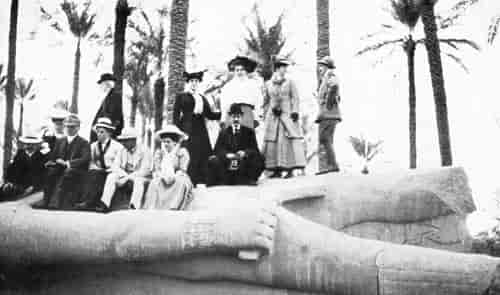 THE PROSTRATE BROKEN STATUE OF RAMSES II IS ENORMOUS.
THE PROSTRATE BROKEN STATUE OF RAMSES II IS ENORMOUS.There was so much of interest happening around them that the passengers could scarcely take time to eat their meals, and their disappointment in not reaching Cairo was almost forgotten.
"This has been to me one of the most interesting days of the trip. I will mark it with a red letter," said one of our party in the evening. "I do not regret the delay. I would not have missed those amusing and novel sights for anything."
When efforts were resumed at dawn on Saturday, the Amasis floated free, and before noon we arrived at Cairo. Our joyous trip on the Nile, with its pleasant associations of fellow voyagers, dragomen, donkey boys, temples, tombs, and gallops over the sand, was at an end.[Pg 353]
CHAPTER XVI.
NAPLES AND POMPEII.
By noon on Sunday, March twenty-second, the various parties had reassembled as one large family on board the Moltke in the harbor of Alexandria, and shortly afterward they saw the land of the palms disappear from sight below the horizon. Friends and acquaintances who had chosen different excursions on land and had been separated for some time had many experiences to relate to one another. Some, who had taken the Damascus trip, gave a description of the magnificent ruins of the famous temple of Baalbek and of the enormous size of the granite blocks which lay scattered over the ground at that place, and displayed bargains in hammered brass and silken rugs which they had secured in the bazaars of the oldest city in the world. Others, who had taken a sail on blue Galilee and a journey on horseback through the interior of Palestine, told of the unexpected luxuries of camp life, of squalid villages and more squalid inhabitants, of bridgeless streams that had to be forded, of Arab camps and Bedouin chiefs, and of towns, mountains, plains, and wells, the names of which were familiar to the student of the Bible. They showed to their friends albums in which they had pressed the flowers gathered in villages where the Savior once strayed, or culled in fields through which He probably had trod. Some who had taken a carriage ride to the[Pg 354] Dead Sea and the River Jordan described the loneliness of the road and the armed Bedouin protectors who accompanied them, the dilapidated condition of Jericho, the desolate shores and bitter salty taste of the Sea, the muddy banks of the River Jordan and a row on the rapid stream. Their souvenirs were vials filled with salt water from the Sea, and bottles of the fresh, but not very clear water from Jordan's stream.
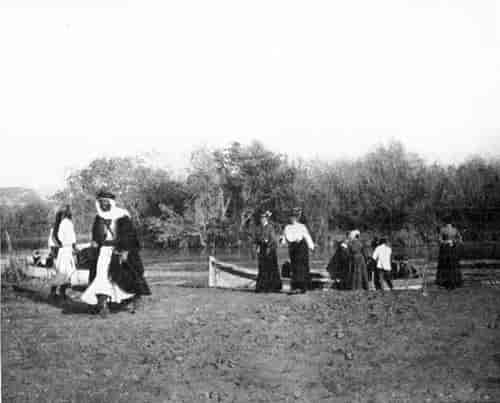 ON THE BANK OF THE RIVER JORDAN.
ON THE BANK OF THE RIVER JORDAN."The only place where we were treated with disrespect during our trip was in Hebron," said one of a group around a table in the library. "There the natives[Pg 355] were an ill-tempered set. They scowled as if resentful of our presence, and when we were driving away some hoodlums of the town threw chunks of mud and stone after our carriage."
"That reminds me," said another, "of a picture I want to show you. On the landing at Esneh up the Nile we thought that our clothes would be torn to pieces by the natives, but not through ill-will. The donkey boys were so eager to secure our custom that a struggle ensued in which donkey boys, donkeys, and tourists were inextricably mixed until the dragoman used his whip. My brother took a snap-shot of the scene just as Achmet raised his whip."
Some of the tourists had stayed ten days in Jerusalem, some twelve days in Cairo, others had been at Philæ and the Cataract of the Nile. Each one was enthusiastic over his trip and appeared to be satisfied with the way in which the eighteen days in Palestine and Egypt had been spent.
Monday dawned cloudy with some wind and rain, and although the weather was not stormy, the boat had that uneasy motion which had been felt once before on the Mediterranean. Many of the tourists, believing prevention better than cure, remained in their staterooms, or, snugly wrapped, reclined in their steamer chairs on deck and had luncheon served to them there, fewer than half the seats at the dining table being occupied.
On Tuesday, however, the sea was as smooth as a river. The "Captain's Dinner," which had been postponed from the previous day on account of the weather, was announced for the evening, and the dining room[Pg 356] was handsomely decorated with flags, garlands of artificial roses, and additional lights for the special occasion. The depression of Monday was forgotten and the tourists were in a happy humor.
 FILLED VIALS WITH WATER FROM THE DEAD SEA.
FILLED VIALS WITH WATER FROM THE DEAD SEA.At the dinner the Captain made a neat speech referring to the pleasant relations during the voyage and the separation which was shortly to take place. The judge, in behalf of the passengers, responded in a jovial vein. "Three cheers for the Captain" were given with enthusiasm, followed by "He's a jolly good fellow," heartily sung. Every one arose as the orchestra played[Pg 357] "America," and later, when the stars and stripes were dropped from overhead, all rose again to accompany the orchestra in the "Star Spangled Banner." Then the electric lights were turned out and while we sat in darkness, the stewards and waiters, dressed in fantastic costumes of various nations, entered and in a long procession marched around the room, each waiter carrying aloft an illuminated tower of ice-cream, and each steward a dish of bonbons. When the bonbons, containing whistles and fancy caps, were opened, the dignity of judge, professor, and minister was laid aside and the tourists were a joyous, noisy crowd of children.
While we were at dinner the promenade deck was cleared of chairs, decorated with flags, and illuminated with Chinese lanterns in preparation for a masked ball which was to be the crowning and closing event of the day. In this fancy-dress carnival many of the passengers appeared dressed in fantastic gowns prepared during the day, or as Orientals in costumes that had been purchased in Eastern cities.
While the maskers and onlookers were enjoying the music and sport, the Moltke was steaming northward through the Strait of Messina. On the right shone the lighthouses of Italy and the lights of the Italian town of Reggio; on the left gleamed the flash-lights of Sicily and long rows of twinkles revealed the location of the large city of Messina.
On rising Wednesday morning we found the sea perfectly smooth with scarcely a ripple to disturb its blue surface. The Moltke was speeding through the waters with an almost imperceptible motion. On our[Pg 358] left was the island of Capri, famous for its blue grotto, and the morning sunlight playing on its rugged shores, revealed a white road cut in the rocky cliffs, zigzagging up the side of the hill from the village at the base to the village on the summit. As the steamer coasted the Italian shore, we saw dimly through the mist the bay and town of Salerno, then picturesque Sorrento perched among the rocks, and, in the distance, fog-crowned Mount Vesuvius with a thin column of smoke ascending from the crater, and many towns and villages at its base. Directly ahead of us were the bay of Naples and the city, partially hidden from our sight by a fog. Just before reaching the quarantine station a small steamer crowded with passengers emerged from the fog and crossed the course of the Moltke, narrowly escaping destruction.
The Moltke dropped anchor at quarantine and a yellow flag was run to the top of the mast to remain floating there until the Italian physician had completed his examination and was convinced that there were not, and had not been, any cases of plague, cholera, or contagious disease on the ship. During the detention at quarantine a large mail was brought on board. We crowded eagerly into the office inquiring for letters. The stewards, not taking time to distribute the mail in the boxes, called out the addresses, and little thought was given to anything else until letters and papers were obtained and the news from home devoured.
The fog soon rolled away and Naples, beautifully situated on the crescent-shaped shores of the bay, was disclosed to view. From the deck of the steamer we saw a[Pg 359] [Pg 360]picture unsurpassed in color and composition by any previously beheld, excepting, perhaps, the view of Constantinople from the Bosporus, or the panorama of Algiers seen from the sea; but each one of the three pictures was unique and beyond comparison. But here, as at Constantinople, distance lent an enchantment to the view; for a closer inspection after landing revealed on the white and yellow and pink buildings ravages of time and unsightly stains of smoke and grime unnoticed from the bay.
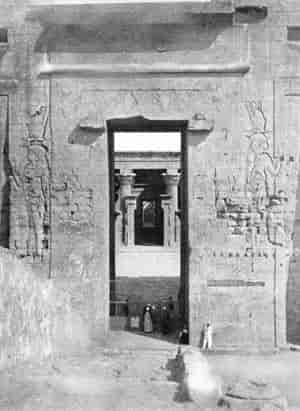 THE GREAT DOORWAY OF THE TEMPLE OF HORUS AT EDFU.
THE GREAT DOORWAY OF THE TEMPLE OF HORUS AT EDFU.We had no sooner reached the street, ready for sight-seeing, than the cabriolet drivers thronged about, importuning us to ride in the low open carriages that comfortably carry two persons.
"How much to the Cathedral?" we asked one of the drivers, using an expression that we thought the Italian might comprehend.
"One lira the course, one and a half lire the hour," he succeeded in getting us to understand.
"Only ten cents each. And it's fully two miles to the Cathedral!" exclaimed my companion. "But we have a number of places to visit," he added, "and it will be better to engage the cab by the hour. Show him your watch and make a note of the time."
At the entrance of the Cathedral, the beggars asking alms reminded us of the description of similar scenes at the gate of the Temple in the Savior's time. A blind man standing by the door called loudly upon the passers-by to have pity on him, a cripple seated on the steps with rough crooked crutches by his side stretched out his hand for aid, and a fat dirty woman with a tiny[Pg 362] babe in her arms whiningly cried, "poveretta mia! poveretta mia!"
 I. THE ISLAND OF CAPRI.
I. THE ISLAND OF CAPRI. II. VILLAGE AT ITS BASE AND VILLAGE ON ITS SUMMIT.
II. VILLAGE AT ITS BASE AND VILLAGE ON ITS SUMMIT.The regular services in the Cathedral were over when we entered, but many people were in the building. Some were in silent adoration before the Cross at the magnificent high altar; some were worshiping at the foot of the Virgin, or praying at the shrines of the saints; others were contritely kneeling at the confessional boxes with faces close to the little grated windows, whispering deeds of misdoing to the confessor within and awaiting the father's words of penance or of absolution. We followed a crowd of Italians who were going into a chapel at the side where preparations were being made for a special service. There being no pews or sittings in the chapel, but a few plain chairs for hire, we paid the verger two cents for the use of a chair and waited. Wooden benches were placed in line to form an aisle and a number of women and children knelt at the benches, each holding a large unlighted candle.
A cardinal in a red robe came down the aisle, accompanied by a surpliced acolyte bearing a cup of oil. As the cardinal passed each kneeling person, he dipped his thumb into the oil and then, repeating a formula, made a sign of the cross with his thumb on the worshiper's forehead. A priest in black cassock and a chorister in white followed the cardinal, the priest wiping the foreheads with a piece of cotton and the chorister taking the candles which were handed to him as offerings to the church.
The doors of the magnificently adorned Cathedral were open to rich and poor alike; but the poor were[Pg 363] in the majority, and among them appeared such cases of slovenly poverty as we had not seen elsewhere, not even in Jerusalem or Constantinople, for in the Moslem cities fountains were at the gates of the mosques and no worshiper entered the sacred edifice with soiled hands or feet. Three cases of slovenliness we noted particularly. A woman of middle age, with tangled hair, torn, untidy dress and soiled, stockingless feet partially covered by dilapidated slippers, was violating the rules of the church by sidling up to strangers and stealthily begging within the building; a boy, probably sixteen years of age, hatless, shoeless, coatless, with pantaloons in need of patches and body in need of soap, stood gazing curiously at the ceremony; and a man whose whole attire consisted of a ragged shirt and cotton trousers, with marks of grime on hands, neck, and face, leaned carelessly against a pillar with bare feet thrust forward. But these were extreme and exceptional cases of untidiness, the worshipers generally being neatly clad and careful of their personal appearance.
The military band was playing on a platform when we visited the park and the paths and the grass plats were filled with people, many standing and a few seated on chairs. Noticing some unoccupied chairs, we sat down to listen to the music and watch the life and movement of a Neapolitan crowd. We had scarcely taken our places when a woman with a badge and a bag approached, demanding ten centessimi for each seat. "Gratia!" she said when paid, and "Gratia!" we responded, grateful for a comfortable resting place.
"I thought, before we started on this trip, that sight-[Pg 364]seeing prolonged day after day might become monotonous and that I might lose interest," remarked one of the group seated on the chairs, "but, on the contrary, I find continual variety. Our drive through the beautiful residence section and suburbs on the heights this morning was charming, and the extensive landscape and marine view from the Convent of Camaldoli is unsurpassed, save by the view from Mustapha Superieur. Each place visited has differed so thoroughly from all the others that my interest is as intense now as when we landed at fascinating Funchal."
"In each city I am compelled to replenish my stock of films; I find so many pleasing subjects," replied an artist who always had his camera with him. "Did you see those women on the hillside road at Capri carrying wine kegs on their heads? They posed for me to take a picture of the group. It was not necessary to tell them to look pleasant; every face wore a smile. I am sorry that my kodak does not reproduce colors. The dresses of the women, though worn and faded, were very picturesque in their combinations of scarlets, blues, and yellows."
"And I regret that cameras cannot reproduce the beautiful azure and silver tints of the interior of the Blue Grotto just as we saw it yesterday," said one of the ladies who was collecting photographs and postal cards. "I want a good picture of the Grotto Azzurra but I cannot find one. Those that are offered for sale are such poor imitations."
After the concert was over, we entered the salt water aquarium of Naples, which is famous throughout Europe[Pg 365] as the finest and largest ichthyological collection in the world. In the glass tanks curious sea fish darted through the water, grotesque sea monsters crawled over the pebbles, and transparent jelly fish floated slowly; pink and white sea anemones, like a bed of flowers, opened and closed, and diminutive sea animals, almost invisible, spread thread-like tentacles; sponges and coral grew upon the rocks, and mollusks showed by their movements that they had life.
One evening we drove to the suburban village of Posilipo and from the cliffs at that place saw the sun descend in glory, a golden ball dropping into a radiant sea. While we were returning, a picturesque beggar with a crooked stick and one string across it trotted alongside our carriage, trying to convince us that he was a musician and his music worth a penny. At dusk, an Italian boy ran alongside the carriage, opened and lit the carriage lamps while the horse was moving at a rapid gait, and asked for payment.
Naples is a city of striking contrasts. It was interesting to study them. We drove over well paved streets, admiring marble palaces, great hotels, and beautiful homes; but with feelings very different from admiration we walked through narrow, filthy thoroughfares, densely populated, where networks of clothes lines with garments of all colors hung overhead. We saw high-spirited horses and superb carriages in the avenues and parks, and teams of handsome cream-colored oxen in the suburbs: but we saw also in the highways, small, rough-coated donkeys overburdened with panniers of fruit; tall, bony horses mismatched with diminutive[Pg 366] donkeys; incongruous teams composed of a cow and a donkey, or a large ox and a small cow; and a team even more grotesquely made up of a horse, a cow, and a donkey. We saw the elite of the city elegantly dressed in the latest fashion promenading in the shopping districts; but on the sidewalks of the tenement district we saw slovenly barefooted women washing clothes, cooking maccaroni, scrubbing children in a tub, and combing children's hair with fine combs, regardless of our curious gaze. Here, too, we saw boys, apparently eight or ten years of age, playing in the streets with no other clothing than a shirt reaching to the knees, and women peddlers of mineral water dressed in ragged red blouses and blue skirts, who, with disordered hair and stockingless, slipshod feet, shuffled by pushing hand-carts filled with earthen jugs.
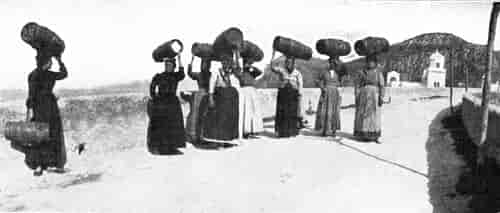 PEASANT GIRLS THEIR BURDENS BEAR.
PEASANT GIRLS THEIR BURDENS BEAR.On the avenues street peddlers besought us to purchase canes, matches, coral beads, and souvenirs cut out of lava, but asked prices four or five times their actual[Pg 368] value. On the narrow streets dealers in cooked viands for the home trade did an active business at low prices, but did not think it worth while to offer us the hot potatoes, maccaroni, fried fish, and stewed meats which they prepared on little sidewalk stoves.
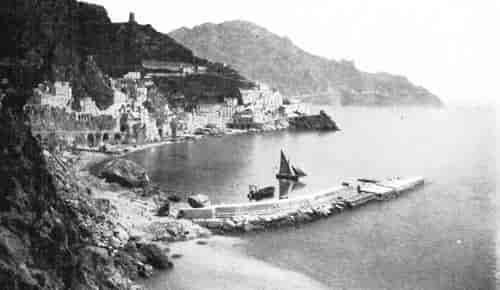 AMALFI, WHERE THE WAVES AND MOUNTAINS MEET.
AMALFI, WHERE THE WAVES AND MOUNTAINS MEET.The trip from Naples to Pompeii was made by rail in less than an hour. At the gates of the enclosure we each paid an admission fee of two lire, or forty cents, and official guides were assigned to conduct the party through the streets of the excavated city.
"About one hundred and fifty years ago," explained the guide, "a farmer ploughed up some objects of art in this locality. The government, hearing of the discovery, ordered investigation to be made. Removal of the soil disclosed a house and furniture and articles of value. The excavations, carried on irregularly for a century, then continued regularly but slowly for the past fifty years and still in progress, revealed the ancient city that had been smothered in ashes and buried from sight for eighteen hundred years. The wooden roofs, crushed in by the weight above them, had crumbled into dust, but the walls and columns, the altars and statues, the fountains and baths, the paved streets and mosaic pavements, and the frescoes on the walls had been preserved by the covering of ashes, and were in almost as good condition as when deserted by the terror-stricken inhabitants. All articles of value, as soon as found by the excavators, were carried away to the museums and carefully preserved; but the uncovered walls were left exposed to the weather, and, as you will see, are badly damaged and defaced. The government for the past few years, how[Pg 369]ever, has been protecting the newly excavated buildings by enclosing and roofing them over, and in these we shall find the beautiful Pompeian red and blue colors and the dainty frescoes well preserved on the walls."
 BEARING PANNIERS OF FRUITS AND VEGETABLES.
BEARING PANNIERS OF FRUITS AND VEGETABLES.This ancient city of probably only twenty-five thousand inhabitants had improvements that we now designate as modern. The streets, just wide enough for one wagon track with narrow footways on each side, were paved with square flat stones in which the chariots had cut deep wheel ruts. The public baths had separate rooms for men and women, exercise courts, sweating rooms, furnace heat, hot baths, cold baths, capacious marble plunge tanks, and cooling rooms in which the bathers, cleansed, oiled, and perfumed, could rest after[Pg 370] the bath. The water supply was distributed through the city in the same manner as in our own cities. Lead water pipes conducted the water through streets and into buildings. Bronze stopcocks governed the fountains, and bronze inlets and outlets regulated the supply at the marble baths.
"The Pompeian plumbers used good material and did good work," commented a manufacturer after examining the plumbing.
"If I could produce paints that would endure for centuries, and have them laid on as the Pompeian artists applied them, my fortune would soon be made," remarked another, who had been impressed particularly by the brightness of the red and blue on the walls of the House of Sallust. "But," he added, "the secret of making paint that will endure the ravages of time has been lost."
In a baker's shop we saw four small stone mills in which grain had been converted to flour by hand power, the stones having been revolved by means of long wooden handles. Near the mills was an oven similar to those of the present time.
"In this oven a number of loaves of bread were found," said the guide.
"Yes," answered one of our party, "we saw fourteen loaves in the Museum of Naples yesterday and were told that it was the oldest bread in existence. The loaves were well preserved in form but were as black as charcoal."
 MADE A PICTURE THAT PLEASED THE ARTIST.
MADE A PICTURE THAT PLEASED THE ARTIST.Our interest in Pompeii was heightened by our previously having visited the Naples Museum, where a[Pg 371] multitude of articles found during the excavations were on exhibition. There we had examined hundreds of objects of art, marble statues, bronze statues, mosaics, vases, frescoes, and paintings; we had seen thousands of ornaments for personal adornment, necklaces, cameos, bracelets, rings, chains, and toilet accessories and had looked at numberless articles for household use, such as stoves, lamps, dishes, and kitchen utensils. Even food was not lacking in the exhibition, being represented by olives in a jar, oil in bottles, charred walnuts, almonds, figs, wheat, and eggs. These things, abandoned by the fugitives in their wild flight, helped us to imagine the[Pg 372] taste and manner of living of the Pompeians before the destruction of their city.
"This is the Amphitheatre," said the guide, as we assembled around him in the arena of a large structure. "Here fights between wild beasts, gladiatorial combats, and other great spectacles took place. Underneath the seats on one side are the dens where the lions and tigers were kept in a starving condition to make them ferocious, and underneath on the other side are the dungeons where prisoners were confined until forced into the arena to meet the wild beasts. On the hill nearby are the barracks where the gladiators lived and trained for combats." An announcement of an oldtime entertainment remains inscribed on one of the stone walls. It reads as follows:
Twenty pairs of gladiators, at the expense of Decimus, a priest, and ten pairs of gladiators, at the expense of Lucretius, will fight at Pompeii on the eleventh of April. There will be a complete hunting scene, and the awnings will be spread.
Another inscription on the wall stated:
On the dedication of the baths, at the expense of Maius, there will be a hunt, athletic sports, showering of perfumes, etc., at the Amphitheatre.
"There was also a Tragic Theatre in Pompeii," continued the guide. "It was reserved for dramatic performances. The stone tiers seated an audience of five thousand. The Amphitheatre and the Tragic were open to the sky, but both were provided with awnings that could be spread above the seats to protect the people from the sun."[Pg 373]
 I. LATELY EXCAVATED ARE CAREFULLY PROTECTED.
I. LATELY EXCAVATED ARE CAREFULLY PROTECTED. II. PUBLIC BATHS WITH ARCADES.
II. PUBLIC BATHS WITH ARCADES.Almost all of us had read Bulwer-Lytton's novel, "The Last Days of Pompeii," and were familiar with his vivid description of the fearful eruption of Vesuvius which overwhelmed the city in the year A.D. 79,—the darkness, the terror of the people, the hasty flight, the roar of explosions, the volcanic lightnings, the scorching ashes, the sulphurous fumes, and the hot rain. Very interesting to us were the places described by Bulwer in his novel; the dwelling of the magistrate Pansa, the villa of the wealthy Diomede where eighteen skeletons surrounded by provisions and jewels had been found, the house of the poet Glaucus whose threshold was guarded by the mosaic of a chained dog with the now well known motto 'Cave Canem' or 'Beware of the Dog.' Most interesting, perhaps, was the Temple of Isis, in which the most exciting incidents of Bulwer's novel took place. There the guide showed us the altar, the well, the secret stairway, the platform from which the oracle spoke, and the spot where the skeleton of the priest with an ax was found.
"Broken columns and ruined walls are all that remain of the grandeur of the Forum," explained the guide as he led the way through a triumphal arch into a large area. "These extensive marble-paved floors were once decorated with statues of the illustrious men of Pompeii."
"The Forum was a bustling place," he continued, as we stood in the centre of the area. "In the open court the people met to exchange opinions and obtain the news. On the porticoes the money changers made loans and the brokers sold real estate and grain. It was the political center of the city. Here the magistrates[Pg 376] administered justice. Here the populace met with joyful acclamations to raise a favorite to power, and here, too, angry mobs gathered to compel an offending ruler to vacate his office. It was the religious centre as well; for adjoining the Forum are the ruins of the Temple of Mercury, the Temple of Venus, the Temple of Jupiter, and the Temple of Augustus."
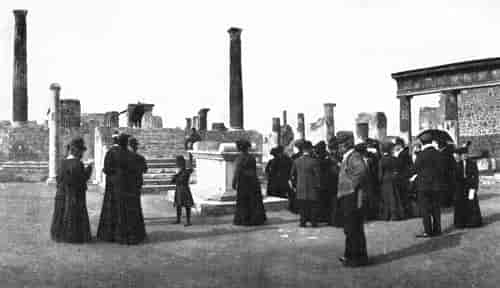 MOST INTERESTING, PERHAPS, IS THE TEMPLE OF ISIS.
MOST INTERESTING, PERHAPS, IS THE TEMPLE OF ISIS.When we were ready to leave Pompeii, after a tramp through other streets and a visit to the Museum, the subject of giving a fee to the guide was considered. At the gate when entering we had read a notice stating that guides furnished by the government were not permitted to accept fees from visitors. The guide assigned to us, however, had been very obliging and had given much interesting information. Appreciating this we slipped into his hand secretly at parting a token of our good will. "Gratia! Gratia!" very heartily he responded, assuring us that our gift, the forbidden, was acceptable.
After returning from Pompeii to our steamship we found that although the evening hours had arrived, the harbor was still a scene of animation. Scores of Italian stevedores were carrying baskets of coal on their shoulders from barges into the bunkers of the Moltke. Near by other laborers were hoisting crates of lemons and oranges and lowering them into the hold of an English steamer. A little rowboat with a stove on board was running a brisk restaurant business, selling bread, coffee, fried eggs, fried potatoes, and fried fish to boatmen and laborers, who managed to devour the viands without assistance of plate, knife, or fork.
Alongside our steamer a number of boys in a rowboat[Pg 377] were making a distracting noise with tin pans and crude instruments, looking up in the hope that some one would pay them for creating a disturbance. In another boat, gaily attired Neapolitan musicians played and sang popular airs in a pleasing way that drew coins from the pockets of the hearers. At the close of each piece of music one of the women held a spread umbrella upside down to catch the coppers that were dropped into it from the deck thirty feet above.
"The daylight ends too soon," regretfully observed one of our party, an artist of considerable reputation, who, seated in his favorite nook near the stern, was endeavoring to complete his color notes and sketches of the picturesque scenes before the darkness hid them from view. "But the sky above the mountain is reddening and the glow of Vesuvius will give me work for to-night."[Pg 378]
CHAPTER XVII.
NICE AND MENTONE.
Throughout the cruise to the Orient, up to the time of departure from Naples, our party of tourists had the great steamer to themselves, there being no other passengers on board. At Naples, however, a change took place. As the Steamship Company granted us the privilege of remaining over in Europe and returning later in the season in some other steamer of the same line, a large number of the tourists left the Moltke at Naples for side trips on the Continent, and many more intended to leave at Nice; so that not more than one-fourth of the original number was booked to return direct from Nice to New York. During the time our steamer lay at Naples a cargo of freight was taken on board, and on the day of departure one thousand steerage passengers ascended the gangway, some with valises of curious shape, a few dragging trunks, but the greater number with all their possessions in bags or bundles.
At ten o'clock on the night of March thirtieth, we stood at the rail watching the lights on the shore gradually disappearing from sight as the Moltke steamed away from the harbor.
"What must be the thoughts of these Neapolitan exiles as they sail away from 'Sunny Italy,' their place of birth, their homeland, and their friends?" mused my[Pg 379] friend, referring to the emigrants gazing farewell to their native land.
 MANY CLOTHES-LINES WERE FILLED.
MANY CLOTHES-LINES WERE FILLED."There is sadness in their hearts, for their faces and attitudes show it," said he, answering his own question. "Some of the women are shedding tears. But they are all hopeful. They have heard that in the promised land there is plenty of work, high wages, enough to eat, and, what is far better, opportunity to rise. In Italy there is scarcity of work, low wages, a chunk of black bread, and nothing better to look forward to in the future."[Pg 380]
"You are right, young man, there is something to look forward to in America, an opportunity to rise in the world," said a fellow tourist, well known as a man of wealth and distinction. "I can sympathize with these poor people who are seeking to better their condition. Thirty years ago I was a poor man, leaving Europe in the steerage as an emigrant to the land of promise. I worked my way to the West, became a miner, and met with success."
"To reach America appears to be the desire of many in Italy," remarked another. "In the elevator of one of the hotels in Naples I found the elevator boy studying an English spelling book. He said, 'I am going to America as soon as I have money enough; there is a chance for me to become something if I can get to New York.' A cab driver asked me if I knew his cousin in Chicago. 'My cousin,' said he, 'saved enough money to buy a third-class passage to New York. That was just three years ago. Now he is sending money home to his friends to take them over. He must be doing well. We never have any money to give away.' Money to spare for his friends! That told the cabman the story of a golden land."
On Tuesday, as we sailed northward, we passed the island of Elba, on which the banished Napoleon remained ten months after his abdication. We endeavored to recall the history of the events that preceded the great Emperor's first downfall; the campaign in Russia, the burning of Moscow, the winter retreat, the depletion of the grand army by frost and hunger. But when the little island of Monte Cristo came in sight,[Pg 381] memory brought to mind pleasanter recollections,—Dumas' story of the "The Count of Monte Cristo," so wonderful in our youthful days, Edmond Dantes' escape from the dungeon, the cave on the island, and the fabulous wealth concealed therein.
On the day of arrival at Nice, hundreds of owners of automobiles from all parts of Europe were assembled in that city for trials of speed; the morning races had taken place and the dust-covered racers were just coming in from their fast runs. On the way to the hotel we saw an automobile run over one man and knock another down. An excited French woman who was rolled over in the dust but not injured followed the offending car to the garage with tongue, hands, and arms all in rapid motion. She was giving the chauffeur a tongue-lashing and calling his attention to her soiled clothing. Her tirade prompted the chauffeur to draw some coins from his pocket and place them in her hand, and then her hurt feelings apparently were quickly relieved.
Nice has a delightful climate. It is protected from the cold winds of the north by hills and mountains and fanned by the mild breezes of the sea. Royalty, beauty, and wealth make their abode in this favorite resort on the shore of the Mediterranean during the winter season, and English lords, French counts, Russian princes, German barons, and American millionaires sojourn at the magnificent hotels or reside in beautiful villas.
The season of gaiety was just closing when we arrived and the hotels were not crowded, yet there was much to see. It was a pleasure to drive on the clean, well-[Pg 382]paved avenues, which are shaded by great trees and lined with handsome homes and white stone hotels, passing lawns and gardens filled with palms, roses, choice flowers, and blooming vines. It was interesting to stroll along the sea front for two or three miles on a stone pavement fifty feet wide, the popular promenade of the city, with the waves of the blue sea rolling almost to your feet on one side and the wide avenue filled with handsome teams and motor-cars of every description on the other. It was entertaining to secure a chair in the park during the afternoon concert, and, comfortably seated, listen to the military band, admire the gowns of the French women, and note the variety of uniforms worn by the French officers. Those afternoons in the park were very restful for there was no hurry nor confusion nor crying of wares for sale, and the balmy sea breeze had a soothing effect on the nerves.
The weather was delightful and the air pure and clear when, on the morning of April fourth, a party of sixteen filled the seats of a four-horse drag for a drive from Nice to Mentone over the famous Corniche road, a round trip of over forty miles, noted as one of the finest drives in Europe. We had decided to go to Mentone over the Upper Corniche road, which winds among the mountains, and return by the Lower Corniche road, which follows the shores of the sea.
Our driver snapped his long-lashed whip and the horses started off as gaily as if they shared our exuberant spirits.
"That is the river Paillon," said the driver, pointing to a diminutive stream in the midst of a wide stony bed.[Pg 384] "The river has very little water in it now, but when the snow melts in the mountains it becomes a torrent."
 I. WINDS AMONG THE MOUNTAINS.
I. WINDS AMONG THE MOUNTAINS. II. FOLLOWS THE SHORE OF THE SEA.
II. FOLLOWS THE SHORE OF THE SEA.The little stream had a peaceful look. Many washer-women were busily at work along its banks, many clothes lines were filled with drying garments, and sheets were bleaching on the stones. A number of red objects in the distance proved, as we drew nearer, to be a company of red-trousered French soldiers washing their linen in the stream. Another company in red trousers and white shirts marched by us, carrying their bundles to the river. After leaving the river we passed an immense public wash trough where forty women were washing clothes and apparently having a social time. There was room at the trough for double that number.
The macadamized road winding up the mountain side in easy grades, supported at many places by walls of substantial masonry, was in perfect condition. Occasionally as our team moved slowly upward we heard the "honk, honk" of a horn and a racing automobile making a time record flew swiftly by and was soon out of sight, or rushing down grade around sharp curves at tremendous speed toward us caused some hearts in our coach to palpitate in anxiety until the racer had safely passed.
"At this spot a Russian Count and his friend were killed on the morning of the races," said our driver as we rounded one particularly sharp curve. "The count, expecting to be a winner in the race, was speeding his motor-car at the rate of fifty miles an hour, when it swerved against the rocks and he and his friend were hurled over the wall and crushed to death."[Pg 385]
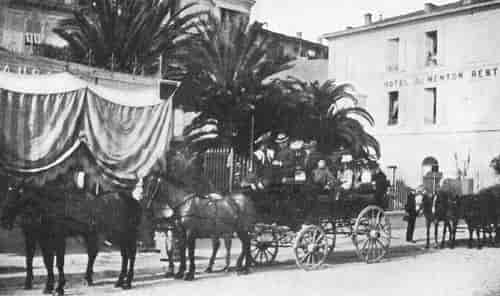 WE LUNCHED IN MENTONE.
WE LUNCHED IN MENTONE.As we ascended the mountains we saw on the slopes below us orchards of gray olive trees, in the valleys orchards of dark green orange and lemon trees filled with yellow fruit, clean looking white or yellow or pink houses with red tile roofs dotting the landscape, and the white stone Hotel Regina, beautiful for situation, standing prominent on a summit. The rocks in the channel of the Paillon appeared to be a bed of pebbles. In the distance, to the south, could be seen the buildings of the city we had left and the glistening waters of the sea beyond; on the north, wooded hills and terraced mountains; and far away, the snow covered summits of the Alps. While we gazed at one of these scenes of beauty, the soft mellow tones of a convent bell came pleasingly to our ears.
"Why is it the bells ring so sweetly here?" inquired one of the occupants of our coach. "It must have been melodious notes like these that pleased the ear of the poet Moore."
At each turn of the road our point of view changed and the panorama unrolled before us. We looked down upon a series of beautiful pictures. The Mediterranean lay two thousand feet below us, its surface reflecting every shade of blue and green, its coast a succession of inlets, bays, promontories, and peninsulas. White roads winding among the shrubbery on the peninsulas looked like white ribbons on a green background, the red tiled houses like little toys, and the harbor of Ville Franche like a pond on which floated tiny boats that a child might play with.
"What a picturesque town!" exclaimed a tourist.[Pg 387]
"That is the city of Eze. It is a very old city," said the driver.
"Perched among the mountains, with its odd castle on a detached hill top," said one of the tourists "it reminds me of a painting by one of the old masters. Cimabue, I think, or Perugino. I cannot remember which. I am constantly regretting while traveling abroad that we are not more proficient in history and art. While the professor and the artist were with the party we could turn to them for information. But now we must depend upon ourselves."
"Not necessarily," replied another, "for we have Baedeker and the guides; and there are the drivers, too, to call upon when they can understand our English or we can understand their French."
For some distance beyond Eze the road followed the side of rugged limestone cliffs surmounted by fortifications and signal stations. At the old, queer-looking town of La Turbie, while the horses rested for an hour, we selected postal cards and took kodak views. Soon after leaving La Turbie, while descending the mountain, we looked down upon the little principality of Monaco, its capital, the city of Monaco, the palace of the Prince built upon a rocky promontory, and the white buildings of Monte Carlo.
Mentone is a popular winter resort on the Mediterranean with handsome houses and flower-filled gardens. Vineyards and groves of orange, lemon, and fig trees, cover the hillsides surrounding the city. We lunched in Mentone, and were entertained under the palm trees of the hotel garden by a band of Italian musicians, one[Pg 388] of whom, an amusing character actor as well as singer, responded cheerfully to our requests for special selections and solos.
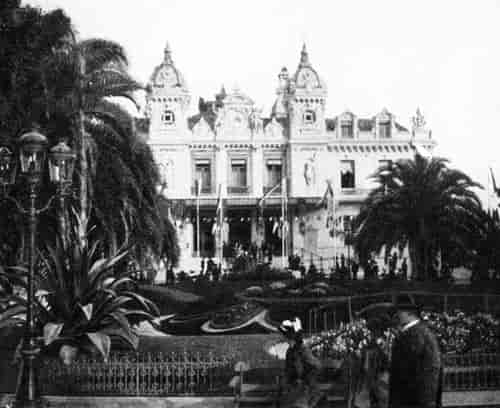 THROUGH THE PARK THAT SURROUNDS THE CASINO.
THROUGH THE PARK THAT SURROUNDS THE CASINO.Our return from Mentone to Nice was through a succession of towns and villages. Along this coast road are many white hotels, comfortable-looking villas, and trimly kept lawns. In the gardens there were century plants, orange, lemon, and palm trees, and rose bushes of great size covered with bloom. On the tops of the garden walls, plants of various kinds were growing. Some of the walls were covered with long clusters of[Pg 389] pink geraniums, some gracefully festooned with masses of overhanging heliotrope, and others draped with trailing vines aglow with scarlet bloom. The exuberant growth and bloom of these flowers attracted much attention and drew forth exclamations of delight.
"Did you ever see geraniums and heliotropes growing in such luxuriance?" asked one of the ladies.
"Only in my own state," replied a Californian. "There the plants grow to immense size and bloom in profusion."
"Do not forget charming Funchal," said another. "Remember that there we saw geraniums and fuschias of wonderful size, and vines of pink bouguainvillia that covered the mountain-side cottages."
At Monte Carlo, as we drove through the park that surrounds the white marble gambling palace, we admired the magnificent parterres of flowers, the beds of pansies being especially beautiful in variety of color and size of the flowers. On the piazza of the Café de Paris, where a band was playing, we had afternoon tea and from there watched the throng of visitors who were moving along the palm-lined paths or were ascending or descending the marble steps of the Casino.
"Is there a charge for admittance?" we inquired of the guard at the entrance of the white palace.
"No," he replied. "Present your visiting card at the desk of the Secretary in the corridor. He will approve. Then, after you have registered your name, a card of admission will be given you."
In the decorated rooms where the games of chance were in operation, many handsomely gowned women and[Pg 390] well-dressed men were moving from place to place conversing in quiet tones, but crowds were centered around the roulette tables, where the chairs were all occupied and many people were standing. We joined the throng around one of these and saw that the table was divided into numbered spaces, some colored red and some black. In the centre of the table was a little wheel with spaces to correspond in number and color to those on the table. The stakes were silver five franc pieces, one or more. No other coins nor bills were permitted on the table.
"I will try it," said one of our party after watching the game awhile. "I will place a five franc on number seven black."
The table was dotted with silver coins. The croupier touched a spring that sent a small ball spinning around the wheel. The ball stopped in space three red.
"Three red wins," announced the croupier.
A woman with gray hair and large diamonds in her ears picked up her winnings and added them to the stack of silver on the table in front of her, and the croupiers with wooden rakes raked in scores of coins that had been laid on losing numbers.
At some of the tables in the magnificent apartments of the Casino the stakes were higher, twenty franc gold pieces being used, and at these tables, eager players, infatuated with the game, hazarded handfuls of gold on the turn of the wheel.
"The chances to win or lose appear to be about even," said the Californian. "They must, however, be in favor of the Casino; for the company requires a large income to meet the enormous expenses incurred in[Pg 392] keeping up this handsome palace and grounds with thousands of employees, croupiers, guards, gardeners, and care-takers. In addition, the company pays a heavy tax to the Prince of Monaco, and yet is said to have large profit."
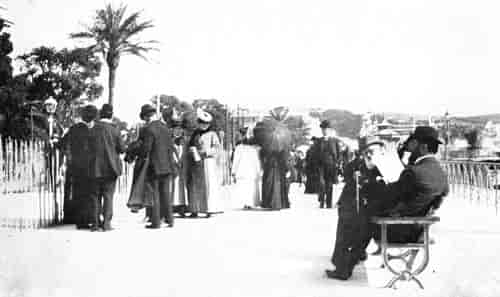 THE POPULAR PROMENADE OF THE CITY.
THE POPULAR PROMENADE OF THE CITY.When our coach arrived at the hotel in Nice some one remarked: "You appear to be enthusiastic over your drive." We were; there was no doubt about it, and we might well have added that we were just as well pleased with the whole trip to the Orient. We started with great expectations and we were not disappointed.
At Nice, when the Moltke sailed for New York, we parted with feelings of regret from many pleasant friends and companions whose acquaintance we had made during the trip, and with whom we had been agreeably associated on sea and on land.

